








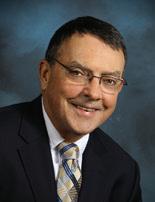
As happens at this time of year, there’s a changing of the guard as Tony D’Errico takes the president’s reins of the Club Managers Association of America for 2015.
D’Errico got his start in the business early, at age 26. Storytelling often presages what might be expected. However, it often isn’t enough to deter general managers who dedicate their careers to serving private club members.
“I’ll never forget my first day on the job, meeting my very first club member – a snarky fellow right out of central casting, who looked like Jackie Gleason in the Hustler,” D’Errico recalled recently.
“With a cigarette dangling from his mouth and gesturing toward the other members, he said, ‘Good luck keeping all these (bleeping expletives) happy.’ Welcome to club management!”
Well, it has been an engaging time for D’Errico, who along with his commitment as CMAA’s president is also general manager/chief operating officer of Westwood Country Club in St. Louis, MO, where he’s been since 1999.
One of the big items on D’Errico’s ‘to do’ list focuses on broadening the reach of the CMAA’s hallmark designation – the Certified Club Managers (CCM). As well, it’ll be a year of working with the CMAA’s new chief executive officer Jeff Morgan, as he assimilates to his new duties. Yes, an interesting and exciting year for the CMAA.
hazard) to others, so much so that various levels of government are placing increasingly tight restrictions on their use.
So, can drones make life easier in the private club industry? Wolfe thinks they might, and bases his discussion on the experiences of a Singapore company – Infinium-Serve. The company offers a service touted as “the only fully autonomous and smart flying robotics servers in restaurants and F&B outlets.” (www.infiniumrobotics.com).
Hmmm…how will that fit into the private club community? Ah, so many questions looking for answers. For more, read Frank’s offering.
HFTP’s CEO Frank Wolfe, in his contribution this issue, raises a most interesting discussion about drones and the club industry. As a population we’re becoming more and more familiar with all kinds of drones…for both good and bad reasons.
Yes, they’re a big deal with the military, they’ve been a flying hobby for many, and Amazon is having some success in making deliveries. Yet they’ve become a nuisance (or
This issue we also recognize our BoardRoom Award recipients and our Lifetime Achievers. BoardRoom Awards are presented annually to the private club industry’s vendors…the only awards of its kind, and the presentations this year happened on the red carpet at BoardRoom’s booth at the CMAA’s annual World Conference in San Antonio.
BoardRoom’s Lifetime Achievement Awards this year go to three of the industry’s most deserving people – George and Linda Carroll, both of whom retired recently as private club general managers and Henry DeLozier of Global Golf Advisors. The story about the Carrolls, written by friend and colleague Jim Singerling appears in this issue. DeLozier’s exploits will be featured in our May/June issue.
And finally, we continue with our series on BoardRoom’s top presidents with stories about: Beau Anders, president, The Landings Club, Savannah, GA; Joseph J. Buska, president, Interlachen Country Club, Edina, MN; Bernie Carballo, president, The Club at Admirals Cove, Jupiter, FL; and Jim Diepenbrock, chair, St. Francis Yacht Club, San Francisco, CA. BR
Got a comment?
Drop us a note: dave@boardroommag.com
Publisher/CEO
John G. Fornaro
Editor/Co-Publisher
Dave White
Associate Editor/Creative Director/Co-Publisher
Heather Arias de Cordoba
APCD Executive Director
Bill Thomas
Editorial & Marketing Director
Dee Kaplan
Account Manager
Dina Alleluia-Carr
Website and Subscriptions
Joshua Nuzzi
Contact Information
www.BoardRoomMagazine.com | www.apcd.com (949) 376-8889 or (949) 365-6966
Subscriptions
www.BoardRoomMagazine.com (949) 376-8889
Featured Columnists
Henry Delozier
John G. Fornaro
Bonnie J. Knutson
Contributing Writers
Bob Bodman
Chris Boettcher
Bill Boothe
Lisa Carroll
JaeMin Cha
Ronald F. Cichy
Donna Coyne
Michael Crandal
Dave Doherty
John Embree
Steve Graves
Larry Hirsh
Kyle Jennings




Kopplin
Jerry Kilby MiRan Kim
SeungHyun (James) Kim
David W. Lacey
Lynne LaFond DeLuca
Macdonald Niven
Michael Phelps
Whitney Reid
Bruce Reimann
Jim Singerling
Michelle Tanzer
Bruce R. Williams










PUBLISHER’S PERSPECTIVE | 10

BY JOHN G. FORNARO
There are lessons we learn from people we know and love…ideas and thoughts that motivate us, that inspire us and that become totally relevant in our everyday lives. This is my story of one life lesson and my friend Marco Abdi. HFTP| 12
GLOBAL PERSPECTIVES | 16

STRATEGY, GOVERNANCE EQUALLY IMPORTANT
BY HENRY DELOZIER
Which is more important, strategy or governance? That’s a question often asked by club leaders. My answer: neither is more important. To perform at their best, to provide members the experience and the value they expect, private clubs require both.

A NEW CONGRESS AND AN AGGRESSIVE REGULATORY AGENDA
BY MELISSA LOW
With the change in power in the Senate, a new session of Congress and a group of newly-elected Congressmen, Washington, DC, is a different place. Notice, the choice of words, it is not a more productive place.

BY FRANK WOLFE
Over the last year, drones have migrated into hospitality. One company based in Singapore, developed the InfiniumServe…touted as “the only fully autonomous and smart flying robotics servers in restaurants and F&B outlets.”
PLIGHTS AND INSIGHTS | 18

BY
NANCY LEVENBURG
In what may seem to be a completely unrelated subject (but please, bear with me), I’ve been doing research on food trucks and food carts for the benefit of my culinaryschooled son and daughter-in-law. They are contemplating starting a food cart or food truck business where they live. Have you experienced a food truck or cart?
CLUB FACTS & FIGURES| 80


BY BOB SALMORE & PHILIP NEWMAN
Boards, finance committees and chief operating officers all have much greater expectations today regarding the quality and timeliness of the financial information they are being given to lead and manage the club.
BOARDROOM BASICS & BEYOND| 14

BY DICK KOPPLIN
In traveling the country and visiting the dozens of clubs that my partner, Kurt Kuebler and I do every year, we have observed that the most successful general manager/ COOs typically engage their board members with five effective strategies.

YOU NEED THAT ROUND PEG FOR YOUR CLUB’S SQUARE HOLE BY
BONNIE J. KNUTSON
If you go back in history, lagniappe entered our lexicon from Louisiana French and Spanish phrases that meant a free item, usually cheap. Throughout the years, it has come to mean “a small gift given to a customer by a merchant at the time of a purchase…an unexpected...benefit.” The operative words here are cheap and unexpected.

BY GREGG PATTERSON
Annual meetings are always a hoot – our “once-a-year” opportunity for the board and management team to inform the membership and illuminate the issues, to explain a few of the “whys” and “why nots”, to commiserate and to celebrate, to count our blessings and to heal our wounds, to align expectations and to prime ourselves for the future; and to enjoy free food and booze once the yakking’s done.
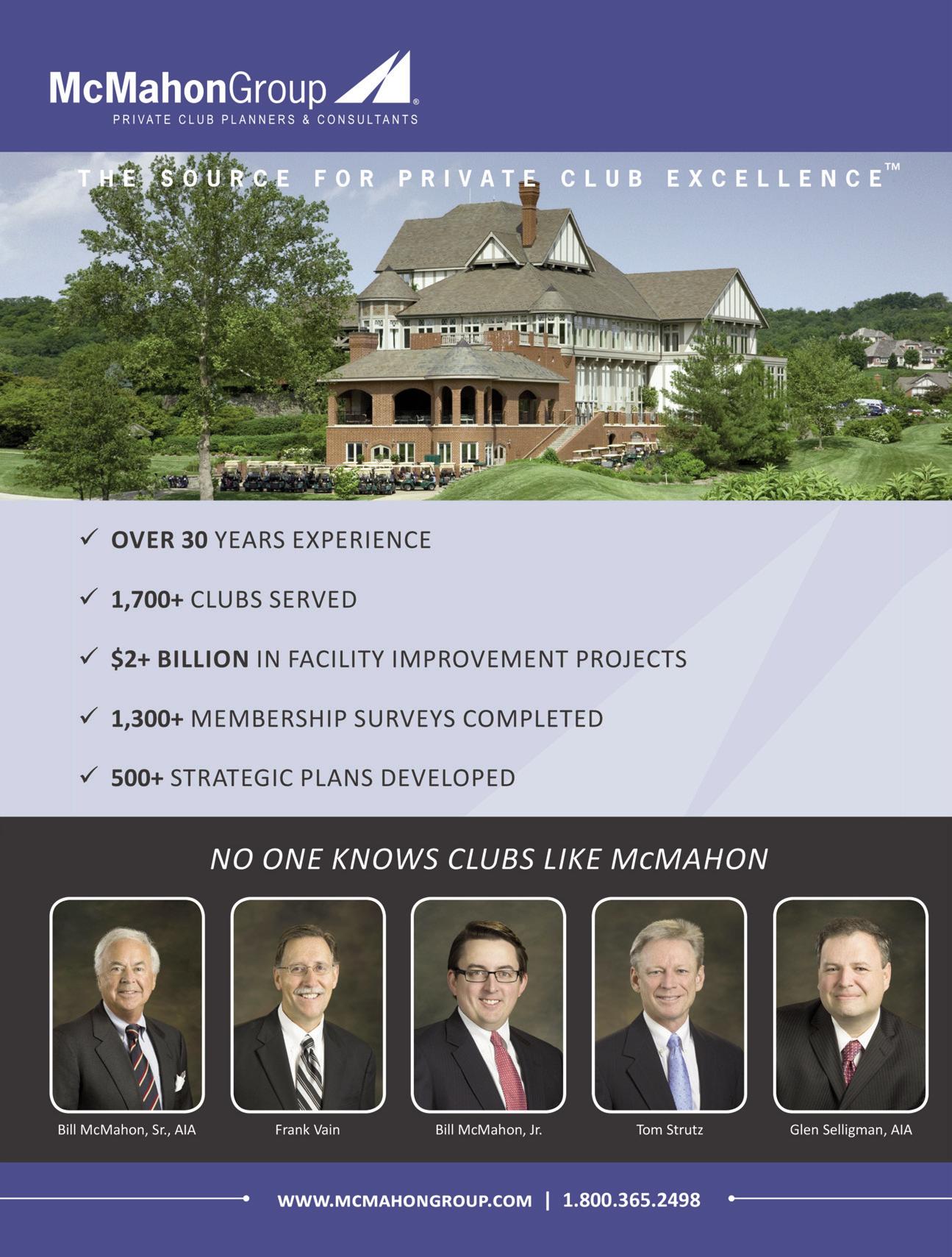
Physical Properties Testing Provides Answers 99 By Dave Doherty Is Golf on the Rebound?,
100 By
Bruce R. Williams
Which Capital Project Will Sell More Memberships?
By Bob Bodman
What to Look for When Hiring
A Membership Professional


96
97 By Donna Coyne
Creative Golf Marketing
Ferry, Hayes & Allen Designers
Kinon
Barcode Automation, Inc.


46 & 47
48 & 49
50 & 51
76


Michael Crandal,
Packaged Wine Sales for Off-Premises Consumption By Michelle Tanzer HUMAN
to Create Work/Life Balance By David W. Lacey
BOARDROOM SPECIAL.
Linda and George Carroll Recognized with BoardRoom’s 2014 Lifetime Achievement Award By Jim Singerling
CLUB MANAGEMENT
Private Club Volunteer Leaders Work in Collaboration with GMs/COOsPart II
By Ronald F. Cichy, SeungHyun (James) Kim, JaeMin Cha, MiRan Kim CLUB
Larry Hirsh
Lynne LaFond DeLuca
Solving Golf’s Problems Three Dos And Three Don’ts By Jerry Kilby
Modernizing Membership Marketing By Michael Phelps
Sarasota Yacht Club’s Ensign Board Creates Youth-friendly Ideas and Opportunities
Select Team Entices Top Junior Golfers
Not My Section… By
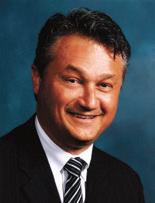
There are lessons we learn from people we know and love…ideas and thoughts that motivate us, that inspire us and that become totally relevant in our everyday lives. This is my story of one life lesson and my friend Marco Abdi.
In my lifetime many people have influenced me…my thoughts, my likes, dislikes, as has happened with all of us. They have influenced not only my writing but also other BoardRoom ventures such as the Distinguished Clubs of the World program from BoardRoom magazine.
Often we can point to one particular person who has had a greater influence, and often we don’t realize it until after their death. For me, that’s been the death of one of my best
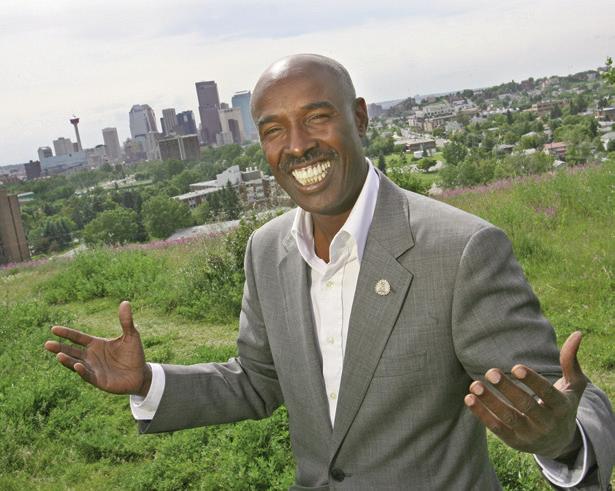
friends…a friend for more than 30 years. His recent death has given me pause to stop and think about why he had so much influence on my life.
My friend Marco Abdi died February 15 at the age of 59…three and half weeks after he was diagnosed with stage four lung cancer.
As many of you know, I arrived in California many years ago from Calgary, Alberta –Canada’s oil capital.
Ihad met my friend, Marco, affectionately known as the Italian-Somalian, in Calgary. He left his home of humble beginnings in Somalia in the late 1970s to work in Rome, Italy as a caretaker in a restaurant. Later in 1980, Adbi made his way to Calgary and worked as a janitor in a professional medical building. At that time, he was making $800 a month and thought “it a big deal.”
Marco had greater ambitions. Across the street from where he worked sat a small house, in an area of Calgary that has continually faced redevelopment. Marco set his eyes on that building, and when finally able to get his hands on it, Marco opened an Italian restaurant, La Brezza, an enticing establishment he owned and operated for 30 years.
An Italian restaurant?? Well, Marco’s wife, Filomena, comes from an Italian family. That’s part of the story. Convincing Filomena’s dad that he’d be the right suitor for his daughter was quite another. As it has turned out, many of La Brezza’s recipes over the years came from Filamena‘s mom, who also helped as a chef.
La Brezza consistently has been rated as one of the best restaurants in Canada. Customers have included politicians, Diana Ross, Rod Stewart, famous and popular athletes, and hundreds of other entertainers and prominent people from all over the world who happen by Calgary.
Marco, during his early travels, lived off and on in the United Arab Emirates, before settling in Calgary.Marco’s death gives me pause for reflection. Whenever I met Marco, during our many visits at his restaurants, when we social-

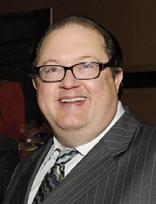
The club president and her friends are out of beverages on the 12th hole tee box.
A corporate foursome of hackers has just finished playing your beautiful (and extremely hard) water hazard hole and has ran out of golf balls. And your events services manager is trying to convince the wealthiest member of the club that there is plenty of room around the swimming pool to host his upcoming birthday party.
Other than being the type of problems that you deal with most days at the club, what do all these things have in common? They all have the potential of being solved with a relatively inexpensive piece of technology…a drone.
The word drone doesn’t sound exactly like something intelligent, but in fact, most are exceptionally sophisticated. Basically, a drone is a flying robot that, using software and embedded systems using GPS can fly by themselves or via remote control. They have many uses, but until most recently, have been used for things like weather, search and rescue, military applications and even traffic monitoring.
Over the last year, drones have migrated into hospitality. One company based in Singapore, developed the Infinium-Serve…touted as “the only fully autonomous and smart flying robotics servers in restaurants and F&B outlets.” (www.infiniumrobotics.com).
It comes with a special intelligence that avoids collisions and is already in use in commercial operations. It has been introduced with lots of fanfare and was recently used at an event to serve Singapore’s Prime Minister Lee Hisen Loong. So can a drone deliver drinks to a tee box? Sure it can.
Amazon.com is already making deliveries with drones with limited success. So there is no reason why a modified drone could not deliver a dozen golf balls to that corporate foursome over at the water hazard hole.
There are already “off the shelf” drones outfitted with rugged cameras that a consumer can
purchase. These drones operate up to 1,000 feet and can simultaneously record and send a live feed to a tablet below. So not only can your events services manager show all the room around the pool for the birthday party, it can also be viewed later as a reference.
Like most new technology, drones enter the industry with some distinct advantages and risks. For now, they are new and can generate some buzz among your members. They can “increase serving space” by flying close to the ceiling in small serving areas, they don’t need VISAS, and they don’t take breaks.
As far as risks go, there have been incidents where piloted drones have injured customers. The environment can impact them adversely; piloted drones can be difficult to fly, and flying golf balls can destroy them.
For now it is too early to tell if drones will make a major impact to the club industry. If you or your company has an interest in the topic, drones in hospitality and also robotics are going to be addressed at HITEC 2015 produced by Hospitality Financial and Technology Professionals. Perhaps visitors will get to experience them first hand? BR
Frank Wolfe, CAE joined the Hospitality Financial and Technology Professionals (HFTP®) in March 1991 as the association’s director of education. He became executive vice president/CEO of HFTP in 1994 and at that time was one of the youngest association CEOs in North America. As HFTP’s CEO, Wolfe oversees the association’s operations, as well as represents the association worldwide at industry events, on industry boards and committees and via the news media.
As the spokesperson for HFTP, Wolfe frequently speaks on hospitality finance, technology, social media and travel issues to varied audiences and has presented in more than 20 countries.

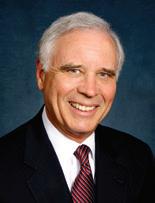
Recently while rereading one of the all-time classics in business literature, How to Win Friends and Influence People by Dale Carnegie, one of his comments seemed particularly appropriate for club general manager/COOs and their relationships with their board members.
Carnegie comments that successful leaders in an organization are very effective in “getting things done with and through other people.”
In traveling the country and visiting the dozens of clubs that my partner, Kurt Kuebler and I do every year, we have observed that the most successful general manager/ COOs typically engage their board members with five effective strategies.
First, they conduct a very complete and thorough new board member orientation process for each new board member. This is golden opportunity to share a “behind the scenes” look at how the club actually operates.
The orientation begins with an introduction to each department manager who is then given time to share with the new board members how they operate their particular area in the club.
The board members have an opportunity to engage with the department manager and truly understand how they function on a daily basis.
Additionally, the board members can view the assets of the club as each manager is touring them through their department.
Second, they visit every club president at their place of business. If the GM/COO is managing a community with a population of retired members they can visit the club president as their home. The key to this strategy is to change the dynamic of the relationship by having a meaningful conversation “away from the club.”
I don’t know why this strategy is so effective but something occurs in this process that allows both parties to have a better understanding and appreciation of how they can work together effectively.
Third, they assist every board member with their chairing of a club committee.
The general manager/COO will discuss with the committee chair (board member) how they (the GM/COO) will review the minutes for each
meeting and those minutes will form the basis for the next month’s agenda. The two of them can then review any action items that will need to move onto the board agenda for discussion and approval.
Successful club executives understand the importance of this dynamic and provide leadership and support for the board member in their duties as committee chair.
Fourth, they tap into the expertise, knowledge and experience of each board member. The very best general manager/COOs have come to realize that they have a wonderful ‘master mind group’ sitting around the board table and they can draw upon all of that experience to help them manage and lead the club.
The concept that Carnegie describes of “getting things done with and through other people” begins with the realization on the part of the general manager/COO that the club board is comprised of individuals who will willingly lend their time and expertise if they are asked.
Fifth, they readily give credit to the board members for their contributions. Successful general manager/COOs understand that their role includes recognizing board members and also committee members, for their voluntary efforts to improve club operations. They readily recognize and appreciate the work of board members to contribute to the success of the club.
The concept of “getting things done with and through other people” has been a golden rule of successful executive leadership ever since Dale Carnegie identified this concept as a central theme of his book.
The very best general manager/COOs have adapted that concept and have engaged these strategies to achieve great results with their board members year after year. BR
Dick Kopplin is a partner in Kopplin & Kuebler, LLC an executive recruiting firm providing services to the private club industry. The company has offices in Scottsdale, Arizona and Jupiter, Florida. He can be contacted at (480) 443-9102 or at www.kopplinandkuebler.com


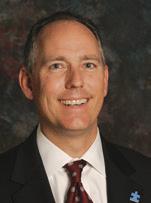



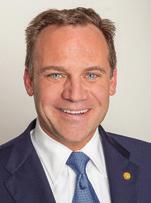
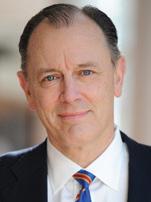
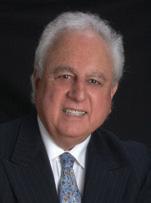



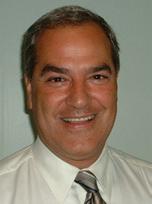



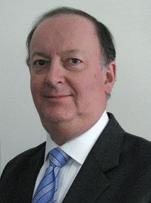
These top executives have taken their clubs to a higher level by implementing a better approach for managing club food and beverage departments. Building on a foundation of best practices, checks and balances, and integrated business flows, they incorporated leading-edge food and beverage automation and reduced labor by tying all their systems together.
The controls, disciplines and reports produced by this approach make it possible to run food and beverage departments at peak efficiency, substantially reducing clerical labor and food costs. Innovation. A better way to do business Just what you would expect from leaders at this level.


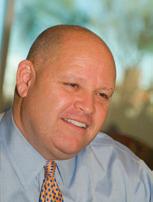
Which is more important, strategy or governance?
That’s a question often asked by club leaders. My answer: neither is more important.
To perform at their best, to provide members the experience and the value they expect, private clubs require both – visionary strategy and principle-based governance. One sustains the other.
Fred Laughlin, who developed the governance model for the Club Managers Association of America, puts it this way: “Governance and strategic planning are primary responsibilities of the board. The former is to exercise authority and responsibility; the latter is to help boards lead successfully. Neither can be short-changed without risking the long-term health of the club.”

Many clubs go through the strategic planning process only to let the plan languish and gather dust on the gM’s credenza. To keep strategic goals front and center, make a ‘goals update’ a standard agenda item at each board meeting. The update should include a report from management that reviews implementation and measurement.
Research from the National Golf Foundation bears out the relationship between strategic planning and financial health. When the NGF asked U.S. private clubs in a 2014 survey to rate their financial status as “healthy,” “moderate” or “at risk,” 73 percent of clubs that considered themselves healthy had a formal strategic plan in place. Of the clubs that considered themselves “at risk,” only half said they relied on a strategic plan to guide decision-making and actions.
Those percentages certainly favor strategic planning. But if you’re currently operating without such a plan, how should you get started? The first step is for the board to start to think
strategically. Here are questions strategic thinkers ask themselves:
• What should our club be?
• How does it – or did it – become the club that it is?
• If it should be something different, what could it be?
• What actions must this board take to ensure the club’s long-term health?
Each question deserves considerable thought and above all honesty. That’s why most clubs use a professional facilitator – someone who is detached from club history, culture and personalities – to guide the strategic planning process. A professional facilitator will lead a disciplined approach to help the club take a long-term view to the planning process, identifying desired outcomes and quantifying resources that reveal multiple strategic options.
The desired outcomes of a thoughtful strategic planning process are clearly stated goals and objectives, which aligns the process with the primary duties of the board. The best goal setting results in what we call “SMART” objectives: Specific, measurable, achievable, realistic and timely.
The board should then refer the strategic goals to the management team that has responsibility for identifying the actions that will achieve the goals called for in the plan. Many clubs go through the strategic planning process only to let the plan languish and gather dust on the GM’s credenza.
To keep strategic goals front and center, make a ‘goals update’ a standard agenda item at each board meeting. The update should include a report from management that reviews implementation and measurement.
Laughlin points out that responsible governance relies on sound strategy to guide board members in their pursuit of primary fiduciary duties of nonprofit directors. Club directors abdicate these duties when they advance a personal agenda, obstruct beneficial outcomes or engage in con-
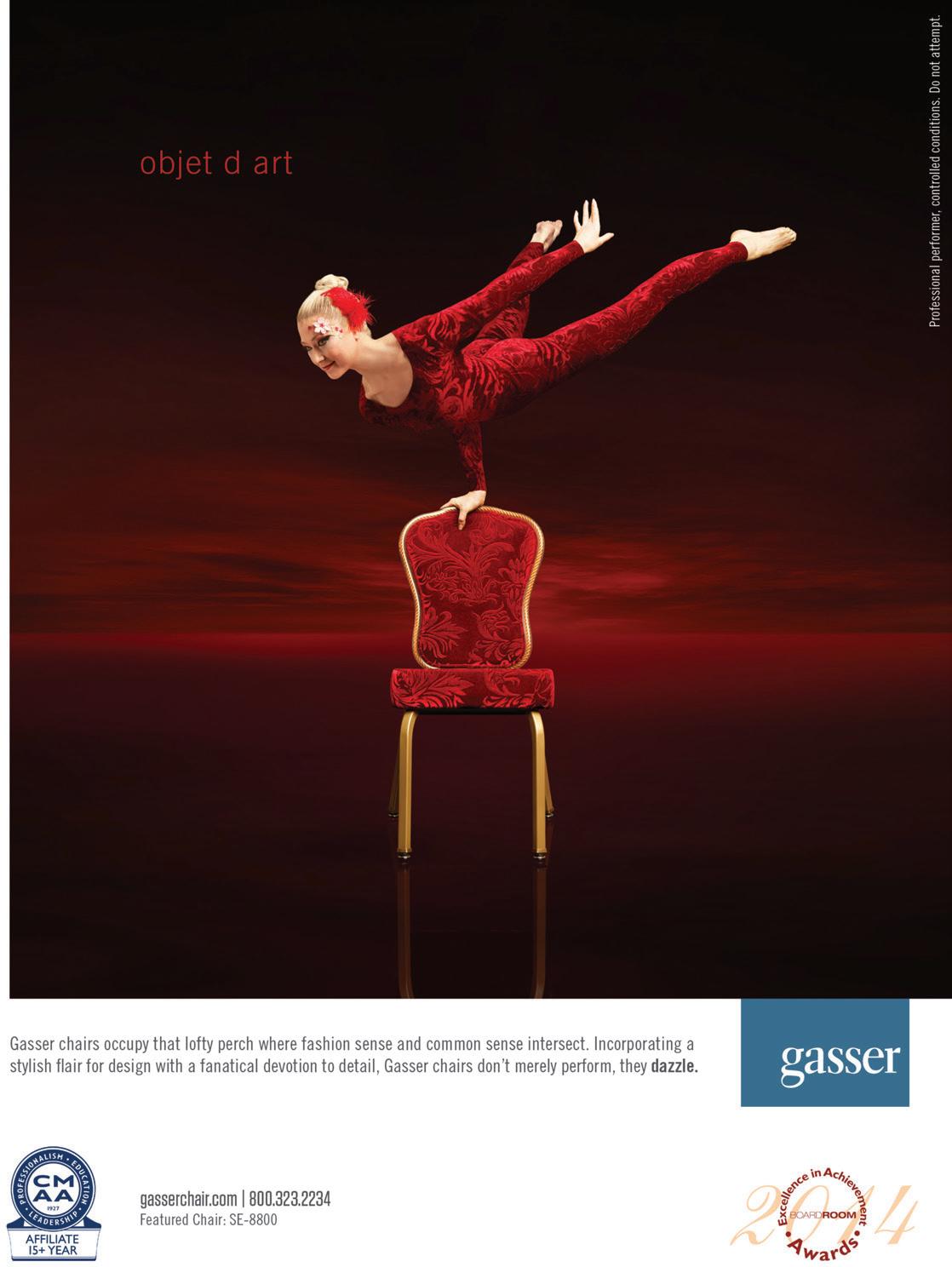

Eating out is one of the great pleasures in our society. It is also one of the significant benefits of belonging to a country club, and the key reason social memberships are so popular.
A private restaurant, a fine setting, special menus, a dedicated chef: all benefits. The chef at a nearby local country club is justifiably proud of his culinary skills. Over the past several years, he has amassed a number of taste-testing awards in our community, made a name for himself and improved the club’s draw at the same time.
The country club has more than avenged a past reputation for a stodgy, predictable, caloric-rich beef-and-brunch menu by hiring a chef with contemporary, fresh tastes, an eye toward healthy eating and an insistence on local provisioning. He’s one who is in touch with today’s food trends and patrons.
And yet, he doesn’t neglect the tried and true, but has dressed them in original preparations, flavors and interesting ingredient combinations. Bok Choy is no longer feared. Hurrah for a good chef in a lovely setting serving flavorful fresh food, where, as a member, you are nearly guaranteed to get a reservation.
In what may seem to be a completely unrelated subject (but please, bear with me), I’ve been doing research on food trucks and food carts for the benefit of my culinary-schooled son and daughter-in-law.
They are contemplating starting a food cart or food truck business where they live. Have you experienced a food truck or cart? Almost everyone has seen or eaten from a food cart, if not in your local community, perhaps on a trip to a metropolitan area. There’s nothing quite like a steamed hot dog right from the vendor cart while standing streetside in Chicago or Manhattan. But it is food trucks, in particular, that are sizzling right now.
The National Restaurant Association (NRA) reports that food trucks are “one of the hottest trends in the restaurant industry.” In 2012, food trucks accounted for 37 percent of the $1.4 billion street vending market – a 15 percent increase over the past five years, according to researcher IBISWorld, Inc. And U.S. interest in “food on the fly” continues to soar.

The NRA’s Hudson Riehle (a senior vice president) stated, “Convenience is a major driver in restaurant growth, and food trucks are certainly a convenient option by essentially bringing the restaurant to the consumer… Our research shows that in just one year, the number of consumers who say they would be likely to visit a food truck has increased significantly. We also found that food trucks have a more noticeable presence in communities in the West and Northeast than in other parts of the United States.” (For more information, go to: http://www.restaurant.org/Pressroom/PressReleases/Food-Trucks-Gaining-Momentum,According-to-Nationa). This is good news for my son and his wife since they live in Oregon.
On top of that, in 2014, Portland, Oregon, was dubbed a “food cart capital.” In June 2014, it was estimated that Portland was home to approximately 525 year-round food carts, plus additional summer-only catering trucks and food trucks that operated at street fairs and farmers’ markets. There are so many food carts in Portland, in fact, that Food Carts Portland publishes a map showing carts and their locations at: http://www.foodcartsportland.com/maps/ You might ask the difference between a food truck and a food cart. For one, it is mobility. In essence, a food truck moves and changes locations, while a food cart doesn’t necessarily have to move, although it can move. Food carts are often associated with large cities, where the carts offer a swift lunch to busy office workers. Size constraints limit selection and preparation. There’s that steamed hot dog again, or burrito, or Cuban bread.
But actually, contemporary food carts sell much more interesting stuff. In Oregon, some examples are:
• Gyros, falafel, hummous, and baba ghanouj at Aybla Grill – Mediterranean
• Korean-style tacos and rice bowls at Boolkogi Korean BBQ
• Samosas, curries and biriyani at Real Taste of India
• Reindeer sausage, bratwurst and hot dogs at Beez Neez
The second big difference is size and equipment. The new food trucks are fully operating kitchens-on-the-go. Yes, we mean stove and refrigerator. The menu is selected and prepared by a trained chef or cook right in the truck. There is no oversight by a management team. The overhead is the truck.
Whether it is simple or elaborate fare, it’s freshly made. It truly is an operating restaurant-on-the-run, so food items can be made fresh and by order. The chef, often the driver, selects a location each day in busy areas. They post their daily whereabouts on social media and some have developed quite a following in addition to the casual walk-ups.

Golfers are very familiar with beverage/snack carts, particularly those courses with no halfway houses. These are the beverage carts that circulate the course. Specially equipped with refrigerators and coolers to keep beer and liquid libations icy cold, the driver/bartender approaches golfers an average of two to four times per round – or that’s the goal. Why? Because cart sales represent another way to increase club revenues – as much as $1,000 to $3,000/cart/day at some clubs.
On an annualized basis, this can be significant – up to 30 percent of total food and beverage revenues.
Expenses are typically low. There is one specially outfitted cart and one employee. If the cart costs $20,000 (and has a useful life of three or four years) and the driver is paid the standard of minimum wage plus tips, it doesn’t take very many days to reach the breakeven point and start raking in the profits.
What’s typically stocked and sold on golf course beverage carts? Beer (domestic, premium and imported varieties) typically represents 60 percent of sales. Other beverages such as sodas, waters, sports drinks, and juices account for another 20 percent, and packaged food items such as chips, crackers, cookies, candies, fruit, and nuts constitutes 20 percent.
Occasionally, there are prepared sandwiches or a warmer with hot dogs or brats on the cart, served with your choice of packetized ketchup or mustard.
Why not use Portland’s food carts as a model to drive golf cart sales even higher? Of course, consider your members’ tastes. But consider some embellishments. Take, for
example, the lowly hot dog, which is easy to eat on the course. How about dressing it up? Beez Neez features hot dogs made with a mixture of reindeer sausage and beef, Louisiana Hot Links, German bratwurst, kosher beef and polish dogs. Cream cheese or bacon can be added to any dog for 75 cents.
No? Then how about a Classic New York dog (with Sauerkraut and/or fried onions), a New York Italian sausage dog, a “Spicy Russian Rover” with Muenster cheese, peppers and a spicy Russian dressing, or my personal favorite – a Chicago-style hot dog with pickle, raw onions, Mama Lil’s Peppers and relish.

Or, Relish Gourmet Hot Dogs features a “Bacon N’ Bleu” hot dog, with garlic aioli, caramelized onions, and bacon and blue cheese (of course). And its “Seattle Dog” is served slathered in garlic cream cheese spread, caramelized onions, sauerkraut and Dijon Mustard.
These may be too elaborate for easy fixing or eating on the golf course. But the idea of bringing in better, expanded food on the course cart is worth considering.
At many clubs, expanding the food cart menu would not necessarily increase revenues. For one reason, more elaborate food is readily available and cooked to order in the clubhouse where it can be prepared by chefs/cooks in a controlled environment.
If your chef’s reputation is secured through food competitions and he has drawn people to your club’s dining room through this avenue, fantastic! But not everyone can join a country club.
So here’s a thought. Jump on the food cart bandwagon. Expand your revenues by expanding adding a portable kitchen: a food truck. Take your chef’s food on the road and reach out to more of your population. Equip a food truck, label it with your club’s name and send it out with your assistant chef to locales near you and sell, “A Taste of Your Country Club.” BR
Special thanks to Marla Maloney for her thoughtful suggestions about this article. Nancy Levenburg, Ph.D., is a professor in the Seidman College of Business at Grand Valley State University in Grand Rapids, Michigan. She is the President of Edgewater Consulting, and is a member of Spring Lake Country Club in Spring Lake, Michigan. For more information, contact her at: levenbun@gvsu.edu or (616) 331-7475
by Dave White, editor
Tony D’Errico landed his first general manager’s job at the age of 26, albeit it at a small start-up, developer-owned golf club in southwest Florida.
“I’ll never forget my first day on the job, meeting my very first club member – a snarky fellow right out of central casting, who looked like Jackie Gleason in the Hustler,” D’Errico recalled recently.
“With a cigarette dangling from his mouth and gesturing toward the other members, he said, ‘Good luck keeping all these (bleeping expletives) happy.’ Welcome to club management!”
Well, as the saying goes, ‘time flies’ and many years later D’Errico, is now president of the Club Managers Association of America. D’Errico, elected at the recent CMAA World conference in San Antonio, Texas, succeeds Damon D’Orio, president for 2014.
D’Errico, CCM, CCE, heads an organization that’s front and center in the private club industry, a $14 billion business.
D’Errico worked in the restaurant business throughout his college days and immediately thereafter…”just long enough to know I didn’t want to make it a career. Food and beverage management was, nevertheless, a mar-
ketable skill that I was able to use as an entree to the club industry,” he explained.
Today, along with being the CMAA’s new president, D’Errico is general manager/chief operating officer of Westwood Country Club in St. Louis, MO. He’s been with Westwood Country Club as the general manager/chief operating officer since 1999. Previously, he managed Champion Hills Country Club, Hendersonville, NC, and that much-remembered first club – Riverwood Golf Club in Port Charlotte, FL.
“I was fortunate enough to work for a company – the Mariner Group – that believed deeply in professional development,” D’Errico added. “My vice president introduced me to CMAA and suggested I join.” He did, in 1993.
“CMAA didn’t just help me with my industry education. It HAS BEEN my industry education,” D’Errico exclaimed. “With only a working knowledge of food and beverage… and being on the developer side of the business for the first eight years of my club career, I found both BMI (Business Management Institute) and chapter programs to be a Godsend. They were ‘drug-like’ for me, in that the more I consumed, the more I wanted.”
It all led to greater involvement in CMAA. D’Errico has served on many national committees, including the certification committee, the career services committee, the technology committee and the Premier Club Services Committee. He has also been a member of the International Wine Society since 2005.
And at the chapter level, D’Errico served on the board of directors as president and vice president for the St. Louis Chapter. He also served as the regional director for the both the Carolinas Chapter and the Florida Chapter. His commitment to CMAA has been unwavering.
Now as president, D’Errico faces the challenges of 2015.There are several he plans on meeting head on, and CMAA’s hallmark designation, the “CCM – Certified Club Manager”, is on his list.
“One of CMAA’s greatest long-term challenges is to broaden the reach and recognition of our hallmark designation, the CCM – to include club board rooms. This is
critical, because while demand for the CCM remains very high among club managers, market demand for club managers with the CCM credential will impact our sustainability even more. And make no mistake, that kind of market demand comes from the board room, not the manager’s office,” he injected.
However, “the biggest challenge the private club industry must successfully overcome is the decline (and sluggish recovery) of golf. While not every club offers golf, most do, and most are impacted by its decline,” D’Errico opined.
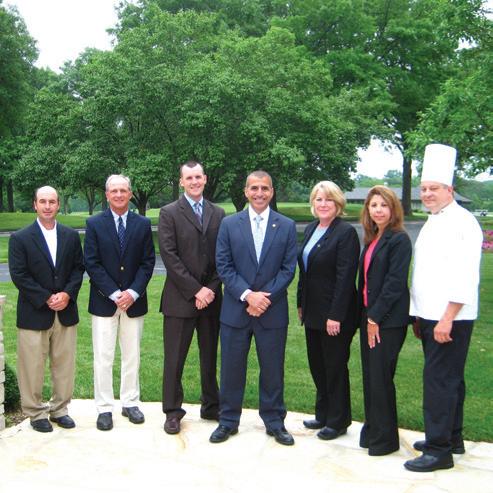

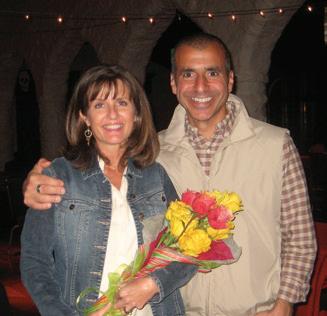


“Managers everywhere are reacting to this by diligently attempting to ratchet-up the value proposition in other areas of the club. Of course, we can deal directly with the things that ail the game – cost, time, degree of difficulty and access – but without offering relevant facilities and programming for the entire family, that could be a losing battle.”
On the other hand, club governance is perhaps the most challenging hurdle club managers face, eliminating archaic governance forms in favor of a collaborative experience.
“While tremendous progress has been made over the years by CMAA in advancing the ‘management to leadership’ model, there are still clubs with archaic governance in place.
“Time spent by club managers reacting to dysfunctional governance is time spent away from more important things, such as business analysis, strategic and tactical planning, program development and teambuilding,” D’Errico added.
And for D’Errico, it also will be a year of helping CMAA’s new CEO Jeff Morgan assimilate to his new duties. A year ago, then-President Damon D’Orio launched the search committee to find a successor to long-time CMAA CEO Jim Singerling, who retired in late 2014.
“I’m very proud of our board for the manner in which we conducted this search and placement. Jeff is doing an incredible job so far, but more specifically throughout the coming year, a great deal of the board’s time will likely be spent on issues relating to CMAA’s ‘alignment’ – alignment with the needs and expectations of our chapters, partners, affiliates, allies and, most importantly, our members. In short, it is this board’s top priority to evolve CMAA into a more transparent, member-centric organization,” D’Errico explained.
However, the biggest challenge the private club industry must successfully overcome is the decline (and sluggish recovery) of golf. While not every club offers golf, most do, and most are impacted by its decline. Managers everywhere are reacting to this by diligently attempting to ratchet-up the value proposition in other areas of the club. of course, we can deal directly with the things that ail the game – cost, time, degree of difficulty and access – but without offering relevant facilities and programming for the entire family, that could be a losing battle.
So how does Jeff Morgan’s vision of CMAA’s future align with CMAA’s board?
“To use one of Jeff’s terrific buzzwords, we are ‘co-creating’ that vision right now!” outlined D’Errico. “In order to do so, we must first bring into focus a clearer vision of the industry’s future – and along with it, a better
understanding of the competencies managers will need to be successful. Advancing our profession and fulfilling the ever-changing needs of our members – and the clubs they all serve – is our mission and our future.”
This of course, happens to be in concert with the activities of general mangers and their boards.
“While the jobs themselves clearly differ in today’s best-run clubs, the GM and the board are thought partners,” D’Errico offered. “It is the aim of our association, long-term, to become an even better resource for our members by providing educational tools for the club’s volunteer leadership along with its management team.
“We’ve already started this with our newly-introduced ‘Presidential’ track education at the World Conference and plan to continue it by creating distance learning opportunities through CMAA University,” D’Errico added.
It’s been an interesting road to the top for President D’Errico, and as always there have been many who have had an influence on D’Errico’s career.
“My first club president, Bryan Brown, still a dear friend today, influenced me a great deal, and at an extremely impressionable time in my life,” D’Errico related.
“He demonstrated for me the importance of character in leadership and taught me how to understand people. Most of my mentors today – and, trust me, it’s a long list – are friends and colleagues: Damon DiOrio, Kevin Carroll, Rick Baylis, Barbara Heninger, Bobby Crifasi, Michael McCarthy, Mark Bado, Jim Bahlinger, Jeffrey Kreafle, Tom Bertani, Bill Maynard, Bob Bisesi and my pastor, Michael McIntyre.
“They’ve all influenced me in a variety of ways, but what inspires me most are the qualities they share: unwavering personal integrity, authentic kindness and genuine respect for others.”
Despite the growth and recovery of the private club industry, there’s been a sticky point for D’Errico, and he’s anxious to make amends.
“The mainstream media declared war on clubs right after the great recession – and we can no longer allow them to (mis)tell our story,” D’Errico lamented.
“The industry’s economic, charitable, environmental and health benefits are indisputable. And yet, clubs continue to be misunderstood by the general public and our elected officials.
“Coalitions like ‘We Are Golf’ are vital to the effort, but in order for clubs to be universally embraced, the mainstream media must become our ally and start telling the real story –
the more compelling story – of this wonderful industry. And we must tell our compelling story more often, because if we won’t tell it, no one else will,” D’Errico added.
“My leadership style is heavily influenced by my faith and my family life,” explained the CMAA president who was raised in Oyster Bay, New York by a mother who taught high school math and science, and a football coach dad.
My first club president, bryan brown, still a dear friend today, influenced me a great deal, and at an extremely impressionable time in my life. He demonstrated for me the importance of character in leadership and taught me how to understand people. Most of my mentors today – and, trust me, it’s a long list – are friends and colleagues.
“It’s pretty clear to me that the life lessons I experienced growing up in this family – the virtues of honesty, hard work, selflessness and humility – formed the foundation for the leader I eventually became.
“I’ve enjoyed every stop on my career path, but I am especially proud of my affiliation with the members and staff of Westwood Country Club, where I’ve served as the GM for the last 15 years,” offered D’Errico. “Westwood is a special place; an institution that, above all else, values people and charitable giving – and has for over a century.”
An avid sports fan, D’Errico “loves the New York Giants, the St Louis Cardinals and the PGA tour – and not necessarily in that order.”
A lifetime golfer, he managed to get his “handicap into the single digits in my early 20s (but alas, it hovers mercilessly in the high teens today). I’m addicted to tennis.
I enjoy reading, rigorous fitness, travel and, recently I’ve become a selfdescribed, classical music nerd,” he enthused.
“My family and I support the ministries of Living Word United Methodist Church, where I’ve served on various committees, taught senior-high Sunday school and play the guitar in our praise band.”
D’Errico and his wife Jenny have been married for 25 years. “We have two awesome kids: Nick (24), an engineer with Honeywell in Kansas City and Michael (20), a junior at Belmont University’s School of Music in Nashville,” added D’Errico.
D’Errico undoubtedly has enjoyed some interesting and successful times in both his private life and the private club industry…right from his first day at his first club, where he met that snarky cigarette-smoking member with his ‘inspiring’ words of wisdom.
Unquestionably, the interesting and successful time will continue for Tony D’Errico as CMAA’s president for 2015…carpe diem! BR

The improved economy across the country in recent months has more clubs considering updating their golf courses.
The challenge is to balance sound financial decisionmaking with the call from members to have fun, playable, sustainable courses that positively impact everyone.
Enter the American Society of Golf Course Architects and its members.
There can be as many reasons to consider a remodeling project as there are holes on a golf course: Correcting turf conditions and inadequate drainage, improving safety conditions, increasing pace of play, improving the overall look and appearance of the course and improving value to stay competitive. Walk your course with a critical eye. What challenges must be faced in managing the course? What challenges do members face playing the course? How might changes to the course improve the bottom line?
A recent survey of ASGCA members found several trends in how golf course architects are advising their clients: Reduce maintained turfgrass: Most areas of the country are facing reduced water supplies and/or water quality. Rather than cutting back on water to keep turf healthy, why not cut back on the amount of turfgrass that needs to be watered, fertilized and mowed? A golf course architect can


advise operators on where to remove turfgrass, replace it with native plants or other materials and continue to maintain the strategic intent of the layout.
Introduce enhanced practice facilities and “looping threes”: One reason cited by people for leaving golf or not taking it up is, “It takes too long to play.” Ninety-seven percent of ASGCA members surveyed say they are “Improving or expanding practice facilities” to help operators draw more players. Having more opportunities to practice shots off the playing field can make the transition to a round less intimidating. Another trend is remodeling a course to include two, three or even more “looping threes.” The idea is to re-route a course to allow a player to play three holes and return to the clubhouse. This allows a time-constrained player the flexibility to play three or six holes and can lead to more players out on the course. A golf course architect can take pictures of a layout and simulate how a re-routed course could look.
Move to larger tee areas, softer green contours and simpler bunker surrounds: Each of these tweaks to areas of a golf course that see heavy use or need intensive maintenance attention can save money. Increasing the size of tees results in reduced wear and tees can be maintained in less time using larger equipment. Softening green contours allows the use of triplex mowers rather than hand mowing. And changing bunker surrounds to native grasses reduces labor time spent tending to tricky turfgrass edges.
Decrease the number of bunkers: Converting some formal sand bunkers to fairway or turfgrass-based natural landforms helps the bottom line in two ways: Sand bunker maintenance is reduced (hand trimming, drainage maintenance and sand replacement), and pace of play increases when players spend less time shooting out of hazards. As with turfgrass reduction, a golf course architect can advise on reducing the number of sand bunkers while maintaining the golf course’s strategic intent.
The golf course is a club-wide asset, and making sure it’s ready to welcome today’s golfer and can be managed efficiently needn’t break the bank. BR
The ASGCA website has plenty of information with tips for planning a golf course remodel and running more cost-effective golf operations. This includes “The Golf Course Remodeling Process: Questions and Answers”, which walks through the feasibility and planning process. Visit http://asgca.org/free-publications, or find a golf course architect at http://asgca.org/members.


“There was no respect for youth when I was young, and now that I am old, there is no respect for age - I missed it coming and going.”
~J.B. Priestly
What can we learn from the so-called generational gap? First, we must recognize that every generation is influenced and defined by its shared events.
The Vietnam War, civil rights riots, and the assassinations of President Kennedy and Dr. King influenced Baby Boomers (born 1946 –1964). The oldest boomers today are around 70 years old and within 20 years, most Boomers are expected to reach 65 years of age.
Generation X (Xers, born 1965 – 1982) grew up with insecurity: financial, familial, and societal. Many Xers grew up in dual income or single-parent households, sometimes forced to fend for themselves as latchkey kids. A greater share of Xer women than men graduated from college.
Generation Y (born 1983 – 2001) also known as Millennials, was shaped by parental excesses, computers, and extraordinary technological advances. This group includes almost as many births as the original baby boomer generation. They will soon become the largest living generation during the century.
So how do we manage a multigenerational workforce? Let me TRACE out a few tips:
Training – Every generation values training and opportunities to hone their skills. Baby Boomers value classroom style training for ‘softskills’ training and on-the-job (OTJ) training for ‘hard-skills.’ Millennials prefer less classroom instruction, yet welcome opportunities to learn about leadership, and mentor programs. X’ers fall somewhere between the two with emphasis placed on advancement and promotion. Generally speaking, older generations prefer training in their areas of expertise. Younger generations prefer leadership training. Immediate feedback is also critical to a millennia’s success. Respect – Respect is critical for everyone. Baby Boomers grew up in a time where hierarchy and top down chain of command was the norm. They were taught respect should be deference to age, experience and skill. Xers and Millennials are accustomed to speaking with anyone at any level,
so they are less likely to appreciate chain of command. Generation X and Millennials also want to be held in esteem and to have their opinions heard but do not expect deference.
Acknowledge - the generational difference and seek ways to use strengths of each. These accommodations to the generation’s unique needs and perspective is imperative for successful multigenerational management.
Communicate - and over-communicate.
Generational conflict is more likely a product of perception than from a valid difference. The younger generations have been taught to ask questions, question authority, and find the best way to the end result. They are less processdriven than Baby Boomers, who may find questions an insult, whereas a millennial is trying to understand so they can use their unique skills.
Millennials have never been without technology, and there are myriad apps, websites and other solutions available of which older generations may simply be unaware. Conflict can be reduced by considering the root cause of the questions being asked before jumping to conclusions or assuming it is a sign of disrespect.
Encourage retention - through commitment to employees. If you acknowledge the experience of older workers while recognizing the unique talents and contributions of younger employees, you will likely experience a higher retention rate. Employee loyalty to employers has been changing since Xers entered the work force. Studies have shown that all generations value sincere recognition of their efforts and are more likely to stay in jobs where they are happy. However, work/life balance is much more important to the younger generations than it was to the Baby Boomer ‘workaholics.’ Since the younger generations desire more time with friends and family, seek out ways to provide flexibility, autonomy and life balance to gain their loyalty. BR
Whitney Reid, president of Reid Consulting Services, Inc. (RCS) is a celebrated management consultant, educator and speaker. RCS, the creators of Food and Beverage Service Boot Camp, specialize in strategic planning, operations consulting, food and beverage management, and training programs. For more information, phone (623) 322-0773; or visit www.consultingrcs.com.



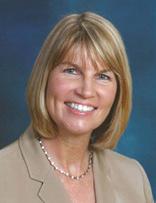
During visits to clubs we see the best practices of the most successful clubs and the worst practices of the least successful.
House committee members in the most successful clubs are focused on “The House.” Their meetings are based on the results of real and actionable data. They are not involved in operations and they don’t let the opinions of the vocal few dictate the direction that management professionals take.
Incorporating a balanced scorecard methodology at your club shifts the house committee (and board for that matter) from an opinion-focused approach to a data-driven process that is based on clear objectives, data measures and results.
Anecdotal information often leads to focusing on the wrong things and having the management team chase down seemingly well-intentioned ideas that are not based on facts, and are ultimately focused in the wrong direction – like painting the wrong wall.
Providing fact-based information to the house committee is irrefutable and drives clarity and purposeful discussions around actions and results.
Balanced scorecards track real data measures based on the club’s strategic plan and mission, vision and core values, ensuring a “balance” between business functions. The four quadrants of a traditional balanced scorecard are: Customer, Financial, Internal Business Process, and Learning and Growth. The management team reviews, reports and manages all four business functions to make sure there are no surprises.
The general manager and department heads identify the high value targets in each of these quadrants based on the club’s action plans, and measure them on a regular basis. The targets are used to establish goals and drive process improvement.
This actionable data is stored in multiple sources at your club including the payroll system, point-of-sale software, survey responses and other disparate sources. If you have the data, you can export it and combine it in a database software platform.
Once the management team has downloaded, combine, and organized the data into a meaningful structure, it can be analyzed across multiple dimensions such as member categories, dining
outlets, demographics and time studies. Management can then monitor trends and anomalies to determine the club’s vital opportunities for growth and improvement.
When a committee or board is provided with high-level actions and results based on real data, they achieve clarity of purpose, are focused on the impactful objectives and results, and have faith and confidence in the decisions that are made. Balanced scorecards are important tools in monitoring the status of the club’s processes, improving those processes and communicating results with the staff, the board, the committees and the members.
To get started, review your strategic plan. What objectives in the plan are specific to “The House?” What data can be measured to determine whether or not the club is on track to meet those objectives? Where is the data stored? How often will the team measure the data (daily, weekly, and/or monthly)? The high-level results should be reported to the house committee at least monthly.
Providing fact-based information to the board, house committee and staff is irrefutable, and drives clarity and purposeful discussions around actions and results. In addition, the team “knows the score.”
As Steven Freund, the executive director of The Landings at Skidaway Island, stated. “The team is aware of their scores and how they can influence the outcomes. They take a professional pride in improving their scores and they want to win.”
If your club currently uses balanced scorecards please send me an email (lisa@kopplinandkuebler.com). I would like to include some of your measures in future articles that will drill down into the four quadrants and share ideas for tracking and measuring the data.
In this high-touch business of private club hospitality, I understand that you can’t run a club on metrics alone. But, as Vince Lombardi said, “If you’re not keeping score, you’re just practicing.” BR
Lisa Carroll is a search executive and consultant with Kopplin & Kuebler, LLC, a consulting firm providing executive search, strategic planning and data analysis services to the private club industry. The company has offices in Scottsdale, Jupiter and Atlanta. Lisa can be contacted at (561) 596-1123 and at lisa@kopplinandkuebler.com.
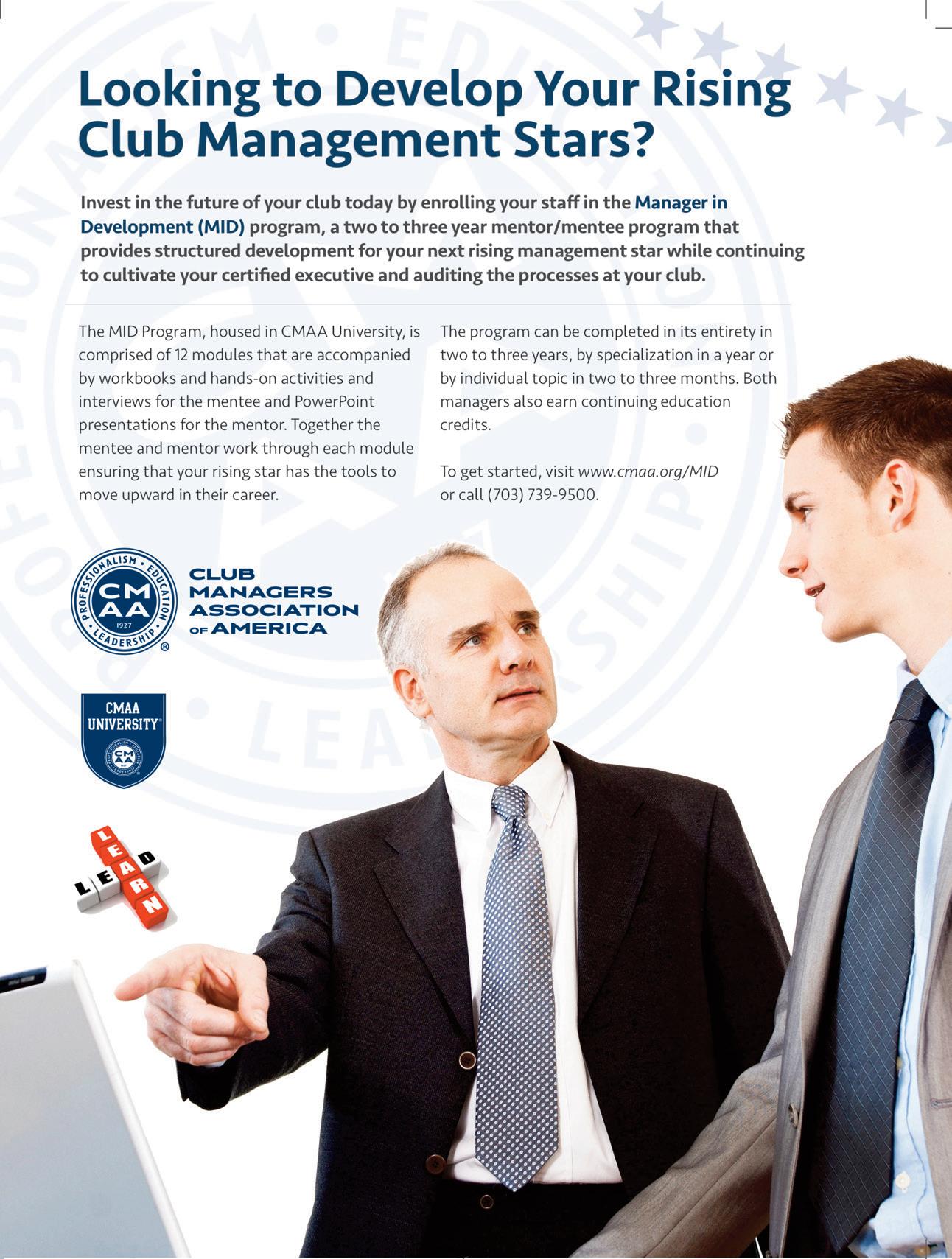

Taking advantage of “tremendous opportunities” will help grow the game of golf.
That’s the opinion of Dave Schneider, general manager of Wakonda Club in Des Moines , Iowa. Schneider, a PGA member since 1997, currently is Iowa Section PGA President. And much of the opportunity Schneider talks about emphasized a thrust the PGA’s business leadership programs offer.
“Aaron Krueger, our head PGA professional and the staff have worked very hard in the off season on a ‘4 pillar’ approach to drive more golf rounds out of our Wakonda members and guests,” explained Schneider.
The four pillars for Wakonda are:
1) The professional golf staff playing more golf daily with members
2) Taking more members on golf trips and to pro-am golf events to strengthen camaraderie
3) Hiring a director of instruction to aide in the members’ enjoyment of the game at a higher level, and
4) Creation of a sales and marketing plan comprised of complimentary guest passes and reduced guest green fees to trigger the entire initiative, and as a thank you for their patronage to the club.
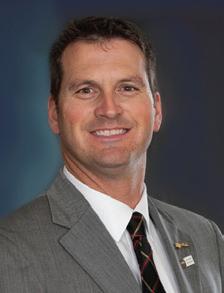
Schneider figures this business approach will pay off in spades for Wakonda.
“Business leadership is all about the team that is assembled around you. To me, business leadership is hiring, molding and inspiring a unified team that understands your facilities, your mission and vision inside and out and breathes it every day,” Schneider expressed. It starts with a club’s strategic plan and mission and vision statements. “I personally feel that every club should go through a strategic planning session every four to six years to ensure that the club is remaining relevant for its members.
Wakonda in 2013 completed an all member survey and strategic planning session, which has provided the roadmap for successful future planning.
“The senior staff, club committees and club leaders all reference these documents during planning sessions to ensure that we are ‘on point’ when it comes to yearly goals.
“With any business, the perceived value of the product that you provide your customer needs to be higher than the cost that they pay for that product. A successful private country club is no different,” Schneider offered.
“You must demonstrate on a consistent basis that your products and superb customer service is more of a value than the monthly dues that they pay for it. If that scenario exists at your club then you have the best chance of attaining the ultimate goal of every private country club…a fully satisfied membership with a wait list of those desiring to join.
“Member dues are king and shape your bottom line year in and year out,” Schneider stressed. “All leadership decisions should start with the question, ‘Does this decision assist us in retaining a current member or will this decision assist us in attracting new members?’”
Wakonda Club policy encourages front line business decisions that assist this stance.
“We try and empower our front line employees in all departments to take care of the members at the point of truth when it matters,” Schneider stated. “If a scenario arises that a member is not satisfied, the employee has the power to do everything, within reason, to immediately rectify that situation without obtaining permission from a supervisor first.
“Being able to take care of the member’s needs in a timely fashion absolutely aides in member retention in our eyes and thus directly impacts the bottom line
“Particularly at a private club, there can be no breakdown in any area or department from the moment members and guests arrive on property to when they depart,” Schneider emphasized.
“If each facility does their part and grows their golfer base and interest in the game, our entire industry benefits as a group and individually.” BR

DOES IT GO FAR ENOUGH?

Let’s start with a reality check. The vast majority of private clubs don’t have any kind of IT strategic plan at all. In fact, very few clubs have what could even be considered a comprehensive budget for IT.
However, we are now seeing the beginnings of a trend in the industry where clubs are developing formal IT strategic plans, which typically focus on budgeting for future technology expenses.
The idea is to look forward for the next five years or so, determine what will be needed to maintain or expand the current technology footprint and calculate a budget to cover those expenses. Budgeting generally includes the following items:
• Maintaining the club’s network infrastructure and equipment inventory with replacements and needed upgrades
• Providing technology to support anticipated physical footprint changes (new spa or fitness center, clubhouse renovation adding new dining or activity areas), and
• Providing technology to support new operations (security cameras, access control systems, club management software, other specialty software).
This approach is a significant step forward in the private club industry. But it’s not enough, because an effective club plan should address more than just the physical footprint of technology. It should also include strategies to increase member satisfaction.
A comprehensive plan should address the use of technology to enhance the member experience – while members are at the club and when they are away from the club – which adds value to the membership. Here are some specific examples of how technology can be used to enhance the member experience:
1. Robust member website – A fully mobilized site that is responsive to the device being used by the member (more than half of most club’s members access the website using a smartphone or tablet); a variety of content that is well organized and easily accessible; opt-in interest groups that allow members to control what email promotions they will receive.
2. Comprehensive online reservations – Easyto-use reservations modules for sports reservations (golf tee times, racquet sports court times, lessons, personal training, classes and activities) and club reservations (social and dining, hotel rooms).
3. Online member account management –Secure online access to monthly billing statements, POS detail and minimum spend balances, online bill pay, credit book and gift card balance and transaction history.
4. Expedited member service –Self-serve POS for F&B outlets geared to fast service, golf cart call-ahead ordering, dining online take-out ordering; self-serve check-in at fitness and spa areas.
5. Enhanced member connectivity to other members – Website includes enhanced member roster with interests, home states, player caliber, neighborhood, etc., and online social networking that is private to the club’s membership.
6. Enhanced member connectivity to the outside world – High speed WiFi access to the Internet throughout the club facilities; business center with PCs, printers, etc. and sensible mobile device usage rules that separate data from voice usage.
In essence, your club’s IT strategic plan should consider technology as a member amenity, and not just as an internal production tool. Astute clubs are quickly realizing that by focusing on technologies that enhance the member experience, the budget dollars needed to deploy those technologies become readily available.
And here’s the icing on the cake: The infrastructure needed to support those member-facing technologies is the same as what is needed to support the production side of the business. Tie your club’s IT budgeting to the member experience and the funding will be more easily available for the entire technology footprint. BR
Bill Boothe is president of The Boothe Group, LLC, an independent consulting firm that helps private clubs understand computer technology, make good decisions and receive the highest value from their technology investment. During his 25 years in the industry Bill has assisted more than 350 private clubs with the planning, evaluation, selection and implementation of computer technology in all facets of their operations. Bill can be reached at bboothe@boothegroup.com.

BY BRUCE REIMANN
One of the key elements of country club management is to accurately determine the replacement cost valuation of the structures and amenities of the club.
Each day, more and more clubs are discovering that having an independent, third party insurance appraisal provides the values they need for insurance purposes.
Club managers and boards are choosing to use insurance appraisals for a number of reasons. Insurance appraisals, prepared by experienced appraisers utilizing state-of-the art software, are proven to be the most accurate method in determining the construction cost valuation of the structures.
Knowing the club has adequate insurance provides peace of mind to managers and board members, as well as club members, and fulfills their fiduciary responsibility in the placement of the insurance valuation. Additionally, having an insurance appraisal performed by a qualified appraisal company can help to expedite the settlement of a loss in case of a claim.
Finally, having an up-to-date insurance appraisal provides accurate values for coverage, eliminating the possibility of a co-insurance penalty in the event of a loss.
Many insurance policies have a co-insurance clause built into the policy. Therefore, it is essential that the club base their insurance coverage on accurate replacement cost values.
Co-insurance is a provision in an insurance policy under which the policyholder agrees, at a reduced rate, to maintain insurance equal to a specified percentage of the value of the covered property. If the policyholder fails to maintain that minimum amount of coverage, a co-insurance penalty may be applied.
For example, the insured owns a building valued at $1,000,000 and, per the co-insurance clause, must insure the property to 80 percent of replacement cost value. So the structure must be insured at $800,000 to avoid a penalty should a significant loss occur. If there is a loss and insurance carried meets the 80 percent co-insurance requirement, the policyholder will be eligible to be paid the full value of the claim, up to the policy limit.
A simple formula outlining the amount of insurance carried divided by the amount of insurance required to meet coinsurance requirements is used to calculate the applied penalty.
Many clubs are now turning to insurance appraisals to assist them in insuring to accurate replacement cost values. But what is an insurance appraisal?
An insurance appraisal is a replacement cost analysis that provides an accurate estimate of the amount of insurance required to replace each structure and amenity insured exactly as it stands on the day the analysis was prepared.
In order to prepare the analysis, a thorough on-site inspection is made of the club’s structures and amenities. During this inspection, notes are made documenting the construction details of each item being appraised and a full photo array is taken of each structure and amenity.
The appraiser obtains construction plans, which are digitized in order to determine the accurate square footage of the structure. Replacement cost of each improvement should be calculated on a component-by-component basis using stateof-the-art software in the preparation of the final analysis.
Once the decision is made to obtain an independent, third party insurance appraisal, an insurance appraisal provider must be chosen. How does the club determine which provider is best for them?
There are several questions to ask: How stable is the provider? This can be determined by asking how long the company has been in business. Generally, a company that has been in operation for a lengthy period has proven itself in the marketplace.
• How experienced are the appraisers? The appraisers should have many years experience in construction cost valuation and should be knowledgeable of construction costs in your specific area.
• Is the provider a large company or a one-person shop? Should your appraiser retire, become ill, or leave the business, there should be a guarantee of continuity of service. By choosing a larger provider, there will always be someone to assist you.
• Will a sample report be provided? As a client, you have the right to see the type of report and work product you will expect to receive.
• What method does the appraisal company use to determine the insurance values? The company should provide a thorough on-site inspection and utilize construction plans for each improvement on the property in order to determine accurate estimated insurable values. BR
Bruce Riemann is sr. appraiser/manager with GAB Robins. Bruce can be reached at briemann@cl-na.com

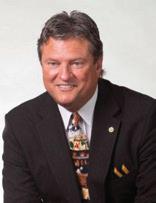
MICHAEL CRANDAL, CNG
When meeting new people in a social environment, after just a few moments of obligatory personal pleasantries, it is inevitable that our minds quickly try to “size up” the person in front of us. (Don’t take it personally — they’re doing the same thing to you!)
It’s now only a matter seconds before one of you will inevitably ask what both of you really want to know of the other. And – because we all see the world through our own unique set of filtered glasses – the answers offered to that question will prove pivotal as to how each views the other from that point on.
The answer instantly transforms what may have been only a polite exchange of small talk while glancing around the room – into some real eye contact as their story comes out.
What is that pivotal question? We all ask it of others and we all get it asked of us. Here it comes, “What do you do?”
Well – “What exactly is it that you do?”
On the surface it seems like such a simple question that could be simply answered, “Well – I get up, brush my teeth, have a cup of coffee, etc.
But, we all know the question goes deeper than that. What you’re really being asked is what your job is. That, too, seems like such a simple question that could be answered with little explanation.
Just say the words “I am ____” and then fill in the blank with a noun (… a CPA … a chef … an astronaut … an editor … a banker … an attorney … a pastor … a general manager … etc.)
When the question, “What do you do?” is responded to by offering an occupation or position title, the question itself has really not been answered. The word “do” is a verb thus a proper response would describe activity.
Executives need to clarify the difference between their job title and what they really should be doing.
Regardless of whatever job title or lofty position, what leaders MUST be doing is: 1) Selecting the right people and putting them in the right places; 2) Developing, motivating and mentoring them, and 3) Culling the herd when necessary. That is what you do! That IS your job.
Every introspective leader should look in the mirror, have some real eye contact, and pointedly ask themselves the question, “What do you do?”
A meaningful answer would be something along these lines: “My profession is that of a general manager who knows that my real job is all about hiring the right people and providing great leadership as a positive mentor of a great team. That is my real job. And, that is what I do.”
If an executive realizes what their real job is, focuses on that job and is committed to really making it happen, career success is a highly predictable byproduct of just going about the business of doing the same job every day! This is true regardless of what industry or title may be under your name on your business card.
Your boss and/or board of directors have their own set of filtered glasses as well!
When they get you in their sights, they’re not looking at the title beneath your name on your business card or office door. All they see is how successful or not you are in identifying top talent, your ability to manage/lead that talent, and whether or not they they looking good as a direct result of having you on their team.
What they see ― is what you get! BR
Oh, and one more thing, just in case you’re wondering. The letters after our author’s name Michael Crandal, CNG — stand for: Certified Nice Guy. Self-certified, by the way. But, a nice guy nonetheless. Michael has 25+ years private club expertise and is a frequent BoardRoom magazine contributor. He and his wife, Kim, reside in Atlanta, GA. He can be reached at (760) 464-6103 www.linkedin.com/in/michaelcrandal
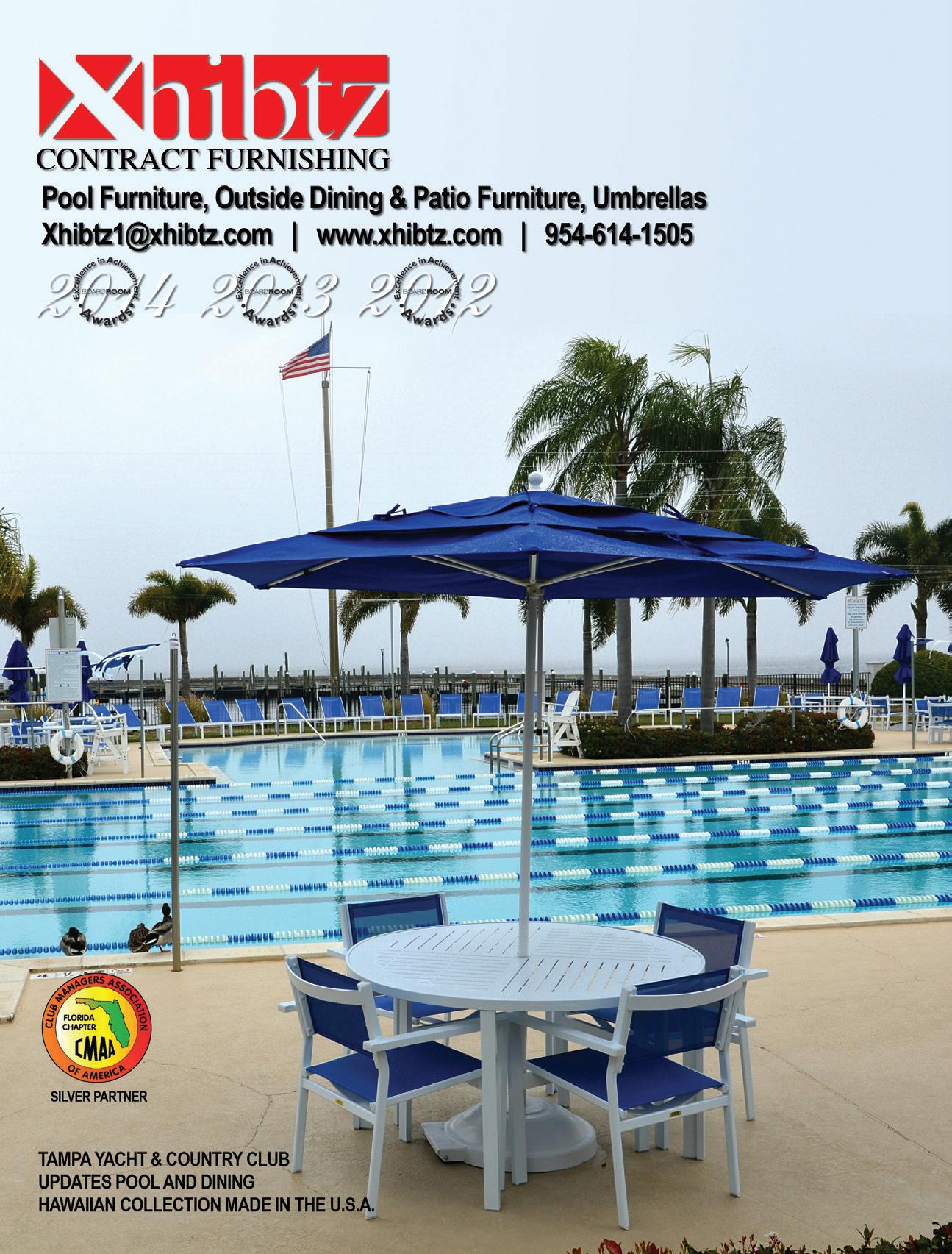

We all know that it takes proper tools to get any job done right. Our catering jobs in our clubs also take tools – and lots of them!
One of the most powerful tools we have is proper communication, so let’s focus on how we can use this tool of communication to get what you want and need to succeed.
Smart catering professionals know that working with club managers and other department heads is a vital part to our club’s growth and ability to thrive. Of all the departments within the club, catering happens to touch almost every department at one time or another.
Catering works with membership on leads and prospecting; with accounting to handle billing for all of our events; with golf, tennis or athletics both in planning their department’s events as well as planning outside events in that department; and with the front desk, valet and clubhouse maintenance so that the club is prepared for hosting clubs events.
Actively work on these communication skills to improve the operations and execution of events. The catering director should ask the various department members what else they can do or how else they can communicate to improve operations between departments.
This is especially key with the kitchen and service staffs – great communication (especially on those BEOs) is a MUST! We never know what will benefit someone or how to communicate with them unless we ask!
One of the most vital relationships the catering director has is with the club manager and how effectively they can relay information back and forth in the manner most beneficial to the other.
Club managers can help greatly in this process by being very approachable and eager to help so that the catering director feels free to ask for what they want and need (“I want some administrative help so I can concentrate on sales” or “I need new carpet in the banquet room!”).
This is imperative so that the club manager can communicate relevant information to the board or corporate office for budgeting purposes, capital expenditures, etc. Responsibility must be
placed on the catering director to know their numbers, know their facts and have possible solutions to their problems.
A club manager I once worked with used to say, “Don’t come into my office with all these monkeys on your back unless you have possible solutions!” So, if for example, a Catering Director the club needed need new carpet in my ballroom (or chairs, or paint, or new décor), it is important to approach this capital expenditure like you would any other business deal.
I need to show the expected financial results of doing it and NOT doing it. What will it cost me in new business if we do not make these changes? What am I estimating it will gain the club in new business?
Other than the financial aspects, it is always beneficial to have some quotes or testimonials from members and guests about how this change will elevate the standing of the club, make a member more proud to host or refer an event, etc.
Keeping a “lost business report” is a great way to estimate the number of events that did not select your venue because of a factor that could be within your control. This is a good place to look for trends.
If you see that you are getting the same reasons over and over for people not booking with you, then this is one of the best places to start to make changes! And it all starts will simple, but direct communication.
This month, challenge yourself to approach every person in the club that you need to interact with and open some conversation about how you can better communicate with them in order to help them do their job better and improve your overall club communication.
Success equals 80 percent communication and 20 percent execution! BR
Lynne LaFond DeLuca is the executive director of the Association of Club Catering Professionals and a private club industry consultant.
Email: Lynne@TheACCP.com
Web: www.TheACCP.com
Twitter: ClubCateringPro
Facebook: AssociationofClubCateringProfessionals
THE KOPPLIN & KUEBLER TEAM FINDS THE BEST CANDIDATES TO FILL YOUR EXECUTIVE LEVEL POSITIONS GENERAL MANAGER, ASSISTANT GENERAL MANAGER, DIRECTOROF GOLF, CLUBHOUSE MANAGER, CHIEF FINANCIAL OFFICER, GOLF COURSE SUPERINTENDENT & EXECUTIVE CHEF SEARCHES.
“Our team represents over 150 years combined experience in Platinum© recognized clubs, including country, golf, yacht and city clubs, and has worked with over 600 clubs across the country and around the world.”
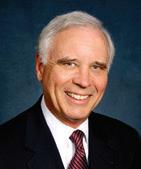

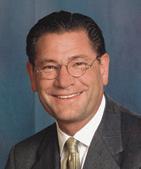

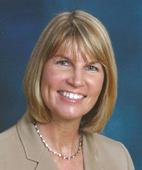

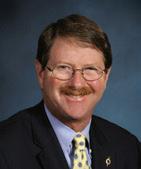

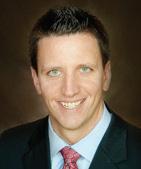

BULLETPROOF YOUR CLUB IN THIS ECONOMY WITH THESE SUCCESSFUL PROGRAMS
Strategic Board Retreat and Planning
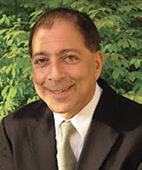

This retreat focuses the board on the top five strategic objectives to enhance their club right now.
Team Development
This workshop identifies specific strategies that assist department managers in facing the variety of challenges in the club business.
Board Dynamics/Model Clubs
This workshop addesses critical issues facing general manager/COOs and their boards in today’s club environment.
2014 SEARCH FIRMOFTHE YEAR Eight years in a row 2014 GARY PLAYER EDUCATOROFTHE YEAR Kopplin & Kuebler 2014 MID-MANAGEMENT SEARCH FIRMOFTHE YEAR Kopplin & Kuebler
2011 LIFETIME ACHIEVEMENT Dick Kopplin
2011 GARY PLAYER EDUCATOR Kurt Kuebler


JOHN EMBREE
As a club manager, you want to hire and retain the best possible candidates on your staff who will provide your membership the services they enjoy while contributing to your bottom line.
You know it’s important to have knowledgeable staff to ensure operations are running smoothly and who are keeping members happy enough to continue putting that check in the mail.
Tennis is a key component of many clubs and having a certified tennis professional to lead your program is a necessity. Certified professionals complete an extensive certification process that tests their knowledge of the game, club and business operations, and complete a 10 and under tennis curriculum before becoming certified, all important skills for member retention and increasing pro shop sales.
That’s why having a USPTA-certified professional running your tennis department is vital to the operation of any club, and why as a club manager, providing that membership for your tennis professionals helps to attract the best tennis minds to work at your club.
Over the past 12 months, USPTA has worked hard to create quantifiable and tangible benefits for our membership. Paying for the annual USPTA membership as part of your tennis professional’s perks will only enhance the value of the job you are offering.
USPTA-certified professionals are protected against potentially devastating losses with $9 million in on-court liability/bodily injury and property damage insurance. This covers certified, professional-level tennis teachers while practicing, playing, teaching or officiating tennis in the United States, its territories and Canada.
All USPTA-certified professionals receive this benefit as part of their membership, protecting your pro and your facility. There are also options to purchase additional insurance for your facility and nonmember assistants. Having this security can save you in the event something devastating happens on the court.
In 2014, our association introduced two new benefits our members have requested for years: health care coverage and a retirement program. Many of your clubs offer these benefits to your employees already, but for those of you who do not, the USPTA can. Having family health care, even for those professionals with pre-existing conditions, is now more
accessible than ever before through our partnership with Digital Insurance and Woodruff-Sawyer.
It’s never too early to begin planning for the future, and the USPTA’s Retirement Gold+ program contributes to the financial health of our members whether they already have existing savings or not. Even a small monthly contribution to an investment savings account in a non-qualified plan (after tax) through our third party provider (Paloma Financial) over 20 to 30 years will give our young members a start to having financial security.
Modeled after the PGA Retirement Plus Program, the Retirement Gold+ program has a similar vendor contribution from our endorsees to support those pros who purchase their products for their pro shops.
In just a year’s time, six companies have stepped up to support the tennis professional: Prince, Fromuth, NetKnacks, Hop-a-Razzi and most recently, 2XU compression apparel and Power Plate whole body vibration technology. These companies are committed to supporting those professionals who are in a position to support them. Look for more companies to come on board.
When your tennis professional promotes the products of our endorsees, the participating companies make a contribution to their Retirement Gold+ account. What more incentive could you ask for?
Your tennis professional increases their savings while you increase your sales at your pro shops.
Last year, our association added two additional benefits that will help tennis professionals keep a little cash in their wallets. The prescription discount card program can save members 40 to 80 percent off the cost of prescription drugs, and through our affiliated partnership with TrueCar.com, our members can save on the purchase or lease of a new or pre-owned vehicle, without the haggling at a dealership.
Take advantage of the benefits and resources that our association offers to give your tennis professional who has the skills and expertise to provide high-quality tennis instruction, run your tennis programming and pro shop, and help keep and attract members to your club. BR
John Embree is CEO at the United States Professional Tennis Association and can be reached via email: john.embree@uspta.org or (713) 978-7782, ext. 117.
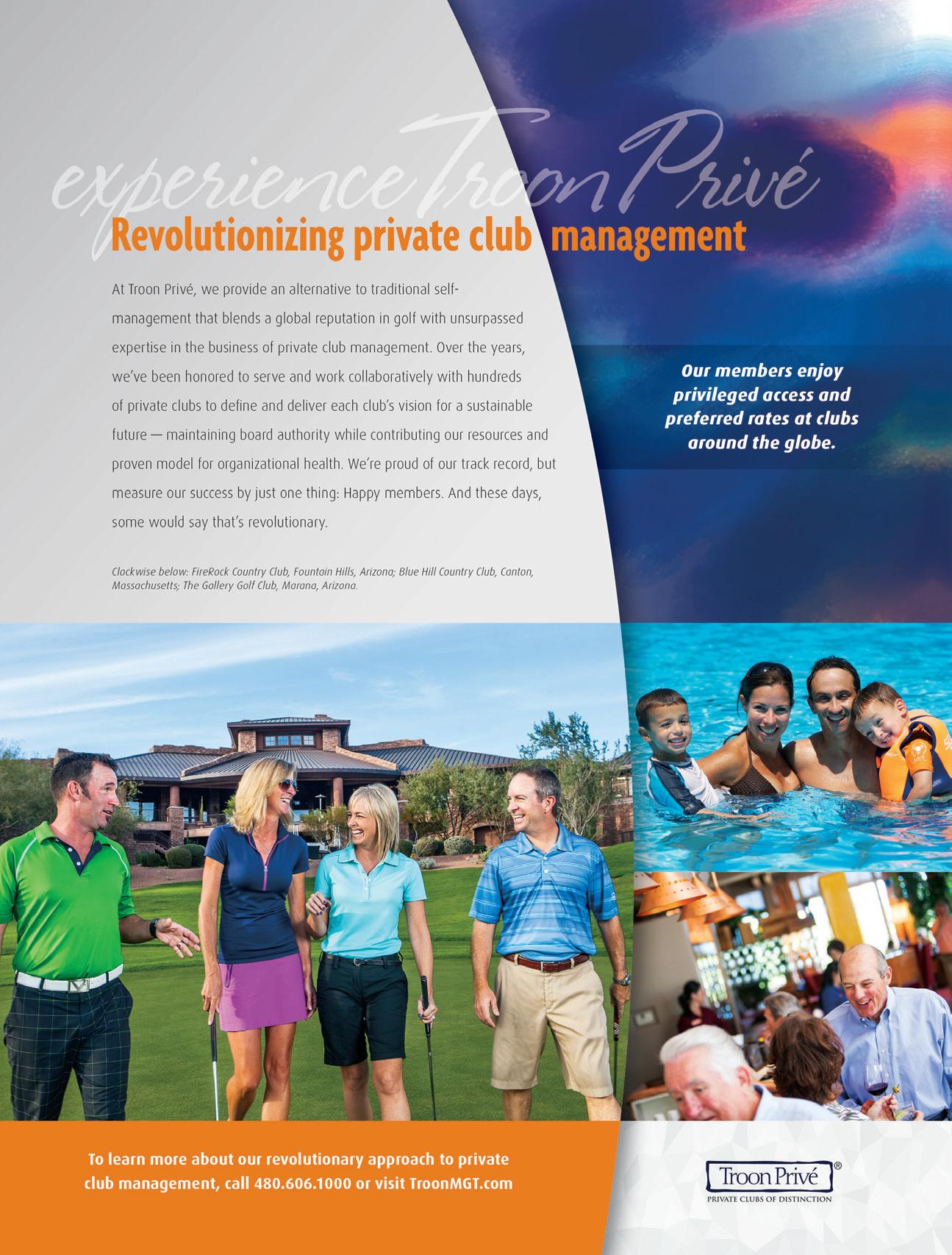
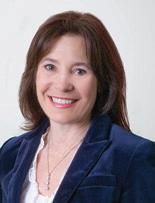
From fine wine connoisseurs to casual wine tasters and everyone in between, many club members are enjoying the opportunity to purchase cases of wine from their clubs and imbibe off club premises.
Club members appreciate the convenience and are cashing in on the savings from their clubs’ volume purchasing power while clubs are improving their bottom line. What could possibly be wrong with this mix?
From the club’s perspective there are two significant issues to consider before venturing into packaged wine sales. The first is whether the particular type of liquor license the club holds permits the sale of alcohol for off premises consumption.
State laws govern alcohol sales and most states have multiple categories of liquor licenses depending on the type of business involved. Many states have liquor licenses specifically for golf clubs and several distinguish golf clubs from other types of social clubs. Most club liquor licenses allow sales of alcoholic beverages only by the drink for on premises consumption with sales generally restricted to members and their guests under specified circumstances.
For example, Florida has the “11C – Club” license. This particular class of license only allows the sale of alcoholic beverages “for consumption on premises by the drink for members and members’ guests only”, and specifically prohibits packaged sales regardless of whether it’s intended for on or off premises consumption.
Sales of alcohol in violation of the terms and conditions of a liquor license could subject the club and the individuals involved to fines, penalties and potentially criminal charges, not to mention suspension or revocation of the liquor license and loss of the right to sell any alcoholic beverage.
If the club’s class of license does not permit packaged sales, consultation with a professional experienced in obtaining liquor licenses is recommended to determine whether another category of license might be available, and obtain the necessary licenses before selling one more bottle.
Secondly, if the club is tax exempt, determine whether the sale of alcoholic beverages for off-
premises consumption is a traditional or nontraditional business activity. If the income from such sales cannot be classified as traditional income, then the tax-exempt status of the club could be jeopardized by packaged wine sales.
Keep in mind that the IRS has defined traditional business activities as activities “exclusively for the pleasure, recreation and other nonprofitable purposes” whereas non-traditional activities do not further these purposes.
Private clubs must remain below the IRS’s thresholds for non-traditional income or risk losing their tax-exempt status. The IRS requires that tax-exempt clubs have “no more than a de minimis amount of income from non-traditional activities,” although the calculation of de minimis is not well defined in IRS letter rulings, documents or relevant cases.
It is unlikely that packaged wine sales for offpremises consumption could be deemed to be a traditional business activity for a tax-exempt club, but the IRS will make that determination on a case-by-case basis. The recent loss of taxexempt status by a number of clubs exceeding the de minimis threshold suggests the IRS is not overlooking the limit on non-traditional activity.
An experienced club tax advisor could assist in evaluating the club’s facts and figures and help the board understand how the IRS is implementing the business activity limitations.
As appealing as it may be to increase club revenue and member goodwill by selling packaged wine for off-premises consumption, careful consideration of the pitfalls of such activity is warranted. First consider whether such sales are permissible under the club’s liquor license and then, if retention of tax-exempt status is desired, consider the impact these sales may have on the club’s tax status. BR
Michelle Tanzer, Esq. is one of four law professionals selected for the American Arbitration’s (AAA) National Golf Industry Panel. She also authored “The Club Litigation Book: Keeping Clubs out of Court.” Ms. Tanzer is chair of the residential, resort and club section at GrayRobinson, P.A. and can be reached at (561) 8665700 or via email: Michelle.Tanzer@Gray-Robinson.com.

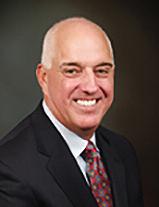
In a very popular episode of the sitcom Seinfeld, George Costanza announces his intention to turn his life around by doing exactly the opposite of everything he thinks is right.
George states, “Every decision I have ever made has been wrong. Every instinct has been wrong. That makes the concept of doing the opposite to be right!”
Unfortunately, almost every strategic decision made by the private club industry has been wrong. It may be time for private clubs to adopt “The Opposite” way of thinking and take a strong look at the following wrong decisions.
Private clubs feel that all clubs can work through this financial crisis by simply cutting expenses. Unfortunately, this strategy has dramatically impacted member experience and membership satisfaction. We are in the “member experience” business and dramatically cutting expenses makes it impossible to provide superior member service to maximize membership retention and recruitment.
The Opposite strategy: Private clubs don’t have an expense problem they have a revenue problem. It is time that private clubs devote the appropriate time and energy to maximizing revenue, or more specifically, dues and initiation fees.
Private clubs are convinced that “the initiation fee is the problem” when it comes to a lack of new members. Consequently, many clubs believe that eliminating their initiation fee will be a successful membership initiative. That could not be further from the truth.
The Opposite strategy: Private clubs must re-establish the fundamental of commanding initiation fees for the privilege of private club membership. These initiation fees should be used for debt retirement and capital project funding. People will pay to join a private club...get your discipline back private club industry!
Private clubs feel that the answer to their revenue shortfall is simply implement a few dues increases and attempt to squeeze a little more money out of fewer people.
The opposite strategy: It is time for clubs to dedicate their efforts to “more people paying less” and to do everything in their power to stabilize the dues structure at their club. The consumer of today demands value in conjunction with a positive experience. Those two concepts can work in harmony, regardless of what private clubs think!
“WE
Private clubs see no reason to ask for assistance from recognized experts in the industry. The belief is they can simply “self-diagnose” their own problems. This type of thinking has been rather catastrophic to the private club industry. Membership retention and membership recruitment is a very complex process.
The Opposite Strategy: It is time to rely on experts to provide the proper expertise and implementation capabilities to make sure your private club is implementing the “best practices” displayed by the most successful private clubs. The most successful private clubs know they CANNOT do it themselves! Membership referral is the cornerstone of all successful private clubs. It is time to educate private club members as to their “responsibility and privilege” of participating in the membership referral process.
It may be time for the private club industry to quit doing what they think makes sense and do “The Opposite.” It worked for George Costanza and it may just work for your club. Call Creative Golf Marketing today to implement a proven strategic plan by a company who has successfully performed marketing consultations/initiatives for over 1,200 private clubs. BR This article was submitted by Steve Graves, President of Creative Golf Marketing. For questions, contact Steve at Steve@CreativeGolfMarketing.com or (800) 526-8794. For more information about Creative Golf Marketing, please visit www.CreativeGolfMarketing.com.
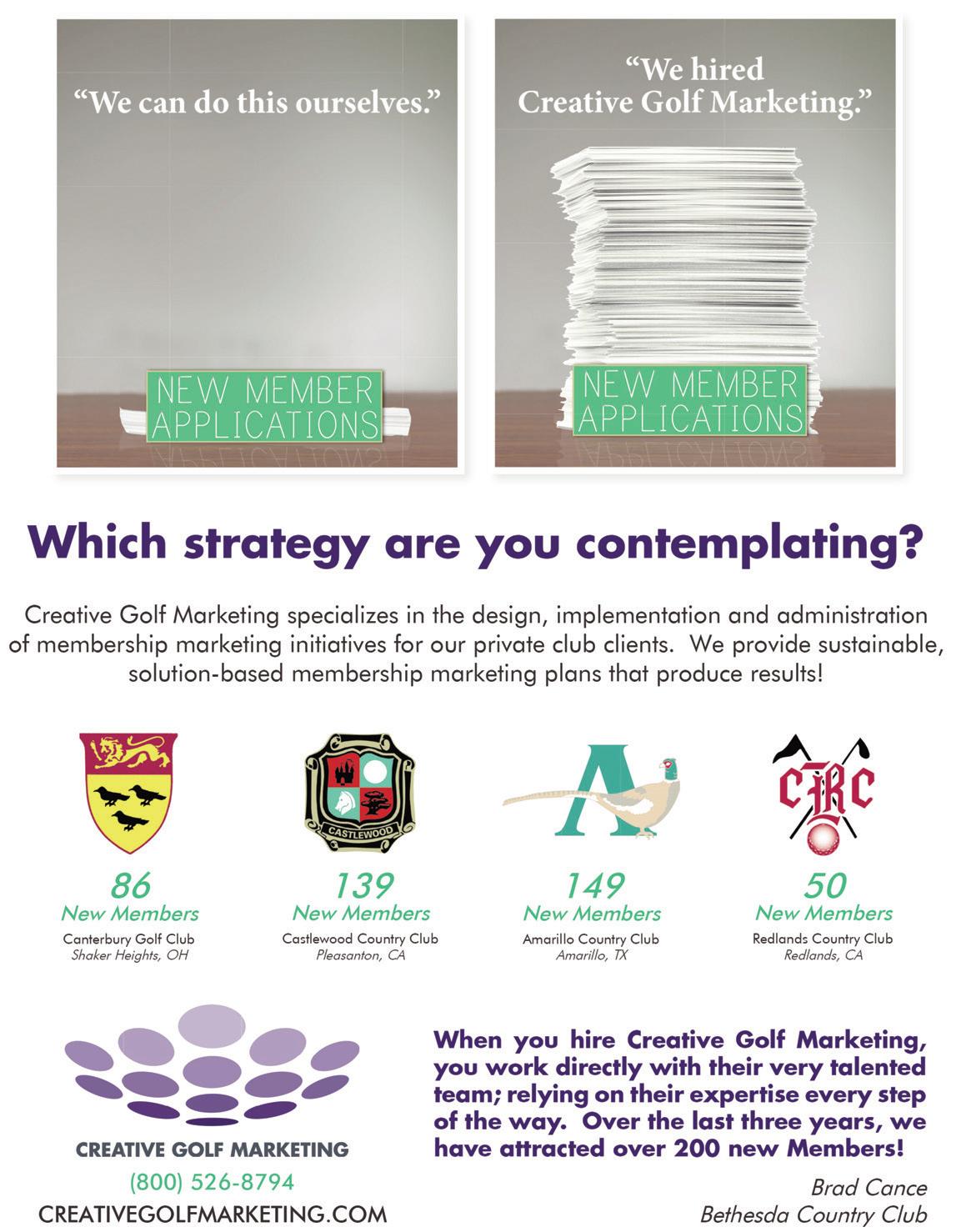
In the world of private clubs, America is fortunate to have many truly unique, historic clubs with truly unique, historic clubhouses.
These facilities often reflect an architectural grandeur that is difficult to reproduce today due to cost and craftsmanship. Many of these clubhouses are recognized as local, state or even national historic landmarks. As a result, it is imperative when considering renovations or additions to these special buildings that all efforts be made to preserve the integrity of the existing spaces and insure any new work is designed in conjunction with established precedents.
One such renovation was recently completed at The Cherokee Town and Country Club in Atlanta, Georgia. The clubhouse was originally constructed as a private residence during World War I. Designed in the Scottish Revival style, this magnificent estate is exceptionally rich in materials and architectural detailing. The estate was purchased by the club’s founding members and became the home of Cherokee Town and Country Club in 1956. Since then there have been six substantial additions or renovations to the building in order the meet the continuing needs of the membership.
The design team of Surber, Barber, Choate & Hertlein Architects, along with Ferry, Hayes & Allen Designers, was commissioned to add a new tavern, along with casual and terrace dining areas to the club. Although these types of spaces already existed, the membership desired a substantial renovation and addition to create entirely new spaces that more closely recalled the elegance of the original home, yet still conveyed a casual style. The club’s main directive, and the design team’s primary goal, was to aesthetically tie one end of the club seamlessly into the other. Insuring the club’s desired seating counts and complete functionality for the members and staff were also key parts of the design equation.
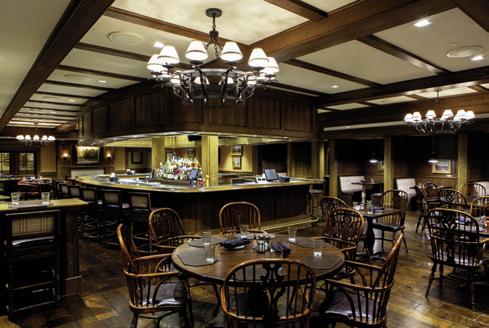
At Ferry, Hayes & Allen Designers, we believe a quality, historic club should be revived with the same kind of spirit as incorporated at Cherokee Town and Country Club. Of course every club project has its own program and budget. Many budgets do not have room for walnut paneling; however, it is incumbent upon club committees and boards of directors to be good stewards of their facilities. Part of that stewardship hopefully includes a conscious effort to maintain the design integrity of those special, historic treasures we are still so fortunate to enjoy.
Club committees and directorships of historic clubhouses should always insist on that design integrity from their design team. And remember, there are many ways that talented architects and designers can recall special design features, materials and furnishings without breaking the bank! BR
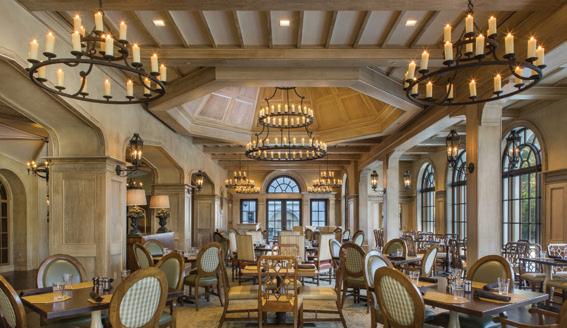



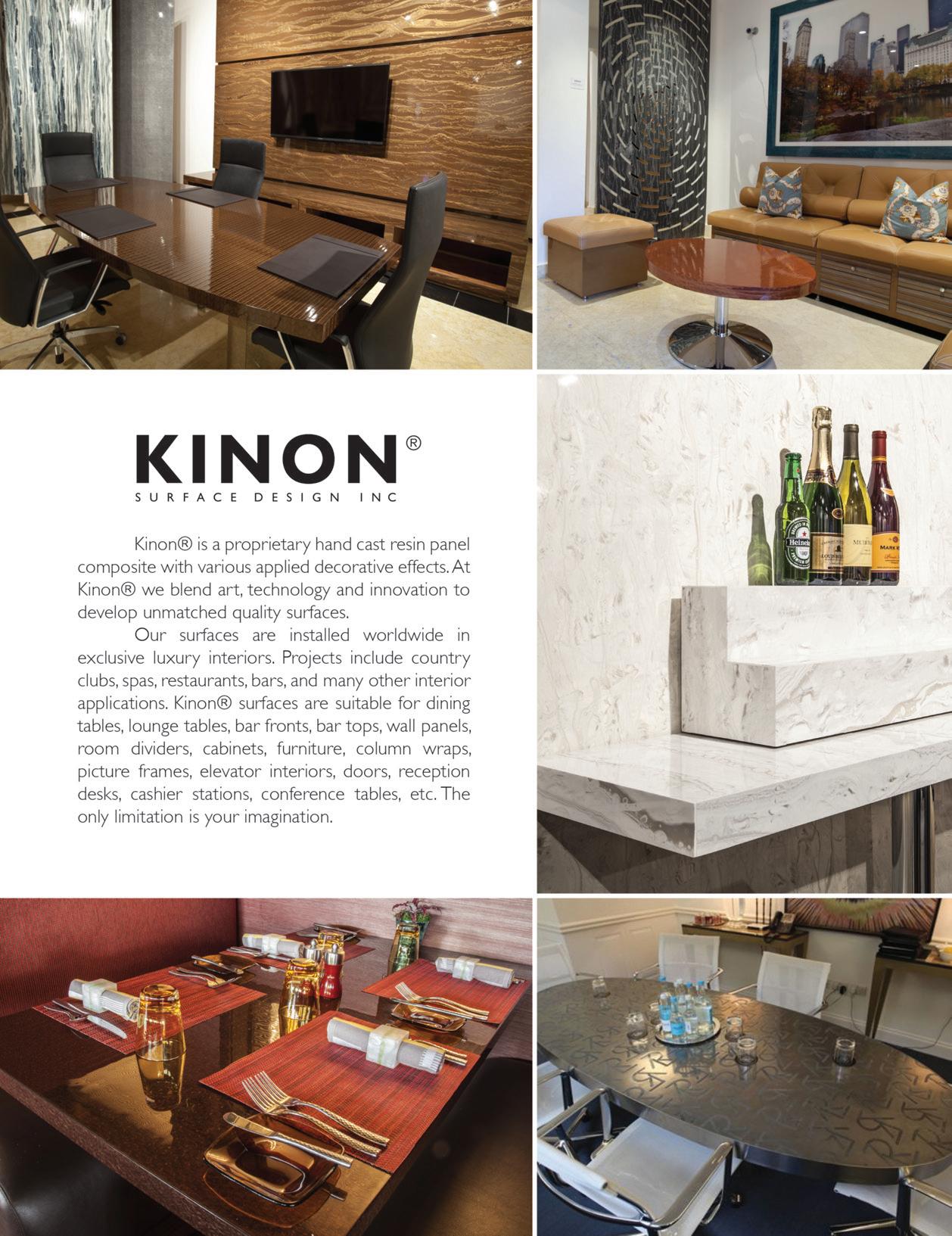

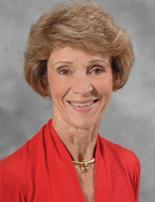
BONNIE J. KNUTSON
Having just finished giving a seminar on delighting the customer, I was standing at the front of a large room, taking off the lavaliere microphone, putting my laptop and other materials in my briefcase.
Out of the corner of my eye, I spotted someone walking, very purposely, up to me. I could tell by the look in his eye that he either had a question or disagreed with a point I had made. Either way, I figured we would be having an interesting conversation.
After the usual obligatory introductions, he cocked his head slightly to the left, pointed his finger towards me, and said, “I don’t believe in all this delighting stuff; I just give the customer what he expects. No more, no less.”
“Oh,” I asked, “Why is that?”
“Because if you start trying to delight customers, you just have to do more,” he answered. “You end up adding to your costs, which takes away from your profits. And the more you do, the more they expect. I stick to the basics.”
In a way, I couldn’t argue with him. There are two things that the attendee missed, however.
The first is to understand exactly what delight is. While our friend, the dictionary, has several definitions for delight, basically, it means making someone really happy.
In business, delight has taken on a narrower meaning that is closely aligned with the term, lagniappe. If you go back in history, lagniappe entered our lexicon from Louisiana French and Spanish phrases that meant a free item, usually cheap. Throughout the years, it has come to mean “a small gift given to a customer by a merchant at the time of a purchase…an unexpected...benefit.”
The operative words here are cheap and unexpected
So the second thing that the person missed is the cost aspect. If you have never seen The Simple Truth of Service video clip, stop reading this now, and go watch it on YouTube at https://www.youtube.com/watch?v=sepARXV 8MRI, then come back.
I’m a huge advocate of lagniapping your members! Because, as the video clips so powerfully shows, lagniapping can be cheap, unexpected, and most importantly effective.

Not long ago, I showed Simple Truth at a CMAA chapter meeting. A few weeks later, one of the managers sent me an email describing how he used it to challenge his staff to lagniappe their members. He then related the story of how a banquet server took his challenge to heart.
The server was breaking down the dining room after a lunch function. Noticing that a fresh floral bouquet had been left on the head table, and knowing that there was a group of four senior women in the next room for their weekly bridge game, he carefully pulled out a quartet of red roses and wrapped each stem in a piece of cotton and foil to keep it fresh.
As a final touch, he tied a small red ribbon around each stem and placed them on a silver tray. With great aplomb, he went into the next room and, kneeling before each lady, presented her with a rose.
As the manager quipped to me, there were smiles, giggles, and smart phones clicking all around. And yes, the ladies all posted the pictures on their Facebook page.
This is a perfect example of delight. It was cheap, unexpected, and it was effective.
Said another way, lagniapping is like having an unpaid marketing department for your club with two great results. First, delighted members sing your praises to friends and family alike.
As the old marketing mantra says, word-of-mouth (or as I say in today’s social media world, word-of-finger) is still a powerful advertising tool. And secondly, the Law of Motivation says that people are motivated to recreate the good times they remember. That’s club loyalty.
There is a well-known Disney story about a little girl who lost her favorite doll in the theme park. A cast member (Disney doesn’t call staff employees, they are cast members) found it, covered in mud.
So they gave the doll a “bath,” washed its hair and even gave it a new clean outfit before returning it to the little girl. Talk about delight! The cast members didn’t refer to a manual nor did they ask a supervisor, they did what they did because lagniapping is part of the Disney culture.
When I get on my soapbox advocating this delight thing, the question I always get from managers is how to get my staff to go above and beyond the call of duty…to see what others don’t see. To do without being told. Every manager knows to hire for attitude not for aptitude, and then reinforce the attitude. But that is often easier said than done. A lot of “how to” articles have been written
about empowering employees, giving them a purpose, not rules, and tapping into their creativity. Most, if not all, of them say the same thing – and they are probably right.
In my mind, however, I like to think about it in terms of finding and hiring the round peg for your club’s square
string pulling the planets towards the sun. He named this string “gravity.” Without them, John Gutenberg wouldn’t have seen that he could rub ink on the bottom of a coin stamp and attach it beneath the plate of a winepress. Replace the coin image with letters and grapes
Said another way, lagniapping is like having an unpaid marketing department for your club with two great results. First, delighted members sing your praises to friends and family alike. As the old marketing mantra says, word-of-mouth (or as I say in today’s social media world, word-offinger) is still a powerful advertising tool.
hole. In other words, look for the person who sees the world from a different perspective for they will intuitively be more likely to see that unexpected delight opportunity.
To emphasize this point, please stop reading again and go back to YouTube to watch two more video clips. The first is a video clip of the famous scene from Dead Poet’s Society in which Mr. Keating (the late Robin William’s character) has his students stand on his desk to see the world differently.
https://www.youtube.com/watch?v =RgWDUKP6Quk.The words he uses to inspire his young charges are a perfect mantra for every club manager.
The second is Steve Job’s the Crazy Ones at https://www.youtube.com/watch?v =8rwsuXHA7RA
It is often said that there is a thin line between genius and insanity. But those that straddle that line are fun to have around because they do see the world differently. They see connections for new possibilities.
Without them, Isaac Newton wouldn’t have seen an invisible
with paper and the printing press was born.
Without them, George de Mestral wouldn’t have seen the cockleburs clinging to his cloth jacket after a walk in the woods as a fastener. Thus, we can fasten jackets, backpacks, and children’s shoes with Velcro.
Every club needs at least one round peg for its square hole to see opportunities to delight members…to lagniappe them… that no one else sees.
So, now, there is one more video clip every club manager should watch. It is Michael Bahr’s Box at https://www.youtube.com/watch?v =5aUJyDC_gT8. He will help you connect the dots.
Your bottom line will thank you! BR
Bonnie J. Knutson Ph.D. is a people watcher. A professor in The School of Hospitality Business, Broad College of Business, Michigan State University, Dr. Knutson is a member of the Country Club of Lansing and the Michigan Athletic Club. She can be reached via e-mail: drbonnie@msu.edu
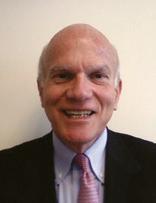
More than 20 years ago Bryan Dyson, then president/CEO of Coca-Cola Enterprises, delivered the commencement address at Georgia Tech.
He used the metaphor of glass balls and rubber balls to describe work/life Balance. His insight is summarized:
“Imagine life as a game where you are juggling five balls…They are work, family, health, friends and your personal spirit of caring and giving. You are keeping all five in the air. Soon you will understand that work is a rubber ball. If you drop it, it will bounce back. But the other four balls – family, health, friends and your personal spirit – are made of glass. If you drop one of these, they will be irrevocably scuffed, marked, nicked, damaged or occasionally shattered…You must understand that difference and strive for balance in your life.”
This is as valuable today when considering work/life balance, especially for general managers (GMs) in the private club industry.
Interviews six GMs about work/life balance, and using that data provides the raw material for how they see the work/life balance.
First, the work demands of a general manager: A GM wears many hats. They are:
• An ambassador – building and strengthening relationships with staff, club members and the board
• A leader – setting and achieving operational goals with the management team
• An available presence – being visible at key member events and easily accessible to staff through individual and team meetings for professional development, and finally
• A board liaison – working with club leadership to achieve results that promote the club and its brand name. It is a big job requiring a significant time commitment of nights/weekends/holidays.
These four “hats” require exceptional, professional juggling skills. Workplace juggling can dominate a GM’s priorities with little opportunity for the personal. One GM commented that he has not had a family Thanksgiving dinner for 15 years! That is work/life imbalance for sure! Many in the industry are type A personalities who address their work demands with energy, care and thought.
Second, the “pulls” of personal/family life: GMs have chosen an extremely demanding and time-consuming profession. That said, the “pulls” for them can be organized around relationships with spouse, chil-
dren, friends and personal interests. All are legitimate “pulls.” One young executive told me that his fiancée broke off their relationship because she refused to organize their personal life around his work schedule – the end of the relationship and their story together. These “pulls” of family, friends and personal spirit are your “glass balls” commanding sustained attention and action.
Third, helpful pathways for achieving work/life balance. There are multiple pathways to balance including:
1. Asking yourself what is the best possible use of my time right now? Multi-tasking is a myth.
Successful executives adopt and accomplish the “Rule of Three” Priorities.
2. Placing family, friends, health and spirit in your priority or number one queue.
3. Defining boundaries away from work.
4. Learning to say “No” to discretionary work; that is, writing your priorities across the page (every action in the No.1 queue) rather than down the page.
5. Using technology – Outlook calendar – to be more efficient and turning off your iPhone. There is no rule that says the GM must be available 24/7.
6. Becoming Buddhist-like by being “present in the moment.” You are observing your child’s game or performance. Enjoy it and forget work! The most successful GM is the one whose club runs better when they are not there.
7. Making “you” a priority in terms of actions, not just words.
8. Recharging energy by sleeping seven to eight hours night.
Achieving work/life balance is hard, requiring discipline to say “yes” to your spouse, children, friends, etc., so perhaps one or more of these eight pathways will help with Balance. The most compelling statement for balance is a reminder from my mother-in-law. She told me that at funerals she attended, the speakers talk about the deceased person’s values, character, friendships and family engagement. No one says anything about work!
In the final analysis, if there is a choice, always try to pick the irreplaceable glass ball over the rubber ball. It will be a win for you, your family and friends! BR
David W. Lacey is Managing Director, HR Services, The Hirshorn Company. He recently completed his second board term at the Philadelphia Cricket Club. He can be reached via email: dlacey@hirshorn.com


By Dave White, Editor, BoardRoom magazine
BoardRoom magazine annually recognizes the world’s top private club presidents, captains and chairs as Private Club Presidents of the Year, for their outstanding work, their understanding of the industry, and role and responsibilities of the club’s board of directors. In this continuing series, BoardRoom introduces four of the top 22 presidents for 2014.
Private club board presidents play a huge role in professional operations of their clubs as a volunteer working diligently with their board of directors and general managers, striving for well informed, but not emotional decisions.
This recognition by BoardRoom magazine has attracted board president nominations from clubs and other nominators around the world.
These outstanding presidents exemplify the focus on the leadership responsibilities, the accountability and the management of the board providing a healthy respect for the club’s macro management. They are cognizant of the importance of working, effectively and efficiently, with their volunteer boards and the dedication required from everyone with whom they work.
Key elements of a “good” board include commitment, competence, diversity, collective decision making, openness, transparency, effective communication with the management and the membership, fiscal responsibility, development and establishment of the clubs’ mission, vision and policy direction, especially through establishment of a strategic plan.
A successful board president draws upon the expertise of other board members, the club’s institutional memory and stewardship of the club’s resources. As well the board president provides new board members and future board presidents with information they need to perform effectively as board members.
Congratulations to these outstanding private club board presidents.
Five club president profiles on page 58 and 59
Sponsored by

Who is your choice as the top private club board president?
Many people and companies associated with the private club industry are given due recognition for their accomplishments, and now BoardRoom magazine is focusing on selection and recognition of the Private Club Board President of the Year .
BoardRoom magazine, through a nomination and selection process, will honor 20 board president finalists worldwide and one prestigious Private Club Board President of the Year Award.
The top 20 private club board president finalists will be selected by a BoardRoom committee comprised of industry experts and sponsors, who can make an expert judgment, who have an understanding of the industry, the structure of the board of directors, and the role and responsibilities of a club’s board of directors. A third party accounting firm will audit results.
A special section published in BoardRoom magazine will be devoted to the announcement of the top regional club presidents and the “Private Club Board President of the Year.”
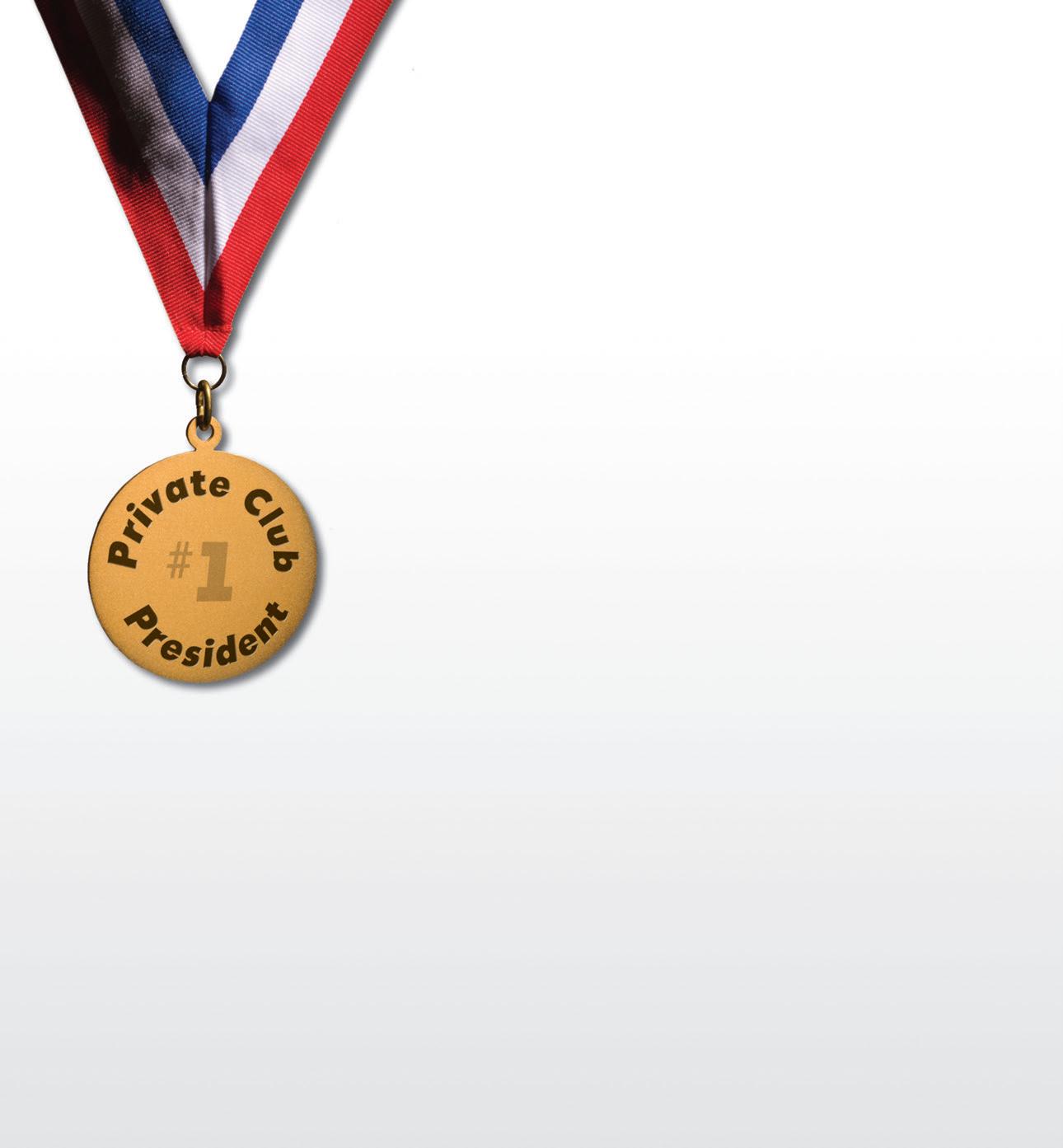
Entry and Deadline
Visit www.boardroommagazine.com to download the criteria and application form. Entries must be submitted no later than Thursday, November 17, 2015. For further information contact John Fornaro (949) 376-8889 ext. 2 or johnf@apcd.com
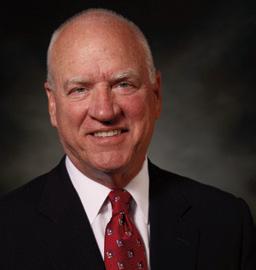

Beau Anders, a Duke University alumnus and dedicated leader in the financial world for over 35 years, moved to The Landings Club near Savannah, Georgia with his wife Chris upon retiring in 2009.
Immediately he took on an active role in the club, serving on the finance committee and participating in other activities for both the club and the homeowner’s association before his election to the board in 2012. He assumed the role as the club’s president in 2014. Under his leadership, a remarkable amount of work has been accomplished positioning The Landings Club for strong growth, says the club’s executive director Steven Freund.
The presidency under Anders has been a year focused on improving member communication, as well as the quality and curb appeal of the club for current and future members. As well, many vital areas have been upgraded, renovated and enhanced with member preferences in mind. These include:
Renovation of the Plantation Ballroom and restoration of the exterior of the Plantation Clubhouse
• Renovation of the Palmetto golf course
• Deployment of new operating software and replacement of the club’s entire technology platform
• A redesign the club’s membership categories to align costs and membership offerings with market demand.
Along with executive director Freund, president Anders led a multi-generational facilities master plan development team over a seven-month period that created a 10-year major capital plan for member consideration.
Recommendations include replacement of one of the clubhouses, significant expansion of the 48,000 square foot fitness and wellness center and addition of a new mid-island grille to address the demand for more casual dining.
“The most important work president Anders has undertaken is in leading the planning committee with the charge to ‘reimagine’ The Landings Club,” explained Freund.
“He has demonstrated respect for the club that his predecessors and past members have built while casting a compelling vision for the future of this amazing club.”
The Landings Club, located 12 miles from historic downtown Savannah, Georgia, began with the Marshwood clubhouse and a single golf course in 1974.
Today, The Landings Club is home to over 3,000 active member households who enjoy access to six championship golf courses, two marinas, 33 tennis courts, seven restaurants, five swimming pools and an innovative fitness and wellness center.
In addition to Anders’ board duties, he and his wife Chris are active ambassadors welcoming sales guests to the island. They are avid golfers, generous volunteers and frequent participants in myriad club social activities.
All this of course, makes The Landings Club well positioned for the future because of Beau Anders’ remarkable leadership in 2014. BR
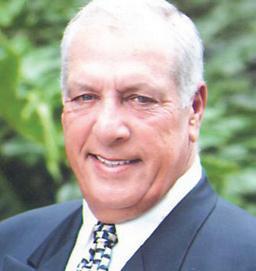
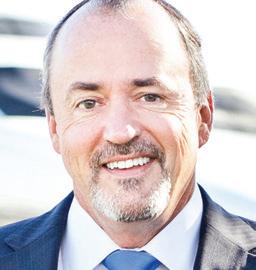
The Club at Admirals Cove is an extraordinary residential club, situated on the sparkling blue intracoastal waterways of Jupiter, FL.
As one of BoardRoom Magazine’s Distinguished Emerald Clubs of the World, The Club at Admirals Cove is known for its unbeatable combination of golf, yachting, tennis, dining, boutique inn, fitness, spa, salon, amazing pool complex, and perhaps most importantly, its personalized service.
With a diverse and active facility, it is only appropriate that its president be just as exceptional.
President Bernie Carballo is a business leader with golf management experience. Having had high-level business experience in the field of technology (including senior management, operations, and marketing), real estate development and private club management himself, Carballo
fully understands the role of the club’s board as the policymaker. This allows long standing general manager/CEO John Herring to manage this multi-faceted facility with discipline, integrity and efficiency.
As a young émigré from Cuba, president Carballo built a life for himself “from the ground up.” He appreciates the value of hard work and takes nothing for granted.
That is why his goal during his tenure on the club’s board has been to fulfill the club’s mission in a fiscally responsible manner, yet still find ways to inspire change to make it even better. He served on the board for the last six years (and on committees a number of years previously), and has been a strong supporter of the strategies that allowed the club to escape unscathed through the “Great Recession.”
Most recently, president Carballo led the charge to gain equity member approval for a $19 million dollar project that includes renovation of the 27-hole Golf Village golf course and all new floating docks at the Admirals Cove marina. This followed on the heels of the club’s $14 million dollar renovation in 2012.
The best way to explain president Carballo’s leadership success is by getting to know him, says CEO Herring. “He’s one of the most charismatic people I have ever met.”
All the more reason why Bernie Carballo is one of BoardRoom’s top president for 2014, and all the better to enhance the member experience and maintain the club’s status as a BoardRoom Distinguished Emerald Club of the World BR
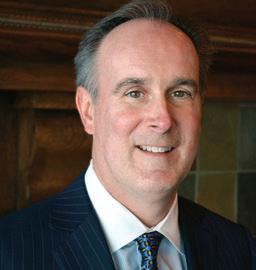
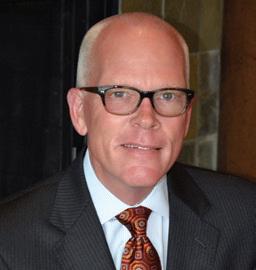
Joe Buska assumed the presidency of Interlachen Country Club at a most challenging time in the club’s storied 105-year history. As a result, the Edina, MN club is in an exceptional position heading into the future.
President Buska, a member at Interlachen since 1995, demonstrated his unique ability to achieve consensus with the club’s board of directors at a pivotal time, because the club was faced with an aging infrastructure and an ungainly-sized board that hampered the club’s decision making.
There also has been a restructuring of the club’s capital program aimed at enhancing its aging club assets, including a new ongoing monthly capital contribution fund.
Buska, a two-term board member, championed a series of governance strategies including a reduction in the board members from 15 to nine members. He also delivered a well thought out “Operational Charter and Governance Policies” document clearly outlining the roles and responsi-
bilities of the board, its committees and the club’s general manager. The club’s nominating committee has also been repositioned so that it controls the bylaw-mandated election process as opposed to having new board governors elected by a popularity contest. President Buska also guided the club through a transitional period by developing and implementing a succession plan for the club’s long time general manager, George Carroll, who retired. Through this process the club hired a new general manager, Eric Dietz, which positions the club well for the future.
Joe Buska continues to be a passionate, visionary leader for Interlachen Country Club. He truly is a consensus builder, deeply passionate leader who, although he has completed his term as president, is leading the charge and chairing the club’s long-range, strategic planning committee.
The objective is to position the club to not only maintain its relevance in the Twin Cities area, but also to continue the long standing tradition of providing a championship venue for tournament golf.
“President Buska is a consummate professional,” explained the GM Dietz, “both at the club and in his personal life. He’s a tireless advocate of local charities, who finds the time to not only serve his club, but who also volunteers for local organizations. He’s been an outstanding president, a great friend and mentor,” added Dietz.
“A club manager couldn’t ask for a more passionate, caring, thoughtful president who genuinely takes an interest in his club, his community and, of course, his family.”
Buska, a graduate of the University of Minnesota, and his wife Mary, are parents to Monika, Alexandra and Justin.
It’s for these many reasons that Joe Buska is one of BoardRoom’s top presidents for 2014. BR
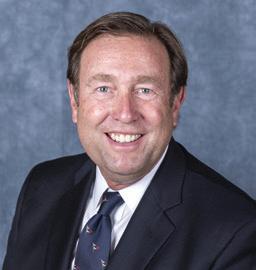
JIM
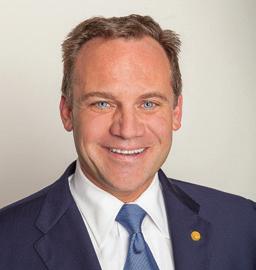
When Jim Diepenbrock became chair of the St. Francis Yacht Club board of directors in 2014, conventional wisdom held that it would be a difficult year for the club. The year before, after all, the 34th America’s Cup, yachting’s most-watched racing event had taken place just outside of the St. Francis Yacht Club, drawing tens of thousands of spectators. Both membership and revenue hit new highs.
“Everyone assumed our budgets would be out of whack without the winds of the America’s Cup at our back. But the absolute opposite occurred,”says Diepenbrock.
Financially, St. Francis Yacht Club, a BoardRoom Distinguished Emerald Club of the World, performed on par with the Cup year with the membership retention rate at 99 percent.
Diepenbrock’s primary objective for the year was membership retention, which he achieved through emphasizing membership experience. “The metric
I look at when measuring member experience is club utilization,” says Diepenbrock. And the club’s 2,600 members were definitely using their club.
In 2014, the St. Francis Yacht Club hosted over 145 days of on-thewater racing. The dining facilities served over 120,000 meals and there were six cruises and over 50 events, almost all of which were sold out.
When it comes to day-to-day operations, Diepenbrock entrusts an enormous amount to the club’s staff. “We hire very good people and give them the authority and autonomy they need to do their job well. I encourage them to take risks and do the things they think are best for the yacht club.”
Ron Banaszak, chief operating officer and general manager, attests to this. “Jim Diepenbrock supports me and my team. He exemplifies what it means to be a strong volunteer leader of a private club. He is extremely supportive of the management team and every decision he makes is in the best long term interest of the club.”
Diepenbrock says the St. Francis Yacht Club is honing in on the 40 to 50-year-old demographic. “In the old days, dad would escape to the club for the weekend and come home for dinner Sunday night. It doesn’t work that way anymore. Now, the club needs to be able to engage the whole family.”
Throughout 2015, he and Commodore Sean Svendsen (who happens to be a member of the target demographic) are working with management to provide initiatives focused on health, the environment and the family.
Looking back at 2014 he says, “We were able to execute a perfect year. We believe it was one of the best years in the club’s history.” BR

As we know, supplier and consultants are the backbone of the private clubs industry, because without their products and services, private clubs would find it extremely difficult to meet the needs and wants of their club members…in fact, everything would likely come to a standstill.
So there's no better way to recognize the suppliers, consultants and educators for their accomplishments and fine contributions to the private club industry than the peer-recognized BoardRoom Awards .
The BoardRoom magazine “Excellence in Achievement” Awards is the only private club industry award that recognizes the clubs’ business partners. BoardRoom magazine’s industry peers review and select these outstanding suppliers and consultants, which represent various aspects of course and club operations. Winners, each year, are selected for overall excellence in their respective fields, achievements, innovation, vision for future growth and continued impact on private club operations.
"Each of the recipients of the BoardRoom magazine “Excellence in Achievement” Awards are clearly leaders in their respective industries," said John Fornaro, publisher of the BoardRoom magazine.

BoardRoom magazine’s Lifetime Achievement Award is recognized as one of the private club industry’s most prestigious. The Lifetime Achievement Award is presented annually to those who have served the industry with distinction, honor and integrity.
John Fornaro, chief executive officer, the Association of Private Clubs and Directors and publisher, The BoardRoom has chosen the distinguished winner each year. Criteria for Lifetime Achievement Award candidates include: how each candidate has helped the private club industry; how they have impacted the industry and how they should be remembered for their contributions to the industry.
The three recipients for 2014 – George Carroll, Linda Carroll, and Henry DeLozier received their Lifetime Achievement Awards at a presentation recently during the CMAA World Conference in San Antonio. This marks the first time in the history of this award that there are multiple recipients in the same year.
The achievements of George and Linda Carroll are outlined in this issue in a story written by Jim Singerling. A feature story about Henry DeLozier will be published in our May/June issue.






The BOARDROOM magazine is now accepting entries for its 2015 "Excellence in Achievement" awards. The awards recognize both vendors and educators for their impact, achievements and contributions to the club industry. All award entries and nominations must provide supporting materials to be reviewed by an independent panel of industry experts representing various aspects of course and club operations. Winners are selected for overall excellence in their respective fields, innovation, vision for future growth and continued impact on private club operations. Winners in each category will be featured in an issue of The BOARDROOM magazine in 2016. For more information, call (949) 376-8889 or email John Fornaro at johnf@apcd.com. All entries must be received by 10/31/2015.
GOLF COURSE: Course Architect (new course), Course Architect (renovation), Course Contractor/Developer, Irrigation Company, Course Equipment Manufacturer, Course Maintenance Company, Golf Cart Company, Turf Maintenance, Fertilizer and more
CLUBHOUSE: Clubhouse Architect, Clubhouse Builder, Clubhouse Interior Design, Master Planning, Fitness Consultant, Fitness Equipment, Furniture Manufacturer, Outdoor Furniture, Outdoor Cooking, Kitchen Equipment Manufacturer, Food & Beverage, Banquet Equipment, Pro Shop Interior Design, Menu Design, Amenities Provider, Apparel Provider, Clubhouse Signage, Tennis, Lockers, Club Service, Event Equipment, Construction and more
TAX, LAW, HR & FINANCE: Executive and/or Department Search, Finance, Insurance , Law, Strategic Planning, Tax Consultant, Payroll, Research & Data and more TECHNOLOGY: Software Developer, Technology Product, Website, Communications, Mobile Technology, Social Media, Online Reservations and more MARKETING& MEMBERSHIP: Advertising, Marketing or PR, Membership Marketing, Photographer, Private Club Marketing and more
OTHER: Lifetime Achievement, Jim Singerling Leadership, BoardRoom magazine Dedication, International Leadership, Gary Player Educator, The Jay DiePietro Vendor, Apparel Company, Association Program, Association, Club Management Company, Consultant Company, Club Services Association, Developer, New Product, Purchasing Services Group, Research and Data, Real Estate, Winery and more
Category:____________________________________________________________________Company:______________________________________________________________________
Nominating (if different from above):______________________________________________________________________________________________________________________
Include the following supporting materials: 1) A one-page explanation of why the product/service/company deserves to win its category in 2015, 2) media kits, 3) press releases, 4) testimonialsand 5) marketing materials.
Mail entry form, supporting materials and $50 processing fee per entry to: The BoardRoom magazine “2015 Excellence in Achievement Awards” PO Box 9455, Laguna Beach, CA 92651 or FedEx to 1100 South Coast Highway, Suite 309, Laguna Beach, CA 92651





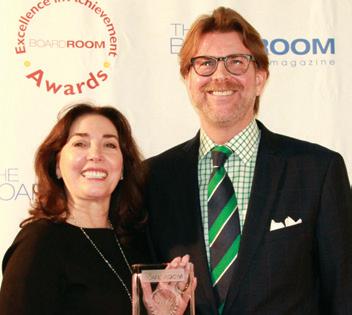
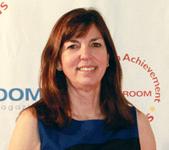
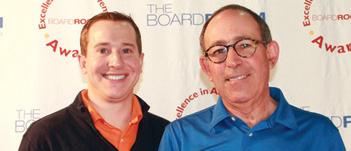
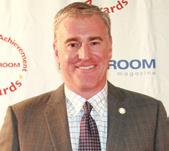

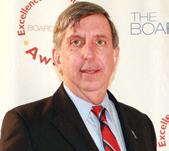


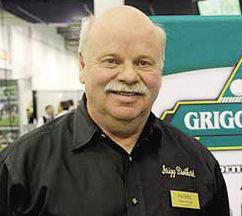






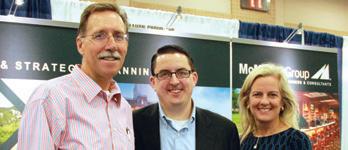
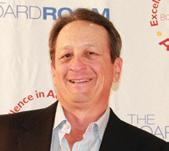
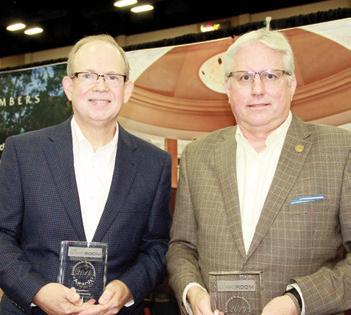
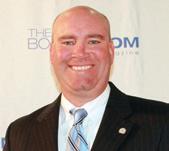
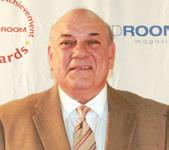
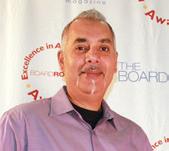
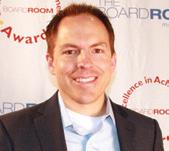
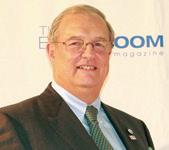
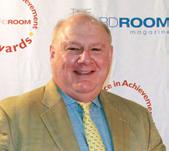
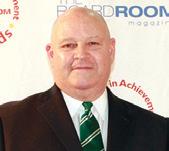




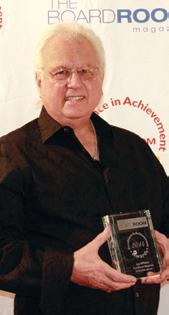
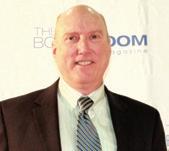
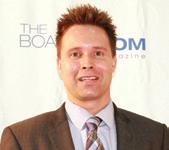
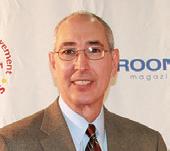

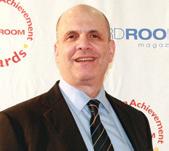

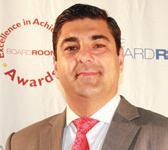
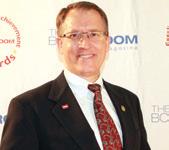
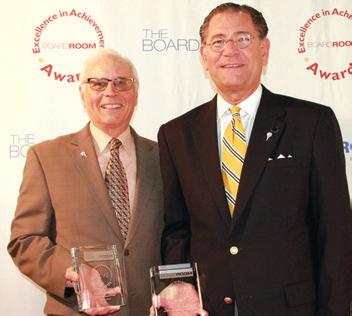

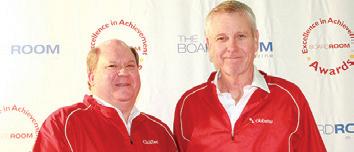
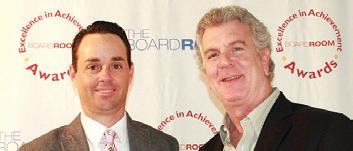
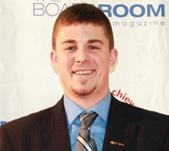
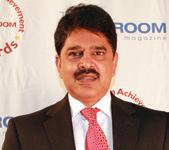
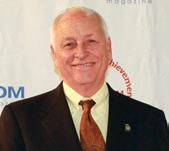

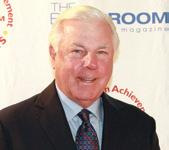

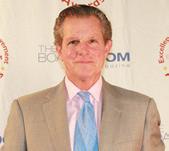
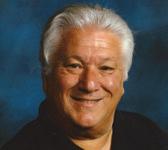

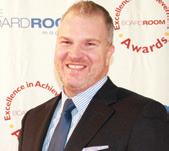





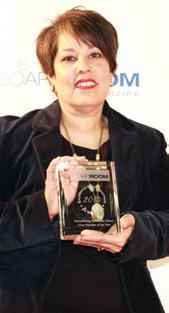
BY JIM SINGERLING
When we talk about ‘Lifetime Achievement’, we are generally thinking about something that no one ever intended to happen. It just happened…recognition of and for something achieved throughout one’s life.
When I was asked to write about these two industry leaders, I had to step back and gather my thoughts. Shall I talk about the fact that – if I leave my much younger wife, Molly, out of the equation – the three of us (George, Linda and I) have been on this earth about 190 years. I certainly should be able to find something embarrassing to say about these ‘legends’ with 190 years of ‘stuff’ to filter
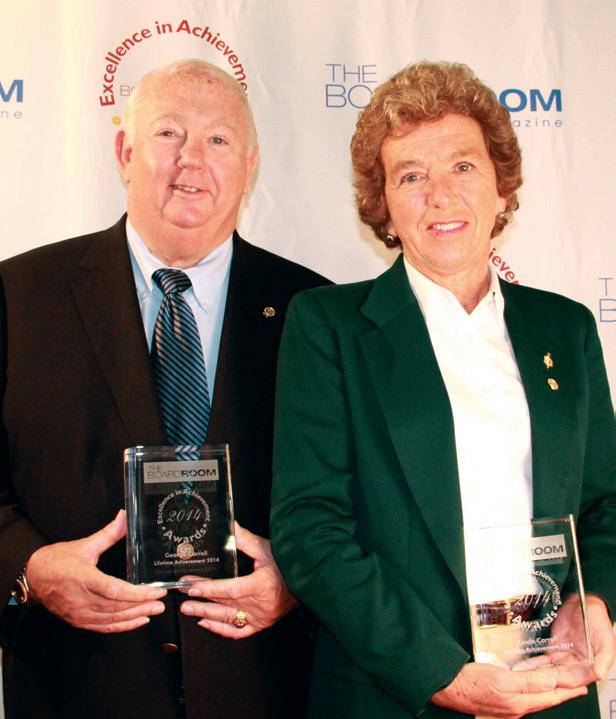

through, but I knew that this would need to be a collaboration.
Not only would I need my personal recollections, but also I would need the thoughts of others who clearly understood the gravitas of Linda and George upon our collective lives.
I know for a fact that George has caused enormous anxiety for the golf course superintendents and building engineers with whom he has worked during his decades-long club industry career (not to mention the anxiety George has caused Linda during this same period).
Although you may say, “But George seems like such a quiet docile sort of fellow.” Well let me tell you, still waters run deep!
George would strike the fear of God in the staff when Linda and George returned from a trade show or a CMAA Chapter visit. Reason being, if George took his camera with him on a trip every staff member knew that within hours of George’s return to the club, all department heads had pictures (from his little camera) of something that would make their operation at the club, (in George’s mind) BETTER.
It may be, for example, the picture of the men’s room door at the Ritz Carlton where George challenged the general manager of the newly opened property on the use of the word MEN on the door.
“Why do you have MEN and WOMEN on the doors of your restrooms?” George asks. The manager replies, “Why do you think? …so that everyone knows which facility to use. Why would you ask?”
Answers George, “Well, I have carried a card in my pocket for years titled ‘Ritz Carlton Creed.’ Within this creed you profess that you are ladies and gentlemen serving ladies and gentlemen. If you only have ladies and gentlemen working and frequenting your property, why not title the two rooms for Ladies and Gentlemen?”


The GM thanked George for the observation and the rooms were retitled. A small issue you may think, however it is the little things, the oft forgotten ‘touches’ that establish the difference we all aspire to rise above.
Linda and George have always cared enough to notice those ‘touches’ and share them with anyone who shared their passion for life.
There would be many examples offered by hundreds of individuals in the hospitality industry, the golf course maintenance profession, the aspiring young professionals and the seasoned “old dogs” from chefs to corporate CEOs and clergy who have seen Linda and George as advisors, counselors and most cherished friends.
I suggest to you that the reason for the broad-based fan club that George and Linda have amassed over the decades is because of the diverse fields of interest that the two of them share. Not just in the industry that they have dedicated their lives too, but I am talking about everything that they see and experience.
It could be about a place they visited and always about the people that they engaged in conversation, generally over some sort of libation. (Canadian beer or fine glass of port for George and a Macallan 12-year single malt scotch for Linda).
Or it may be George’s commitment to the Catholic Church, although it must also be about the people they both know within the church. George and Linda know more Catholic priests, monsignors, bishops, archbishops and cardinals than anyone I have ever met. And they stay in touch with all those clergy still living.
Or it might be about a conversation around a hockey player or team that they knew and (at times) allowed to take a bedroom in the Carroll’s apartment until the aspiring player found out if he was going to be cut from the team.
Without question, Linda and George Carroll have done the absolute most to expose the world to the club management profession and the role of a professional club manager. In doing so, this dynamic duo also made everyone from the British Isles to the South China Sea aware of what CMAA can mean to their lives as professionals.
Here are some of the comments from colleagues with whom Linda and George have shared their lives.
As is so very often the case in CMAA, professional relationships evolve into enduring friendships, the kind that when you meet again, you can pick up the conversation where you left off. So it is with George and Linda. The Carroll surname derives from the Gaelic ‘O Cearbhaill’, meaning ‘warlike champion’ or ‘valorous in battle’, a description befitting their pioneering and generous spirit to share the value of the CMAA experience with the world.
It is a journey that has exceeded all expectations and enjoyed global reach. However, most of all, I have treasured the simplic-

The achievements of George and Linda Carroll are many, and not the least is the fact that both at one time in their careers served as president of the Club Managers Association of America.
That’s a rare happening, a married couple, and general managers at different clubs, who made a serious commitment to the CMAA, both of whom led the organization as the elected president.
George, a member of CMAA since 1979, first served on the CMAA board of directors in 1988. He was also on CMAA’s executive committee as secretary-treasurer in 1994, and vice president in 1995 before taking over as the national president in 1996.
At the time of his recent retirement, George held the position as chief operating officer/general manager of Interlachen Country Club in Edina, Minnesota.
He also served on the Club Foundation board of governors while a club general manager, and was appointed as the Club Foundation’s new chief executive officer in February 2015.
Linda joined CMAA in 1983 and during her tenure served on various national committees. She took the reins of CMAA as the national president in 1980.
During her lengthy career, Linda managed Somerset Country Club before taking over as general manager of White Bear Yacht Club, Dellwood, MN in 1989, a position Linda held until her recent retirement as a club manager.
So how and did these two general managers find time for themselves away from their clubs?
“We planned date nights when we could, and also took advantage of the winter months to do some traveling, which gave us time to steal ideas from other clubs, and strike other things off our bucket list,” the couple remarked.
Needless to say they’ll have more things and places to strike off their bucket lists with their retirement from the daily happenings as general managers.
ity of a great meal shared in Dublin on one of their regular visits home, which invariably leaves you looking forward to the next encounter! – Helen Fullen from Dublin, Ireland, who administered the first CMAA BMI Education outside of North America
And from a fellow past-president of CMAA to the only wife and husband to serve separate terms in the role of elected leader of CMAA: I have known George and Linda for as long as I have been a member of CMAA. I have served with both George and Linda on CMAA and Club Foundation boards over the years, and have had the pleasure of traveling all over our United States and the world with George and Linda. I am privileged to have them both be in my life…so many stories to tell and so little space – spa boy, double wiener award winners, creation of the International CMAA group, founding member of CMAE, BMI Internationals and the list goes on. Thank you George and Linda for your friendship and service to CMAA. You are the ultimate CMAA “power couple!” – Michael G. Leemhuis, president, Ocean Reef Club, Key Largo, FL

I have known George and Linda for as long as I have been a member of CMAA. I am privileged to have them both be in my life…so many stories to tell and so little space – spa boy, double wiener award winners, creation of the International CMAA group, founding member of CMAE, BMI Internationals and the list goes on. Thank you for your friendship and service to CMAA. You are the ultimate CMAA “power couple!”
– Michael G.
Leemhuis
There is no shortage of individuals willing to offer their personal relationship with the Carrolls, certainly no one who has known them for more than 40 years, as has Dick Kopplin - “I have often referred to George and Linda Carroll as the “power couple” in the private club business. Not because they sought power or recognition but because we sought them out as leaders in our industry. They are two of the most respected people in our business. I have had the privilege of calling them my closest friends for the past 40 years. They continue to teach us what integrity, professionalism and gravitas is all about. Look up leadership in the club management dictionary and you will see a picture of George and Linda Carroll.”
While the Carroll’s efforts to take CMAA’s level of professional development and education to Ireland marked the first time this was offered outside North America, our neighbors to the north have participated and supported CMAA’s relationship with the Canadian Society of Club Managers for many years.
A CSCM past president, John Adams, COO/GM of the fabled Sunningdale Golf and Country Club in London, Ontario for decades shared one of the
many experiences and his own recollection of Linda and George’s presence at the CSCM’s annual conference.
For as long as I can remember, the President of CMAA has always been invited to attend The Canadian Society of Club Managers annual conference. The year that George was CMAA president, not only did both he and Linda attend, they also participated in each and every part of the conference, education sessions and the social components.
They also sat in during our AGM. Normally this meeting is a rather quiet affair, however this particular session became rather heated as debate raged on between two groups during what was unfolding as a changing of the guard. Sitting beside George and Linda, I was impressed at how well they maintained their ‘neutral observer status’, despite efforts by several former presidents to draw them in to the discussion. Many others would have been drawn in to a nowin debate that would have had an awkward outcome.
Over the many years I’ve known George, he has always been a man of few words, but when he does engage, it is always well thought out and timely. This occasion was a great example on the part of two people who know when and how to communicate best.
I had the pleasure of chatting with George and Linda the year he had retired, and asked him how that was going. He said that it felt “as if he had lost his identity.” In my opinion, George and Linda will never lose their identities. They both set an example for others to try to duplicate, as club managers and as contributing members of their association.”
Lastly my wonderful spouse, Molly reflects on Linda and George as a part of our family life. As the CEO of CMAA for the past 25 years, I often listened to the spouses of CMAA members to hear ‘the rest of the story’, as Paul Harvey so aptly stated.
When I think of Linda and George what immediately comes to mind is their devotion to friends and family. Linda and

George truly are the essence of what a friend is, and ask for nothing in return. From my earliest days with Jim they made it infinitely clear that they loved me for who I was and when Abigail and Hannah arrived on the scene Linda and George continued that same sense of caring by coming to absolutely everything that was meaningful in our lives.
In the Singerling’s world a celebration could never be one if it wasn’t complete with the Carrolls. This also holds true for sad times as well. I tear up every time I remember seeing the two of them come charging through the door at Potomac Presbyterian Church at my mother’s memorial service.
A true friend shares in not only the happy times but also when you feel lost or alone. To me there are no two people in the world that define the true meaning of friendship more than Linda and George Carroll. – Molly Singerling
When it comes to any lifetime achievement, be it an award or a personal achievement into which an individual has put their heart and soul, it will remain another chapter in one’s Book of Life.
Try as you might to plan it and make a “goal” of it, this lifetime achievement will actually be viewed, analyzed and awarded by those who have shared the chapters of your life book. I encourage everyone to make the most of your time with your colleagues, your friends and those who you may not draw closely, as your book of life is being written every moment of every day.
George and Linda Carroll are
- Dick Kopplin




As I have often opined (upon advice from my grandfather), “Leave the woodpile higher than you found it.”
That’s what lifetime achievement is about and BoardRoom magazine’s 2015 Lifetime Achievement Award recipients – George and Linda Carroll – have certainly achieved that measure of success. BR
Jim Singerling, a friend and colleague of George and Linda Carroll, recently retired as CEO of the Club Managers Association of America.

Renaissance Club Advisors is leading the way in all disciplines of hospitality consulting services for the United States and the Caribbean. We will analyze and consult on club and property offerings, operational procedures, revenue generation, agronomics, key personnel, candidate recruitment and selection, and staff training - we will “secret shop” the competition, as well as your facility, if so desired.


With the change in power in the Senate, a new session of Congress and a group of newly-elected Congressmen, Washington, DC, is a different place. Notice, the choice of words, it is not a more productive place.
Given the current balance of power between The White House, the House of Representatives and the Senate, governance will be a balancing act for the next two years. It will be a great opportunity for citizens to brush up on our understanding of the checks and balances on which our government is based and documented by the Constitution.
Both houses of Congress have kicked off another round of assaults on the Affordable Care Act (ACA) . There are multiple new bills that challenge individual tenets of the expansive law, as well as the entire law itself. Here are two to watch:

In his State of the Union address on January 20, President Obama outlined an ambitious and aggressive strategy on a number of areas that could impact the club industry. Building onto what was already expected in the regulatory arena, it could serve to be a very bumpy year.
HR 30 - Save American Workers Act of 2015
–Introduced by Representative Todd Young (R-IN), this bill would repeal the Affordable Care Act definition of “full-time employment” as 30-hours and restore the traditional 40hour workweek as it pertains to the minimum essential health care coverage required under the employer mandate. This measure has
already passed the House of Representatives by a 252 – 172 vote on January 8, and has been referred to the Senate Finance Committee for further consideration. In addition, the Senate Health, Education, Labor and Pensions Committee held a hearing on January 22 on this issue as well to consider the current system of employer provided health care.
HR 248 - American Job Protection Act –Introduced on January 9 by Representative Charles W. Boustany, Jr. (R-LA), this measure would repeal the entire employer health insurance mandate from the ACA. The bill is currently awaiting consideration in the House Committee on Ways and Means.
However, the Presidential veto threat looms on both these measures. It is unlikely the President will sign anything that he deems to weaken the original intentions of the ACA.
In his State of the Union address on January 20, President Obama outlined an ambitious and aggressive strategy on a number of areas that could impact the club industry. Building onto what was already expected in the regulatory arena, it could serve to be a very bumpy year.
The new updated overtime regulations are overdue from the Department of Labor. Based on indications from DOL, these regulations were expected in February. Expectations are that there will be substantial changes to the existing overtime regulations for executive, administrative and professional employees under the Fair Labor Standards Act.
In the meantime, OSHA’s latest regulations are now in effect as of January 1, 2015. Now clubs are required to notify OSHA of work-related fatalities within eight hours, and work-related in-patient hospitalizations, amputations or losses of an eye within 24 hours.
Previously, employers were not required to notify OSHA of these types of injuries. However, the new regulation lacked clarity for employers
on what constitutes an amputation or sight loss. In an interpretation letter, OSHA has sought to provide clarity on these important questions.
“An amputation is the traumatic loss of a limb or other external body part. Amputations include a part, such as a limb or appendage, that has been severed, cut off, amputated (either completely or partially); fingertip amputations with or without bone loss; medical amputations resulting from irreparable damage; amputations of body parts that have since been reattached. Amputations do not include avulsions, enucleations, deglovings, scalpings, severed ears, or broken or chipped teeth.”
Most interesting, OSHA suggests relying on the diagnosis of a health care professional to determine if the injury fits this definition.
“Loss of an eye is the physical removal of the eye, including enucleation and evisceration. Loss of sight without the removal of the eye is not reportable under the requirements of section 1904.39. A case involving loss of sight that results in the in-patient hospitalization of the worker within 24 hours of the work-related incident is reportable.”
Further, “The reportability of the loss of an eye is not determined by the type of medical care received to treat the injury. The physical removal of the eye from the socket as a result of a work-related event is a reportable event.”
On December 12, the National Labor Relations Board (NLRB) published its final ambush election rule, first proposed in 2011. In February, the NLRB reissued the rule for public comment. The rule is slated to become effective April 14, 2015.
The renewed rule will significantly change NLRB election procedures by decreasing the time between the filing of a petition and the occurrence of an election. It could be disadvantageous for both employers and employees by hampering an employees’ ability to obtain complete information about the costs of unionization and limiting the employer’s ability to effectively prepare for the process. An election could be scheduled in as few as 10 days. The current average is 30 days. Legal challenges have already been filed to stop the enactment of this legislation. Stay tuned as this is an issue which will be hotly contested in 2015! BR
Melissa Low is the senior director, Communications and Government Relations, for the Club Managers Association of America. For the latest information on these and other issues affecting the club industry, please visit CMAA’s Legislative Report blog at www.cmaa.org/legislative.aspx.

BY RONALD F. CICHY, SEUNGHYUN (JAMES) KIM, JAEMIN CHA, MIRAN KIM
Club volunteers take on the responsibility for leadership at the club because they are the owners of the club, its traditions, its practices and its culture.
Given the time, skills, and experiences that volunteer club leaders invest, what are the most productive contributions by the member?
In our study, we asked general managers and chief operating officers members of the CMAA to identify and clarify roles of their clubs’ board members. Over 200 GMs/COOs explored the roles of volunteer (board and committee) members. Communication – member communication and communication with management – clearly was the top attribute of a productive volunteer leader.
And dealing with the club’s members is another important role for club volunteers.
teer leaders share the good word and enhance the image and reputation of the club in the community. It may take the form of conversation about revamped food and beverage programs, enhanced fitness facilities, added services to create value for members, or other news that would catch interest.
Another way to attract members is to invite a small focus group of members and non-members to a menu tasting of new seasonal, locally grown food choices. Personal invitations extended from current members always generate a more positive response.
Retention of current members is also vital. It is more expensive to attract a new member than it is to keep a member and one way to retain members is to ramp up their involvement in activities or events.
By sharing the passion with non-members and promoting and marketing the club to qualified potential members, volunteer leaders share the good word and enhance the image and reputation of the club in the community. It may take the form of conversation about revamped food and beverage programs, enhanced fitness facilities, added services to create value for members, or other news that would catch interest.
Membership attraction is an ongoing, each-day-dosomething, constant responsibility of all affiliated with the club. Volunteer leaders set the pace.
Volunteer leaders help as community ambassadors to promote the club to prospective members and to help identify potential candidates for membership. Recruitment of new members is vital to the long-term survival of the club.
By sharing the passion with non-members and promoting and marketing the club to qualified potential members, volun-
Volunteer leaders help stimulate members to use their club, enjoy the activities, participate in special events and be a part of generating excitement and connections to the club. An overall passion for both the club and the event/activity success (meaning attendance and participation) yields loyal members.
Members who attend committee meetings and serve as committee members or chairmen tend to be loyal to their club. Active recruitment and development of volunteer leaders provide continuity of the club’s mission and direction.
Mentors for volunteer leaders help create an understanding of roles, of how to support management and staff, and of areas in the club that need improvement that are consistent with the members’ desires. By contributing their ideas, volunteers feel more vested in the ownership of the club. Their positive influence on the rest of the members is most valuable.
Board and committee members are charged with taking the pulse of the members at large from an owner’s per-
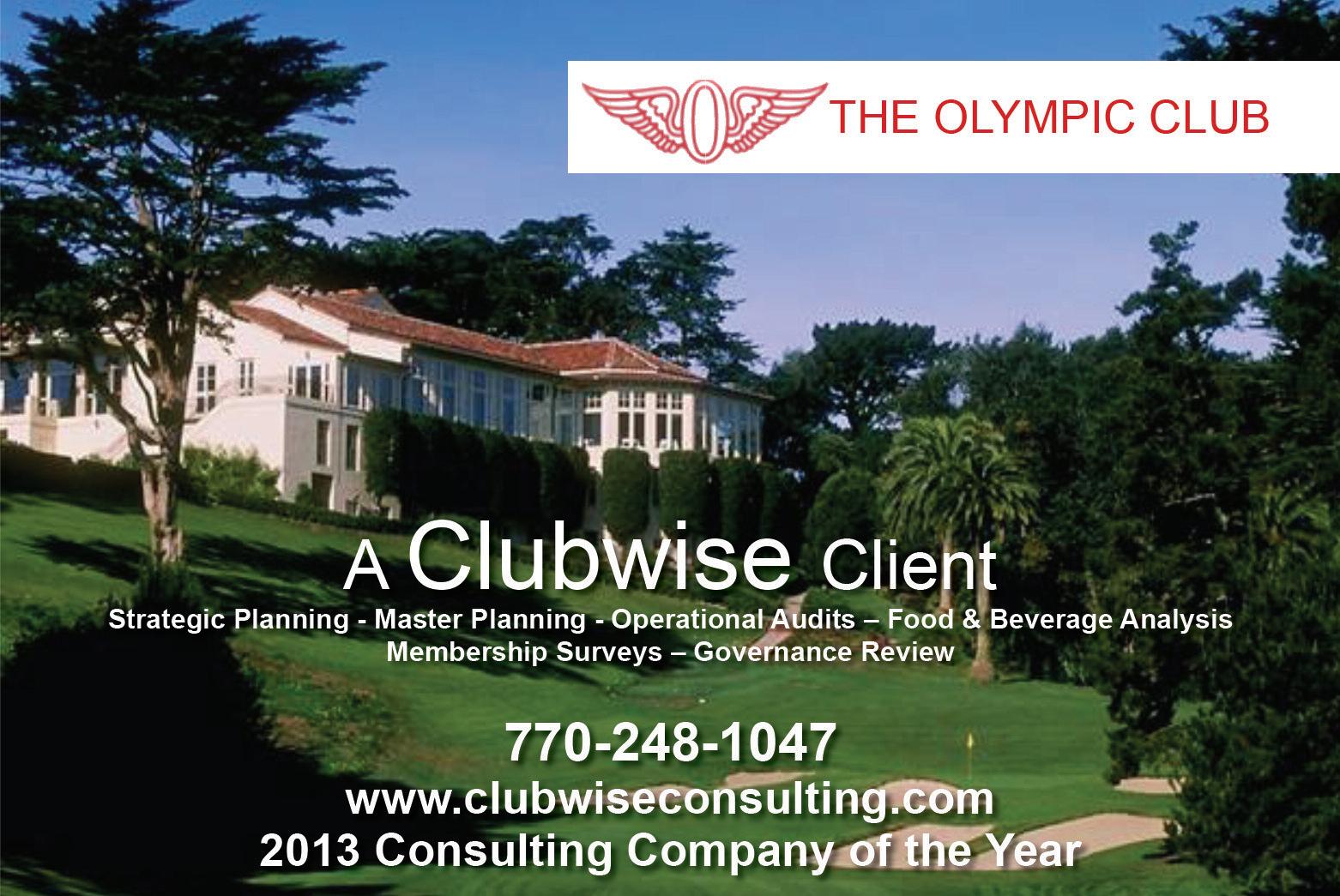

spective, and bringing that information into the boardroom or the committee room for further discussion.
Board volunteer leaders ideally emerge from successful committee involvement and leadership, an evolution that helps the volunteer transition into more responsible leadership roles. Board and committee members directly influence the success of the teams in the club.
Boards and committees focused on specific tasks or carefully defined projects know that their time is well invested. Volunteers are encouraged to draw from their expertise and to use their professional skills and knowledge to help steer the direction of their club.
Perhaps key as a board or committee member is to look at each issue through two lenses: 1) Does this help our club attract new members? 2) Does this help our club retain existing members?
Often committees are asked to hash out ideas before presenting them to the board. After discussion of ideas and issues, committees advise board members and management.
Some clubs use a board retreat as a way to bond volunteer and paid leaders on issues and direction. Participation by the board members is critical, because the retreat can serve as part of the orientation for new board members.
Retreats that examine the club’s vision, mission, and values; SMARTER (Specific, Measurable, Attainable, Reasonably High, Timebound, Evaluate, and Re-evaluate) goals, and specific operational and management tactics are productive.
Many GMs/COOs participate in the selection of board and committee members and leaders. When volunteers are selected based on how they fit or align with the club’s strategic direction, as well as on how well they relate to other owner-members, the volunteers contribute to the organization becoming more effective.
In other clubs, past presidents select board members. However, that still leaves the question of how committee members are selected. Regardless of how committee members are selected, those chosen for their business knowledge and expertise, their ability to give clear direction to management, and then their ability to get out of the way and let the paid leaders manage and operate, generally collaborate most effectively.
In general, boards that set policy and let paid leaders manage and operate the club are effective. Boards want to be informed but not burdened with too much day-to-day information. It’s the responsibility of the COO/GM to “read” the board and know what information is important to the board. The main focus of the board should be the long-term viability and relevancy of the club.
Even though the vision and mission are in place, it is a good idea to examine them each year to recommit so board members can become and practice leadership in the club. These retreats help educate volunteers regarding committee assignments and how staff works with volunteers.
In general, boards that set policy and let paid leaders manage and operate the club are effective. Boards want to be informed but not burdened with too much day-to-day information. It’s the responsibility of the COO/GM to “read” the board and know what information is important to the board.
The main focus of the board should be the long-term viability and relevancy of the club. Some COOs /GMs have expressed a keen interest in the need for the club’s volunteer treasurer understanding cash flow. When board members have retired from large organizations and were responsible for an expense-only budget, they do not necessarily understand cash flow in a private club.
Committees can serve as a support network of experts. For example, club members who are lawyers assisting with legal issues, members who are architects and construction business owners assisting with facility remodeling, club members who are in the insurance profession as reviewers of insurance policies, and club members who are bankers assisting with loan agreements and bring a valuable expertise to the club.
Support networks also promote attendance at events, the backing of decisions made by management in consultation with volunteer leaders and assistance in ongoing programs and projects. One way to engage these support networks is increasingly through the use of social media. BR
Ronald F. Cichy, O.M., professor, SeungHyun (James) Kim, associate professor, JaeMin Cha, associate professor, MiRan Kim, assistant professor are faculty members at The School of Hospitality Business at Michigan State University
This study is supported in part by a grant from The Club Foundation
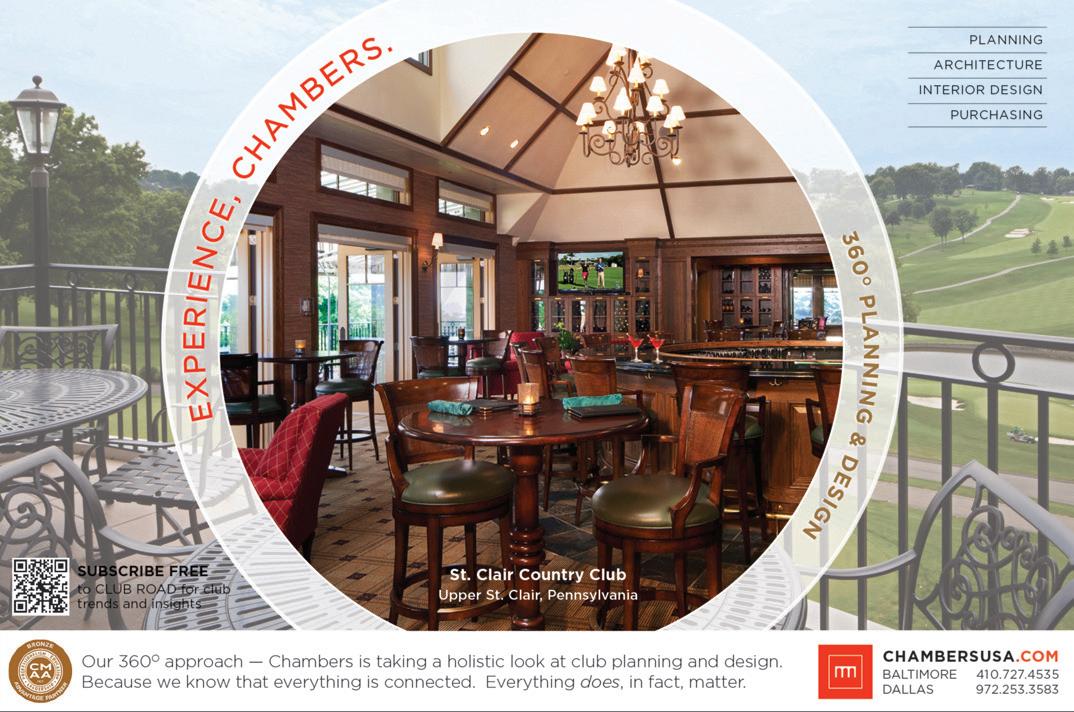
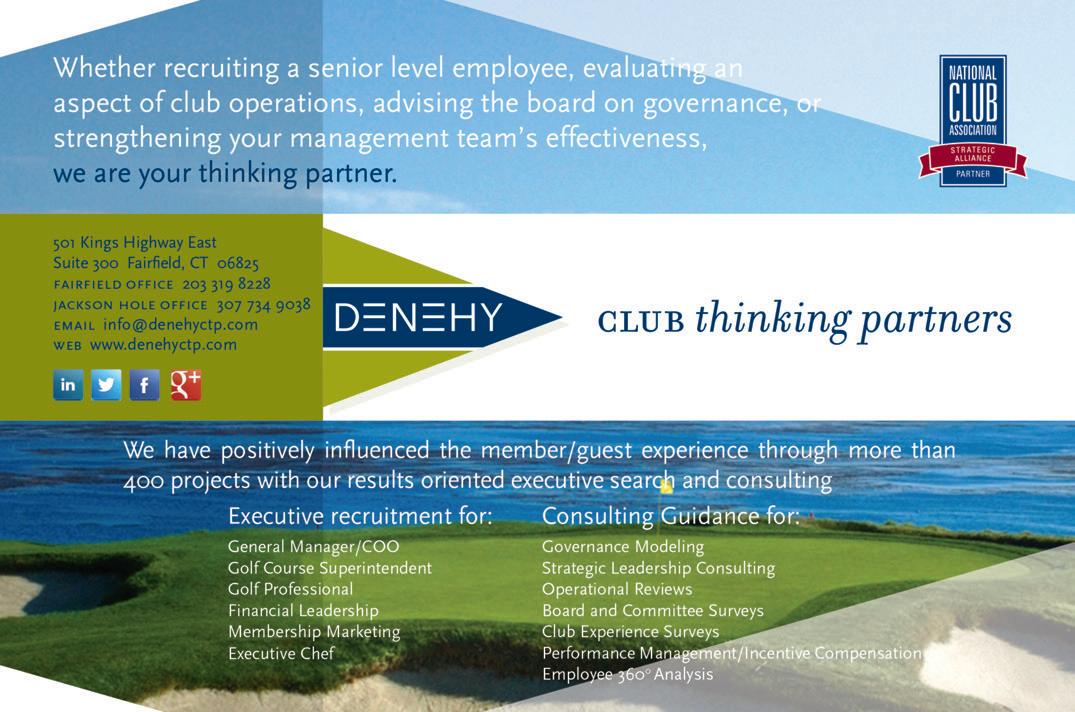
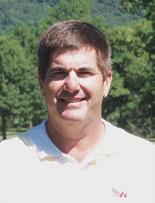
When you visit as many clubs as I do, and I’ve been consulting to them for more than 25 years, the traits of successful and struggling clubs come clearly into focus. Even a novice can notice facilities in decline, but glaring clues like these are rooted in these traits:
• Excessive cutting of expenses
• Indifference to member satisfaction
• The imposition of onerous rules
• Compromised golf course maintenance
• Decline in food and beverage quality
• Limits on club services and hours of operation
• Neglect of reinvestment in the club
• Focus on cost versus value
• Resistance to change
• The accumulation of excessive debt.
This last one is the ultimate indicator. If members aren’t willing (or able) to pay for the improvements they want (and the club likely needs), debt will result and that resulting debt load can sink a club.
Taken together, these traits add up to something else: members who act more like ‘customers’ than owners, meaning they are content to pass the costs of enhancements and revitalization on to the next generation.
During the recent recession, many clubs exercised unprecedented belt-tightening as memberships declined and boards struggled to avoid dues increases and assessments. However, these cannot be avoided forever. As the costs of club operations rise, unfortunately, so must dues. Otherwise, there is erosion of those amenities that attracted members in the first place.
Conversely, there are traits that most successful clubs exhibit:
1. They routinely maintain and upgrade their facilities
2. They boast strong, effective and unselfish leadership
3. Board leadership has invested in strong, capable management
4. There is a mutual respect between club leadership and club management, meaning the former allows the latter to do its job. The latter is also encouraged to ‘speak up’ – clubs invariably benefit from management’s candor and expertise.
5. They move forward, envision the next generation of members and aren’t afraid to change in order to improve (and meet the needs of that coming generation).
Many things enable these positive traits, but we can boil them all down to one seemingly mundane but still heroic capability: planning.
Boards determine these long-term plans, then get out of the way, so that plan can be implemented by succeeding iterations of board, management and staff. It takes a special sort of person to serve as an effective board member. Here are some traits that special person should possess.
• Experience on non-profit boards
• Legal expertise
• Financial expertise
• Hospitality expertise
• Expertise in technology or social media
• Experience as a business Leader
• Expertise in real estate and local zoning regulations
• Experience in construction and building maintenance issues
These are not prerequisites. There are lots of doctors who serve very effectively on private club boards. More important, to the club, is that prospective board members buy into the primacy of those five successful club traits, and the ability to achieve them through prudent, long-term planning.
After all, a board’s makeup can and should vary over time (three to four years is a good term target). But club goals should change very little over the long term, even as board makeup changes over.
While club goals should remain constant, the means to achieve those goals will surely change.
This sort of flexibility and perspective requires progressive leadership, even in the service of longstanding goals. The primary enemy of progressive leadership is not conservatism. It is ego.
At many clubs, long-term members can sometimes control boards to the point of resisting all change and progress, creating a stagnancy that is not only difficult to escape, but unduly expensive. If maintenance is deferred or necessary upgrades are delayed or simply not done, it always ends up costing more down the road. Always.
Many clubs balance the budget by eliminating annual contributions to capital reserve funds. This is not progressive. It’s a recipe for disaster, actually. I know of one club where in order to save money on golf course maintenance, the decision was made to relocate sand from fairway bunkers to greenside bunkers to avoid the expense of purchasing sand!
So, the two most important attributes of a board member are progressiveness and selflessness. The latter means they will place the long-term best interests of the club ahead of their own personal desires. It’s not the individual who must be served, but the entire membership.
It’s not only the current members who must be taken into account, but also future members. It is critical to ensure that club leadership is committed to stewardship of the club.
Successful clubs start with a plan for that delineates what ‘success’ means. Only then can steps be implemented to instill confidence in the membership – confidence that their investments are being protected.
Remember, members don’t join clubs for status or prestige anymore. The club is their place to relax and have fun. Members today want their fun and relaxation to be accompanied by a sense of stability. They will pay for that. Indeed, they will act upon that in another important respect: They will actively bring others into the club, to share in that value and stability.
The best clubs have identified their own individual formulas for creating value in membership. There’s no single recipe for all clubs – so long as they result in value and broad member satisfaction. BR
Larry Hirsh, CRE, MAI, SGA, FRICS is the president of Golf Property Analysts (www.golfprop.com), a leading golf and club property consulting, appraisal and brokerage firm based in Philadelphia. He has performed consulting and appraisal assignments on more than 2,500 golf & club properties in 45 US states, Canada and the Caribbean. He blogs on variety of club and appraisal issues at http://blog.golfprop.com

Club managers wanting to improve member experience can use BAi Readers and Decals to identify club members before they ever get out of their vehicle.
Additionally, BAi Readers and Decals provide valuable insight into your club usage by time-logging member's arrival even if they don't check-in or make any purchases. Take the guesswork out of knowing how frequently members are using your club.
For time-logging club usage all you need is our BAi Reader and Decals. The Reader is installed next to the entrance, and a small Decal is applied to each member's vehicle. As the vehicle passes, the Reader it will automatically read the Decal and log its unique identification number.
To acquire more data about club usage, you can install a Reader by the exit as well. This will tell you how long, and at what hours people are leaving. Cross-referencing
this new information with your existing data can help you figure out how many dollars are being spent per hour by each member.
Can I use your system to know which member just pulled in?
Yes, each BAi Barcode Decal is a unique identifier that can be associated with a member's profile in your club management software. This lets employees easily identify member's upon arrival, can be connected to digital signage for custom greetings, or to prepare equipment reservations. For integration, contact your software provider and tell them you want to be able to access data from a Barcode Automation Reader. BR
For more information about Barcode Automation, inc. call (800) 528-9167 or via email at info@barcode-automation.com | www.barcode-automation.com
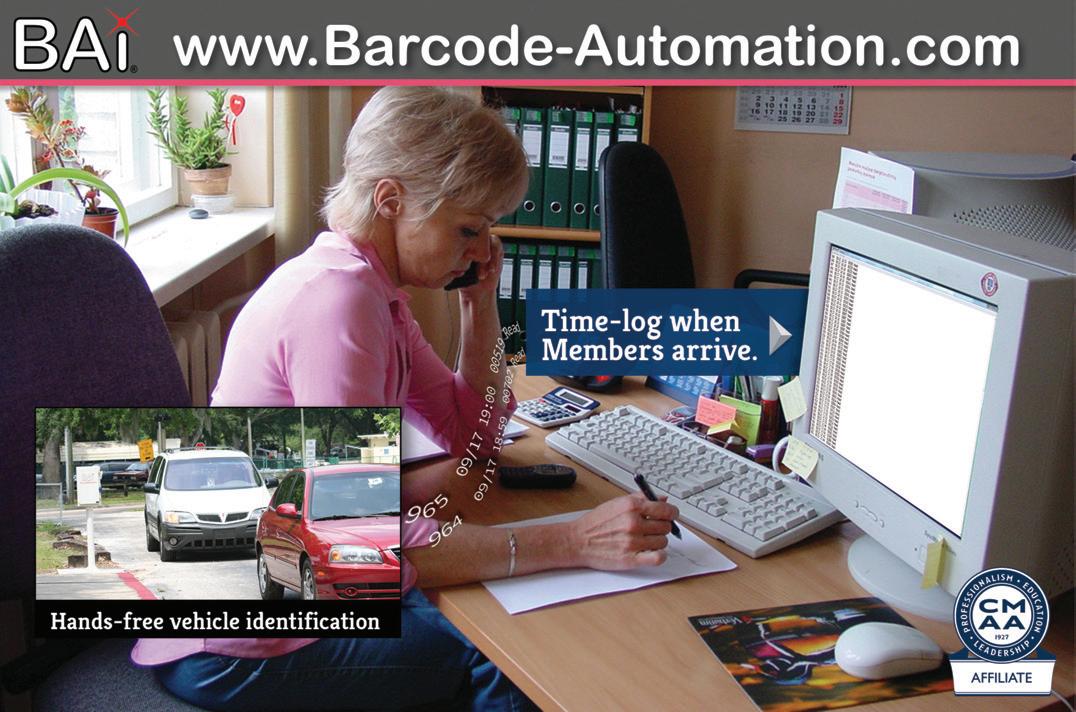
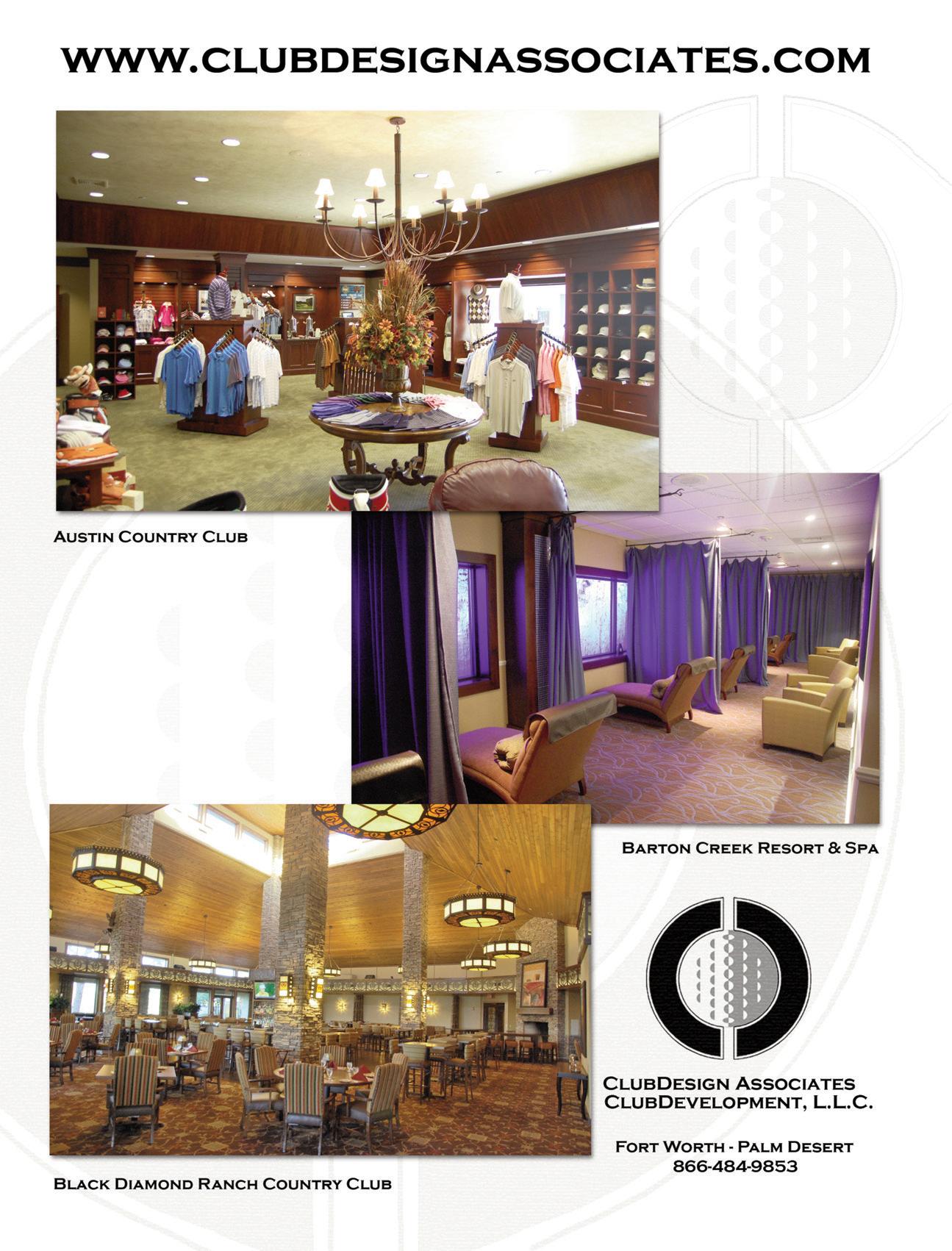

MACDONALD NIVEN
“Chris, you need to get us new tables and chairs, these ones are terrible!” This was the greeting from Mrs. Smith, a club matriarch with 56 years of membership, to the general manager, Chris.
Now in her eighties and four feet four inches in height, Mrs. Smith’s feet no longer touched the ground when she sat down, and the table was the level of her chin. “Who designed this room? I hate it and won’t eat in here ever again. You need to get some better tables and chairs.
“Oh, Mrs. Smith, let’s get you taken care of. Jan, would you please get one of those pillows from the casual furniture for Mrs. Smith, and let’s make sure we keep it handy for her.”
Jan, a wait staff person aware of Mrs. Smith’s needs, was already heading for the pillows.
“Mrs. Smith, we’ve just got to get you taller!” Chris joked, smiling warmly as Jan placed the pillow in Mrs. Smith’s chair.
The other members at the table smiled at Chris, knowing that Barbara’s complaints were a daily ritual and that she would be back to harangue Chris again the very next day.
Chris’s attitude towards Mrs. Smith is one of empathy, warmth and understanding, all of which came across as very authentic to the other club members. We have no idea what was on Chris’s mind when the diminutive bulldog named Barbara Smith blustered into the dining room for lunch.
It could very well have been something like, “Oh man, not again. Lady, you’re four feet four and shrinking, it’s natural. Sure, I’ll get that pillow…” What goes on inside a person’s mind is, well, personal.
Changing your own thoughts is virtually impossible. Changing your delivery, on the other hand, is a necessary skill. A great leader can keep their thoughts to themselves, choosing which sentiments they wish to express publicly and sending out signals of authenticity to their listeners.
In terms of how we govern and express our own thoughts and emotions, psychologist Mark Snyder refers to two fundamental profiles: trueto-selfers and high self-monitors. If you watch the movie The Imitation Game about the mathematician Alan Turing, you’ll see a good example of a true-to-selfer.
In the film, Turing expresses his true thoughts clearly and mercilessly; as a result, his work team hates him.
Jane, his closest and most honest workmate, tells him that his team needs to like him in order to work with him.
Taking her advice, Turing brings each of his team members an apple, a gesture so uncharacteristic and blatantly inauthentic that his team members are amused.
As Herminia Ibarra relates in her Harvard Business Review article The Authenticity Paradox, the danger to true-to-selfers is that they may stick too long with comfortable behavior that prevents them from meeting new requirements, instead of adjusting their style as they gain insight and experience.
Their reluctance to censor their own opinions to spare others’ feelings may also make it difficult for them to work productively with others or navigate delicate social situations
Chris, by contrast, behaves in the opening scenario as a high self-monitor. High self-monitors are able to adapt to different situations without feeling fake, and are consequently better at projecting authenticity.
One downside to this adaptability is that, as a person constantly modulates their behavior to suit the situation at hand, a person may sometimes appear to be disingenuous and lacking in character. Bill George, former Medtronic CEO and current Harvard Business School professor, suggests in his book True North that cultivating your authenticity takes time and practice. This process of development centers on five areas: selfawareness, values, motivations, support team and integrated life.
Self-awareness is at the heart of true authenticity and feedback is at the center of self-awareness. As Stanford’s Joel Peterson relates, feedback is “the breakfast of champions.”
A manager must be on the constant lookout for feedback and must learn which people to trust as valuable peers: self-awareness requires a person to consider a variety of different perspectives. Acceptance of feedback about your own behavior is challenging, but necessary.
In crafting your authentic persona, however, it is essential not to compromise on your values. Values are the deeply-held principles that dictate your most important decisions. Your values are learned through self-reflection and experience and are exposed during high-stress periods, so it’s good to know them in advance!
Understanding your motivations is important when integrating an authentic persona. It’s essential to identify your true motivators, whether intrinsic or extrinsic. Your job performance will be far more productive and authentic when you have aligned your true motivation with your professional role.
Knowing whom to trust is also very important to growth and sustainability for integrating your life and work. Virtually all great leaders have a support team on whom they can rely for real conversations and true feedback. While we may have to take the feedback of a character like Mrs. Smith with a grain of salt, the feedback of our closest and most trusted friends can provide real insight into our strengths and challenges.
Learning to be authentic in the varied situations that managers and directors find themselves in is critical to our success as leaders, and even as human beings.
We all have Barbara Smiths in our lives, and we must learn how to interact with them genuinely and positively. BR
MacDonald Niven, CCM, CCE is the general manager at La Rinconada Country Club in California and can be reached at (510) 439-8522 or via email: macniven09@gmail.com

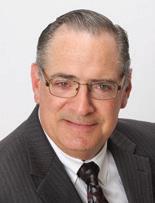
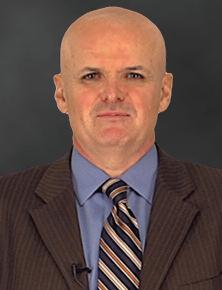
PHILIP NEWMAN
“If a business were a car then the business owner would be the driver ... and as the car travels down the highway at 60 mph, the controller function is like the rear view mirror showing the driver where he has been.
“The CFO function is like the windshield and headlights, showing the driver where he is going and helping him to prepare to turn, slow down, speed up, etc. The purpose of the controller is to produce timely and accurate monthly financial statements. The purpose of the CFO is to help prepare and execute the strategic financial plan.”
– Duane Tolan, TolanCFO
One of the most consistent trends in club operations since the great recession has been the clamor for greater firepower from the club’s accounting office.
Boards, finance committees and chief operating officers all have much greater expectations today regarding the quality and timeliness of the financial information they are being given to lead and manage the club. It follows therefore that the demands placed on the accounting personnel, most notably the controller, have also increased.
Just as the general manager position has evolved into that of chief operating officer (COO), club controllers, in many cases, are being tasked with chief financial officer (CFO) duties and expectations. So just what should a club COO expect from a CFO? What follows is our top 10 observations from some of the highest performing club CFOs around the country.
1. They attend board meetings – the whole meeting: Some CFOs are only invited to attend a portion of the board meetings, in order to present the financial results for the month. But what about the financial impact of the decisions made during the rest of the meeting?
For instance, new membership programs – if a CFO is notified of the program after the fact, they may not have the opportunity to let the
board know that when dollar credits or incentives are involved, the club may have to issue members 1099s for incentives of a certain magnitude.
This knowledge may impact the number of incentives the club may want to give or how it should be timed. If you don’t believe your CFO should be attending club board meetings, its time you asked yourself why. No COO in corporate America would think of attending a board meeting without their chief financial person at their side – why would a club COO not follow suit?
2. They participate in policy setting discussions to improve the management of financial information and performance of the club: Successful CFOs are looking for opportunities to improve the policies of the club, not just waiting for the general manager or the board to tell them what policy needs to be in place or changed.
For example, it’s surprising to see how many clubs do not have a formal written capitalization policy or a purchase order policy. These policies not only help streamline the reporting process, but also prevent unwritten, informal policies from getting changed every time the club has a new board. Consistency in practice is a very important part of financial record keeping.
3. They analyze instead of just reporting: What do you receive in your internal financial package? Does accounting provide the department heads with weekly/daily flash reports? A departmental income statement and the balance sheet received on a monthly basis does not provide enough meaningful information to make good decisions. The top CFOs in the industry are providing management with daily flash reports so that operations managers can react quickly to any deviations from their forecast.


4. They tailor their message to their audience: While analyzing and reporting key performance indicators (KPIs) and ratios are important, it’s also important to know what information to provide to whom. Department heads and the COO need more detailed information on a timely basis, while we probably do not want to inundate the board with the same level of detail. The COO, as in any business, should see the information to be provided to the board well before a board meeting so that they can be prepared to answer any questions. Similarly, the best CFOs are providing the answers to the questions before the COO even asks.
5. They commit to lifelong learning: Whether they are a CPA, CA or CHAE, staying current on accounting issues and knowing how to research is important.
For instance, have they evaluated how the new revenue recognition standard will impact your club’s reporting of initiation fees? What will your financials look like when all leases eventually became capital? How might that affect debt covenants your club currently is subject to?
While your auditors will tell you the correct recording during the audit, the top CFOs are thinking about these things as they come up and even if they don’t have the answers themselves, they will contact their auditors in advance so that they can record the transactions correctly upfront, rather than having an audit adjustment.
Whether it is as simple as committing to attending local, regional and national educational events or studying for another designation they can bring even greater value to their position at your club. Club controllers should understand that being satisfied with the status quo is arguably a career risk that is not worth taking in today’s financial climate.
6. They lean on their auditors: If club controllers only see/talk to the auditors once or twice a year, then they are buying a commodity.
If they talk to them regularly then they are buying a business advisor. This can only help with our previous point on lifelong learning.
Hopefully your audit firm has significant expertise and experience in your industry and can help your CFO understand developments in the finance field as well as in the club industry generally. Your CFO should be asking your auditors for their guidance on how to deal with treasurers or finance committees, or even COOs! Your auditors should be able to tell the CFO what each of those individuals or bodies is typically looking for in a club CFO, and how they can work on delivering that.
7. They are transaction advisory specialists: High performing club CFOs embed themselves into discussions concerning new debt, leases or membership initiatives so they can provide informed guidance on how entering into these various transactions can impact the club financials. They don’t wait until a document is handed to them after transaction is consummated – they are proactive in their advice on the issue. Deferred compensation agreements and derivative agreements embedded in loan documents are two of the best examples of arrangements a club CFO should be proactively monitoring at their property.
8. They learn the soft skills: Quite frequently we hear frustrations from club CFOs of how they struggle to connect with others at their club – be it department heads, the COO or perhaps committee members and board members. The best CFOs understand how to connect with each of these stakeholders.
Since board and committee members can often change frequently, is your CFO equipped to handle the different personality traits? This skill deals more with how your CFO shares information with different parties, not necessarily what information they share. Some COOs or treasurers are detail oriented and want the whole back story to the financial message; others just want the punch line.
Think back on our lifelong learning point – have you ever had your CFO attend a session on how to deal with different personalities?
9. They embrace the club’s strategic plan and play a part in its formulation: We will keep this point brief. As professionals who often become involved in the process at many clubs, it is still frightening to us how many clubs go deep into the strategic planning process without involving the finance professionals at their club.
If your club is going through the process, or is thinking about it, your CFO should want to be involved. If your CFO can take an ownership stake in the future of your club and seek to play an active role in strategy development, they will only increase their value to you and your board.
10. They think beyond their department and the club: What does your CFO really know about what’s involved in managing the various facets of your club? Have they visited the department heads in their departments? Do they understand what’s really behind the numbers in each department?
Do they stay on top of related industry thinking…restaurant…golf…hotels…? What business books or periodicals do they read to stay current on best practices? Again, CFOs in corporate America would be expected to answer each of these questions positively.
11. They train their team so they can trust them: Yes, we know we said ‘10 points’ to share, but we understand the reality is that your controller can’t accomplish all of them if they can’t rise above the trench of the daily processing. The best CFOs train and empower their team so they can delegate more duties.
If accounting staff can’t be trained then the CFO needs to do what the CFO in any corporation should do – make the business case for upgrading the talent so they can be the CFO the club needs. BR
Philip Newman, partner, and Bob Salmore, senior director, are members of McGladrey, LLP, a national professional services firm with a focused industry practice that provides accounting, tax and consulting services to hundreds of private clubs throughout the country. They can be reached at (800) 966.0428 or philip.newman@mcgladrey.com and bob.salmore@mcgladrey.com .

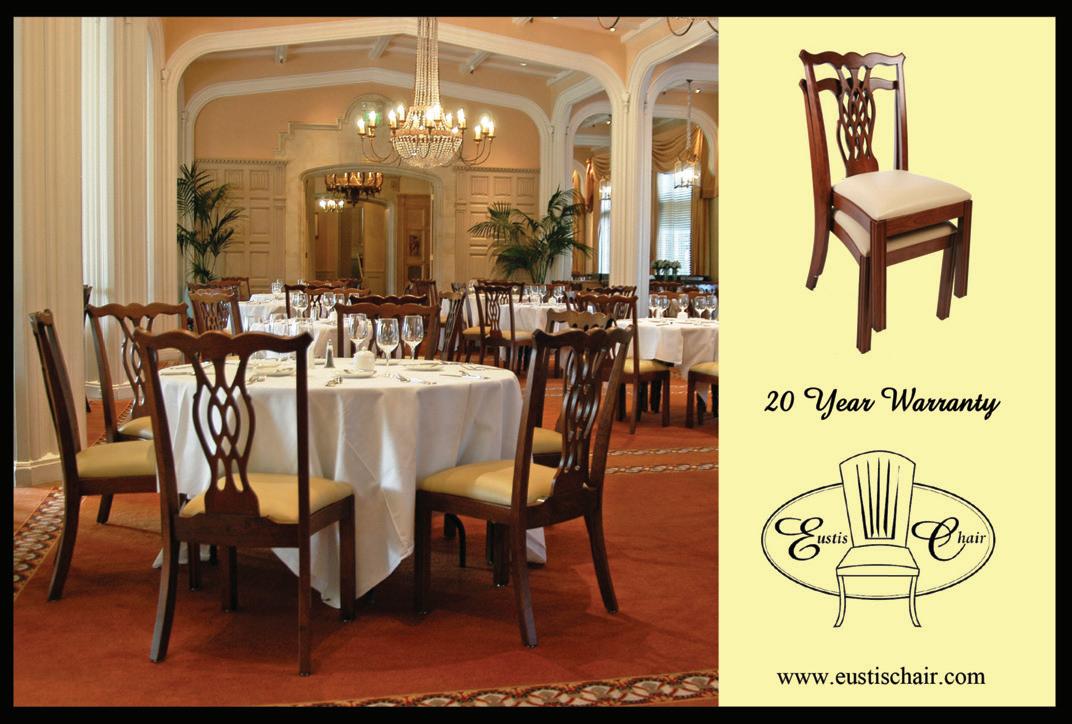
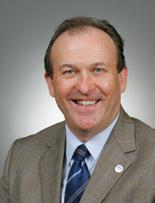
JERRY KILBY
Much has been written in the columns of BoardRoom magazine and elsewhere concerning the problems that many of us are experiencing in the global golf industry.
And many here also provide solutions to those in decision-making roles at clubs, but I fear that many people in the global golf industry are in danger of thinking that “this is beyond my control” , or “I can’t solve all golf’s problems on my own.”
So, I outline for you, dear reader, my thoughts and offer six different actions that each of us can take, that will not only make a difference at your golf club, but if we all adopted these, well, I think many of golf’s problems will be a long way towards being solved.
Knowledge and networking are so important today. Keep abreast of current legislation, trends in the industry, and most importantly, find out what other clubs are doing to solve their problems. Seek out ‘best practice’ wherever it may be.
THREE ‘DOS’
1) Commit yourself to continuous change: We can all make changes to the way that our golf facility is managed, how golfers and non-golfers in your local community perceive it, and how access to your facility is provided to members and non-members.
I ask everyone involved in golf management to take a moment to think a bit more about each decision you take and try and find an option that would tackle one of the core problems affecting the game.
This could be not enough access to golf courses for females or juniors; or out-of-date dress codes; or more encouragement of social and match-play golf, rather than endless repetition of stroke-play competitions in your golfing calendar.
Even if you are planning to organize a repeat of a successful golfing event held last year, try to introduce something new to improve the event this year. Continuous improvement must be your watchword in all things you do.
2) Communicate your changes: After doing the right thing, the next most important thing to do is to tell people that you are doing the right thing. Most of us meet our colleagues regularly to discuss the various challenges at our clubs, which could be in management meetings, or board/committee meetings perhaps, so I suggest you agree with your colleagues to not only make changes, but to also tell your colleagues of the changes you are making.
Ask them about the decisions that they are going to make, and agree to remind each other if anyone sees any sign of the six most dangerous words in management: “…we’ve always done it this way.”
3) Commit yourself to your own professional development: If you are a board/committee member at your club, make sure your superintendent, golf professional and club manager are all active members of their professional associations, and are attending as many of their associations’ educational seminars, workshops and conferences as they can.
Knowledge and networking are so important today. Keep abreast of current legislation, trends in the industry, and most importantly, find out what other clubs are doing to solve their problems. Seek out ‘best practice’ wherever it may be. Make sure these industry professionals provide their boards with short written summaries of what they have learned, what they will do differ-


ently and whom they met after each of these professional development events. If you are the club’s general manager, make sure your colleagues submit these to you after each of the educational and networking events they attend.
THREE DON’TS:
Don’t mourn the closure of a golf course: We hear and read about golf courses closing their doors regularly now – this is not a bad thing for the long-term health of the golf industry.
We all know that we built far too many golf courses in the 1990s and 2000s – our belief that thinking that ‘if we built it, they would come’ was misjudged and misguided and we are now paying the price for over-supply in the market.
In all other industries, over-supply is corrected by closures and consolidation and golf is no different. Of course we feel sorry for those that may lose their jobs, but good people will be snapped up by other golf clubs very quickly in many cases.
The good news is that many golf clubs, country clubs, resorts, driving ranges, daily-fee golf courses...are changing; they are attracting more adults and children into the game and are making a difference in their communities. Let’s all try and learn from these visionary golf leaders –share best practice and look forward to a bright future for the global golf industry.
In all closures, the public has voted with their credit cards and decided that for whatever reason, they will not spend their hard-earned cash there. Do not get emotional about golf course closures, perhaps because of who designed it, or how challenging or easy the golf course may be to play.
This is a straight forward business decision, and those golf courses that are left behind will be quick to encourage golfers to come and play their golf at their club, if their regular club has closed for good.
Don’t wait for the ‘Big Idea’ to come along: I continually read that golf is looking for a shorter, quicker version of the game to tackle the time-poor customer. Four
or five hours (or more) is too long to play the game, and that is true, but we already have the solutions to speed up play and allow our customers to enjoy the sport in a shorter time frame.
They are: match play, not stroke play; five, six or nine holes instead of 18 holes; concede putts within the length of a putter; two and three-balls play rather than 4-ball play; foursome (alternate shot) play and four-ball (better ball) play.
The list is endless, we all know these, we just have to use them and promote them to our members and guests. There is no need to build six-hole golf courses, every 18 hole golf course will have a ‘loop’ of four, five or six holes that a golfer could play, that brings them back near to the clubhouse in an hour or so.
The challenge for golf directors and golf managers is to make the playing of such short ‘loops’ of holes possible by those who are pressed for time – and the good golf managers will find a way.
Don’t think that golf governing bodies will solve the problems for us: Waiting for the USGA, R & A, PGA or any of the other governing bodies to solve golf problems is a waste of time – not because I don’t think that they are trying hard to solve many of golf’s problems (which I believe they all are), but because they don’t manage golf courses –you, dear reader, do.
They cannot force us all to play quicker; introduce legislation to prevent us from playing golf in any format we like; they can only persuade us all to change and some will, many won’t.
Changes can only be made at club level by club managers, boards and committees. Indeed there are many examples in history of changes being much more effective when they are bottom-up rather than enforced from on high (top-down), so let’s make the changes at our clubs, and let the governing bodies catch up when they are ready!
The good news is that many golf clubs, country clubs, resorts, driving ranges, daily-fee golf courses and other facilities are changing; they are attracting more adults and children into the game and are making a difference in their communities.
Let’s all try and learn from these visionary golf leaders –share best practice and look forward to a bright future for the global golf industry. BR
Jerry Kilby CCM, independent golf marketing consultant, Kanda Golf Marketing Services. He can be reached via email: jerry@kandagolf.com or at +44 (0) 1428 606466
Mob: +44 (0) 7821 908597
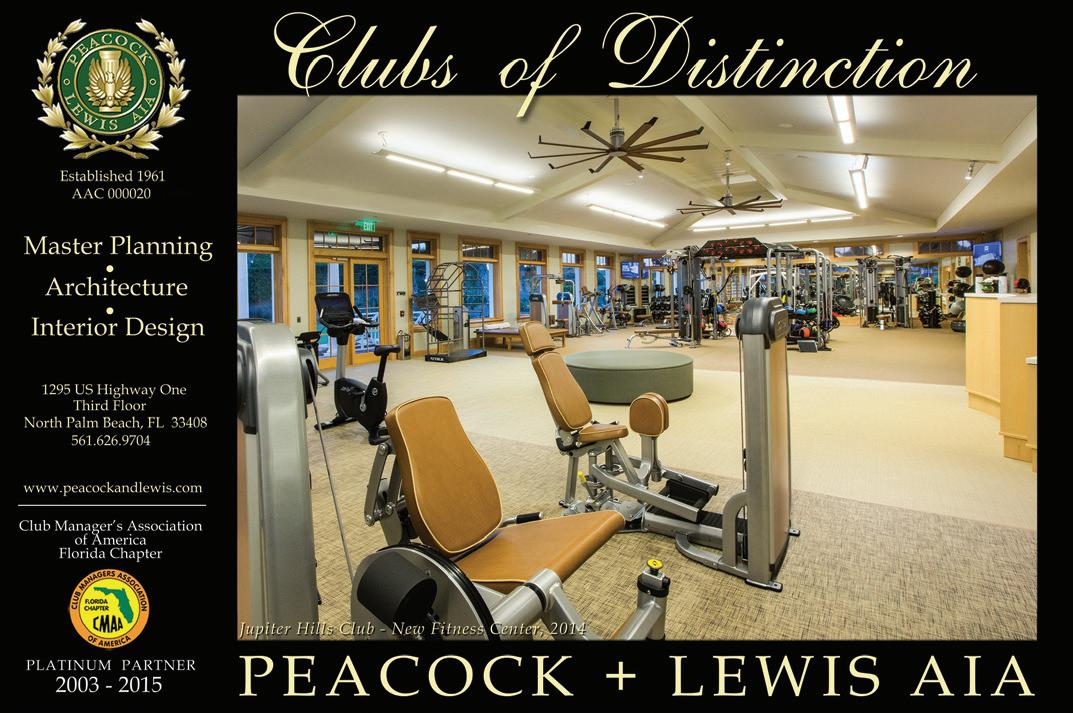
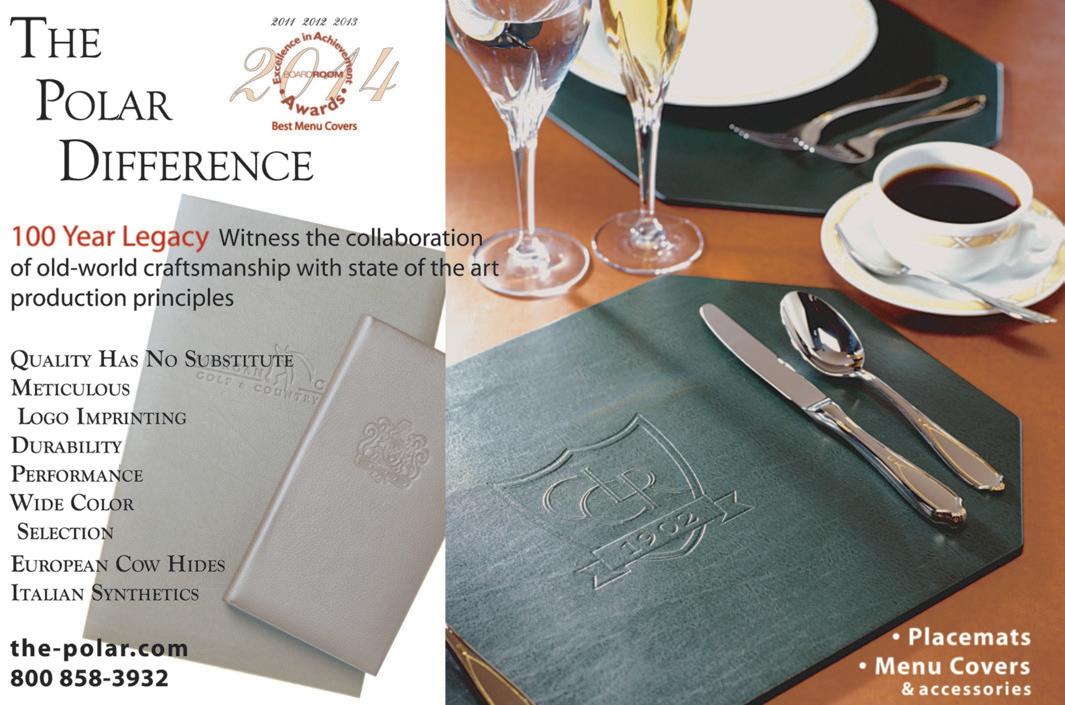
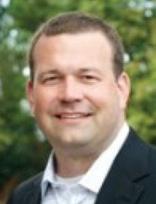
Marketing technology, including websites, email marketing, SEO and social media are among the most effective marketing for private clubs.
Conversely, traditional tactics such as direct mail, magazine placements, and press releases were all deemed least effective by our survey respondents.
That’s the result of an informal pulse survey of nearly 250 private clubs and 400 general managers, COOs, board members, marketing and sales professionals, and other industry stakeholders. We wanted to learn two things – what membership marketing tactics had worked best for clubs last year, and what marketing initiatives private clubs were focused on in 2015.
The three most important marketing priorities for private clubs in 2015 are:
1. Expanding overall awareness (74 percent of respondents): Clubs may be realizing that while exclusivity is an important aspect of a private club’s overall value proposition, it may not serve them as well from a marketing perspective. More and more clubs seem to be adopting a marketing position of ‘inclusive exclusivity’ that highlights the benefits of an exclusive lifestyle to generate awareness and create demand.
2. Lead Generation (73 percent of respondents): Generating leads that fit within the defined criteria for an ideal prospective audience can be one of the most difficult challenges for any business. For private clubs it can be even more difficult because of the constraints on advertising and the complexity of effectively communicating the value proposition associated with an exclusive, lifestyle-oriented brand.
3. Understanding Demographics (69 percent of respondents): Taking the time to learn about the audience can not only help to shape products, positioning and price, but is also a critical element to determining campaign messaging and audience targeting. Lifestyle marketing relies on much more than age, income and location though – understanding people’s
behaviors (where they shop, how they spend free time, etc.) as well as general interests, attitudes, and professional information are just as important.
Of course every club is unique when it comes to marketing strategy design and implementation, but how does a club that shares these types of marketing objectives move forward in 2015?
For the past several years digital marketing campaigns using search engines and social marketing platforms have evolved to a point where the awareness and targeted lead generation capabilities have totally eclipsed the results typically generated by more traditional forms of marketing.
Why? Well, primarily because these digital marketing outlets (Google, Facebook, LinkedIn, etc.) have done a really great job of understanding their users – tracking every search, click, visit, connection, profile, etc.
That data is made available to marketers to develop specialized campaigns designed to take advantage of very specific micro-targeting of these various user audiences based on not only demographic information (age, income, location), but also based on behaviors and interests such as: activities people are interested in, websites people visit, places people dine and shop, what people are searching for online, and so on.
The result is a marketing audience built with very granular criteria that is more likely to produce meaningful and actionable interest, which in turn supports higher matriculation rates and improved retention of those members. The same approach can easily be applied to events as well.
But can this approach really work for a private club? A high-end private club in the Los Angeles area is one of the most recent, best client examples. The club is an exclusive, member-owned 501(c) that sold over 60 memberships at initiation fees of $90,000-plus in 2014 as a direct result of inbound, targeted leads generated by a digital marketing campaign focused on the top
tier of affluent families, young professionals and high net worth individuals within the area around the club.
We worked with the club to define their ideal audiences and developed a number of personas (for example, young families with an interest in golf and an overall active lifestyle who had visited a golf-related website or search within the past 90 days). A separate campaign was then launched to appeal to each different persona leveraging Google, Facebook, LinkedIn, and several other online platforms and partner websites.
Each click on the campaign messaging directed the lead to a dedicated landing page website where contact info was captured and sent directly to the CRM software platform. A lead was created, and automatic email response was sent, and the club’s membership representative notified to follow-up and begin nurturing the lead and executing the sales touch points.
It seems that the enthusiasm for private clubs to leverage... micro-targeted lead generation is growing, and for good reason. Yes, it is an incredibly effective form of lead generation... but it’s also incredibly efficient as well.
Given some of the marketing trends we have seen recently, it seems that the enthusiasm for private clubs to leverage this type of micro-targeted lead generation is growing, and for good reason. Yes, it is an incredibly effective form of lead generation that addresses all three of the marketing priorities our survey respondents identified for 2015, but it’s also incredibly efficient as well.
Awareness is free. Clients only pay when people act, meaning when they click on the campaign messages to learn more. Further, critical marketing metrics are collected in real time as campaigns are running, so we learn fast and we know immediately what’s
working and what isn’t, giving the ability to adjust on the fly.
Finally, this form of lead generation produces a warm lead, meaning that interested prospects are actually expecting a club representative to follow-up with them. This makes sales time a lot more productive and increases the chances of closing the sale! BR
Michael Phelps is principal and co-owner of Pipeline Marketing, a firm specializing in sales and marketing solutions for lifestylerelated industries. Michael also leads the marketing and technology areas of Pipeline and has been in the private club industry for the past 20 years. More about their firm, including complete survey results can be found at pipeline-inc.com.


BY KYLE JENNINGS
Back in 1961 a membership topping 2,000 members signified a landmark for the Club Managers Association of America (CMAA).
While the country was debating civil rights and counterculture, the club management profession was also experiencing a dramatic shift…one that would ultimately benefit more than 1,500 club managers and the greater club industry.
At the 1961 CMAA convention in Denver, more than 1,000 managers were in attendance. After a strong call by then-CMAA President Kenneth Meisnest to develop a certification program for club managers, the membership was ringing with talk.
“Someday you could have CCM for Certified Club Manager after your name. This will be done by a committee which will determine experience and training requirements and, after examination a method would evolve to ensure continued competence in our field.”
CMAA’s
For years, the club management profession did not require an educational background or prerequisite, and consequently many managers moved into positions and advanced their careers without formal training or even college degrees. The prospect of implementing a certification program made many of these managers question their continuing place in this evolving field.
To honor the many members who shared these concerns while at the same time encouraging academic preparation and continued educational growth, CMAA developed a point system, taking into account current managers ‘work experience.
“They were attempting to create a balance in the areas of experience, education and CMAA involvement in order to give recognition where recognition was due and to measure competence,” explained former CMAA president Horace G. Duncan, CCM. “We were pioneers in certification. Only a few organizations really had a certification program at that time.”
These changes, however, weren’t without opposition. Duncan explained that many members were wary and skeptical about going through a program where they would have to become certified.
certification program is the most respected in the hospitality industry and the CCM designation is considered the hallmark of professionalism in club management. It’s a valuable and widely respected mark of a manager’s commitment to professional development and the club industry. In the 50 years since, CMAA has bestowed the CCM designation on more than 1,500 managers Certified Club Managers.
Meisnest’s vision included the development of trainingeducation programs that would also benefit subordinate club staff and employees - making the entire club operation, and indeed the industry as a whole, the beneficiary of the certification program.
In 1962, steps were taken to develop the CMAA certification program, but the development was slow and deliberate to ensure the approach was equitable.
“Eventually, they saw the light and accepted [certification]. It turned out to be a great thing! Many other organizations copied what we were doing. It was one of our greatest moves.”
That great move came to fruition in 1965, when the first certification requirements were officially implemented. In 1966, at the 39th CMAA Conference the first class of 150 Certified Club Managers were formally recognized with many more in the process of completing the basic requirements. The next year, the number of CCMs jumped to 241, with another 61 managers in the process of attaining their designation.
More than 50 years later, Mesinest’s vision shines as a reality. CMAA’s certification program is the most respected in the hospitality industry and the CCM designation is considered the hallmark of professionalism in club management. It’s a valuable and widely respected mark of a manager’s commitment to professional development and the club industry. In the 50 years since, CMAA has
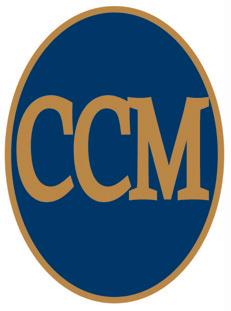
bestowed the CCM designation on more than 1,500 managers Certified Club Managers.
The certification process has been influential in the lives of CMAA members and a benefit to the greater club industry at large.
“The CCM is the hallmark of achievement in the club industry. Boards look more favorably on CCMs – the designation connotes to boards that a manager is committed to their professional education and their career,” says Dick Kopplin of Kopplin & Kuebler.
“The CCM is critical to managers who want to be successful in their profession,” Kopplin added. “It’s a calling card to boards and a tribute to a manager’s dedication to his or her professionalism.”
The development of the CCM and the certification process marked the beginning of a long tradition of stellar professional development opportunities. Over the past 50 years, the certification process has evolved and been refined to ensure that CMAA’s managers benefit from an authentic academic experience and are provided with many opportunities to learn and grow in their careers.
The next 50 years promise to continue to build upon that tradition and provide CMAA’s managers with the best ongoing education in the industry. BR
Kyle Jennings is
CMAA’s associate editor and communications manager
To learn more about CMAA’s current Certification program, please visit www.cmaa.org or contact the CMAA National Headquarters at (703) 739-9500.



SPECIAL TO BOARDROOM MAGAZINE
The Sarasota Yacht Club is thriving on a unique approach to make the club ‘youth friendly.’
That’s the club’s Ensign or junior board’s mission. The board is comprised of a group of middle and high school students whose families belong to the club…young people who have shown interest in developing youth-oriented programming at the Sarasota Yacht Club.
“It functions similarly to the SYC’s board of directors. We have officers who lead the meeting, take the minutes and who meet to discuss upcoming meeting
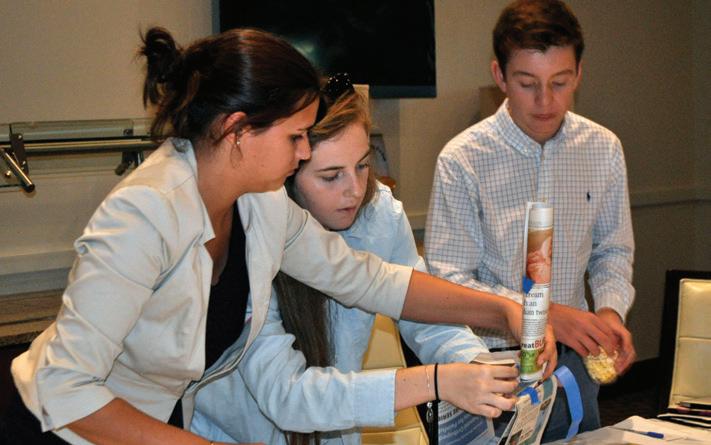
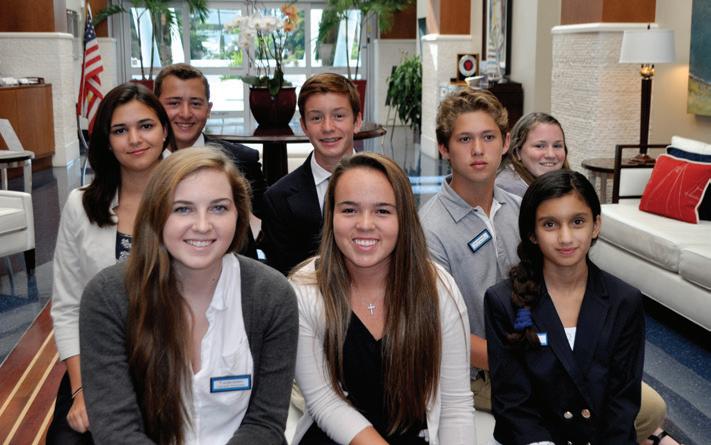
agendas,” explained Stephania Feltz, the club’s member relations director.
“The board’s Commodore leads the meetings and Robert’s Rules are followed for each meeting, and we brought in an outside agency to conduct training with the youth on developing their vision, both personally and for the group.”
The Sarasota Yacht Club’s board invited the Ensign Board members to introduce themselves at one of the club’s board meetings. This has allowed the youth to introduce their ideas, and the club’s board provides feedback to the Ensign Board’s about ideas and suggestions aimed at creating a “youth friendly” Sarasota Yacht Club.
As well, the SYC’s board officers are paired with their counterparts from the Ensign Board for mentorship and guidance.
“The Ensign Board was started to engage the middle and high school children of our members in their club. We had developed strong programming for our elementary-age children, but needed to find ways to involve the older children as well,” Feltz added. This club also gives these young adults a place that welcomes them and listens to their ideas and suggestions.
“We want to foster Legacy memberships and this is a great way for our youngest members to establish the Sarasota Yacht Club as a home away from home and a place that they will want to come back to and join in their adult lives,” Feltz said. BR
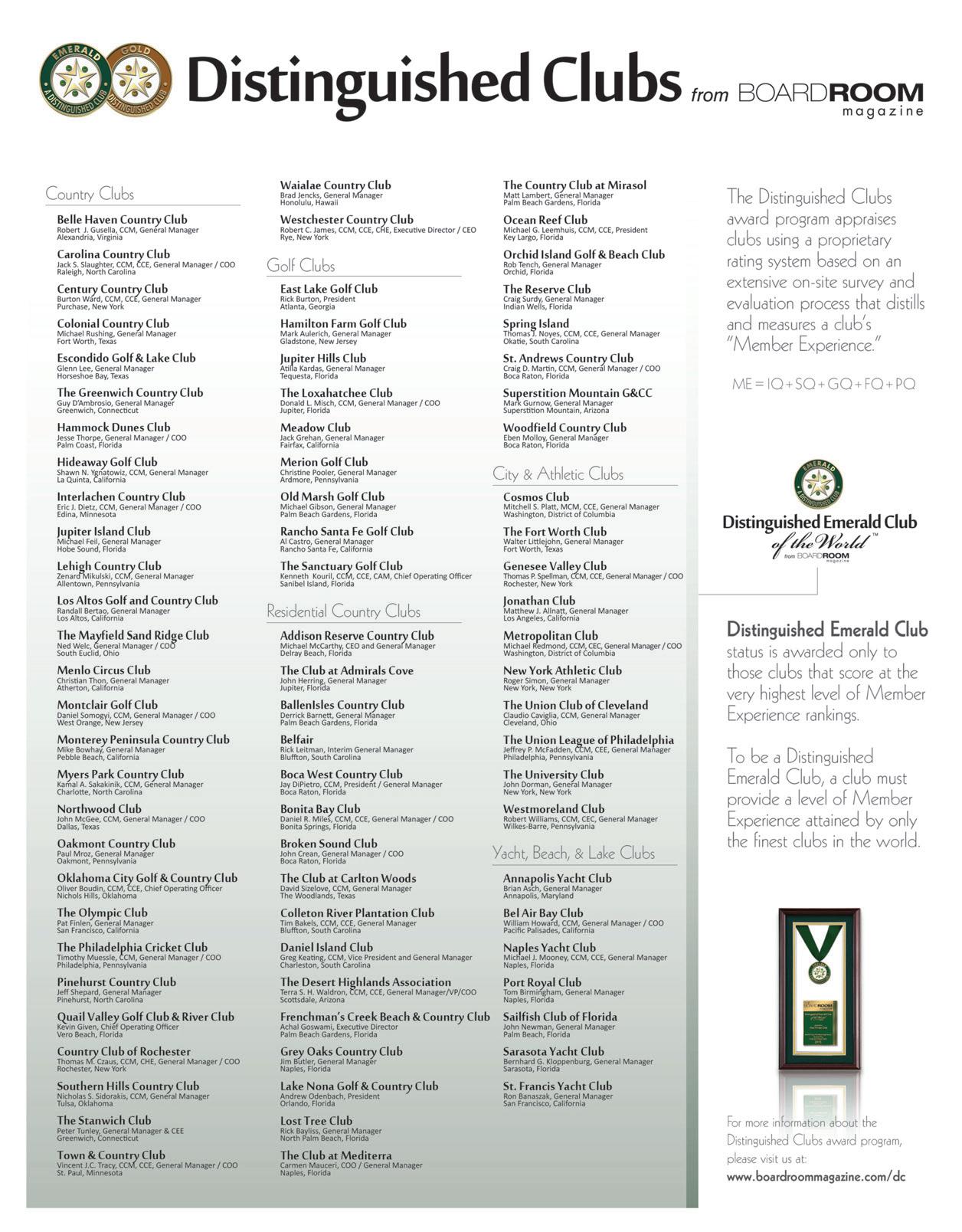

So just how do private clubs grow the game of golf and secure the game’s future?
Well, Nashawtuc Country Club of Concord, MA has come up with an approach that’s going to help.
Nashawtuc, through the club’s director of golf Chris Carpenter, has embarked on a junior select program, involving the area’s best young golfers that are second to none.
“Research shows that if a young player is passionate about the game that by age 13 they should make golf one of their top sports,” explained Carpenter. “They then need to align themselves with competent coaches, develop peer relationships with other golfers, play and compete in the same fashion as high level athletes in other sports, and set down plans for their future.”
Armed with this information, Carpenter developed the Nashawtuc Country Club Junior Select Membership, which allows the area’s top junior golfers to play, practice and train at the club. This stimulates interest, has already increased the number of ranked junior golfers in Massachusetts, and further established Nashawtuc as leader in the state’s junior golf revival.
The program fees cover all instruction, fitness training and mental performance coaching. The program is structured like a collegiate team and juniors must meet competitive scoring requirements to be eligible. There is no limit to the number of club juniors who can participate, but Carpenter is limited to 16 junior select members whose families are not NCC members.
The junior select program runs at the club from May-October, and a 25,000 square foot golf dome is available for winter training. “The winter program has been a great way to identify potential junior select members as we have the ability to market winter programs to families throughout Greater Boston.”
The kids practice, play and train together weekly. “The instruction is mostly group based, but when they are struggling with a particular shot or have ques-



tions, we spend as much time as needed to help them find the answers,” Carpenter related.
“Most importantly, we do not have to push them. But because they all love playing and practicing golf, they can’t wait to go out and compete with one another each day,” Carpenter added.
The Nashawtuc pro sees this junior venture as another opportunity to grow the game.
“I’ve always believed the easiest way to grow the game is through juniors. Our objective is to make sure golf is on the family schedule at an early age. Mom and dad are dropping the kids off for after-school or summer activities. We need to convince them to give us a set day and time in their schedule.”
“The junior select program is a wonderful amenity for juniors in our area,” Carpenter related. “However, the most important aspect of this program and everything we do at Nashawtuc is attributable to the ’culture.’ Without the support of our committees and the club as a whole, this program would never have received consideration.
“Our members understand the ‘shift’ of the club industry. They have such a balanced approach to dealing with the needs of current members, but also evolving to remain relevant to the next generation,” Carpenter explained. BR
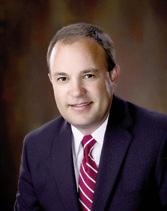
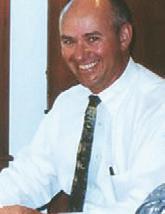
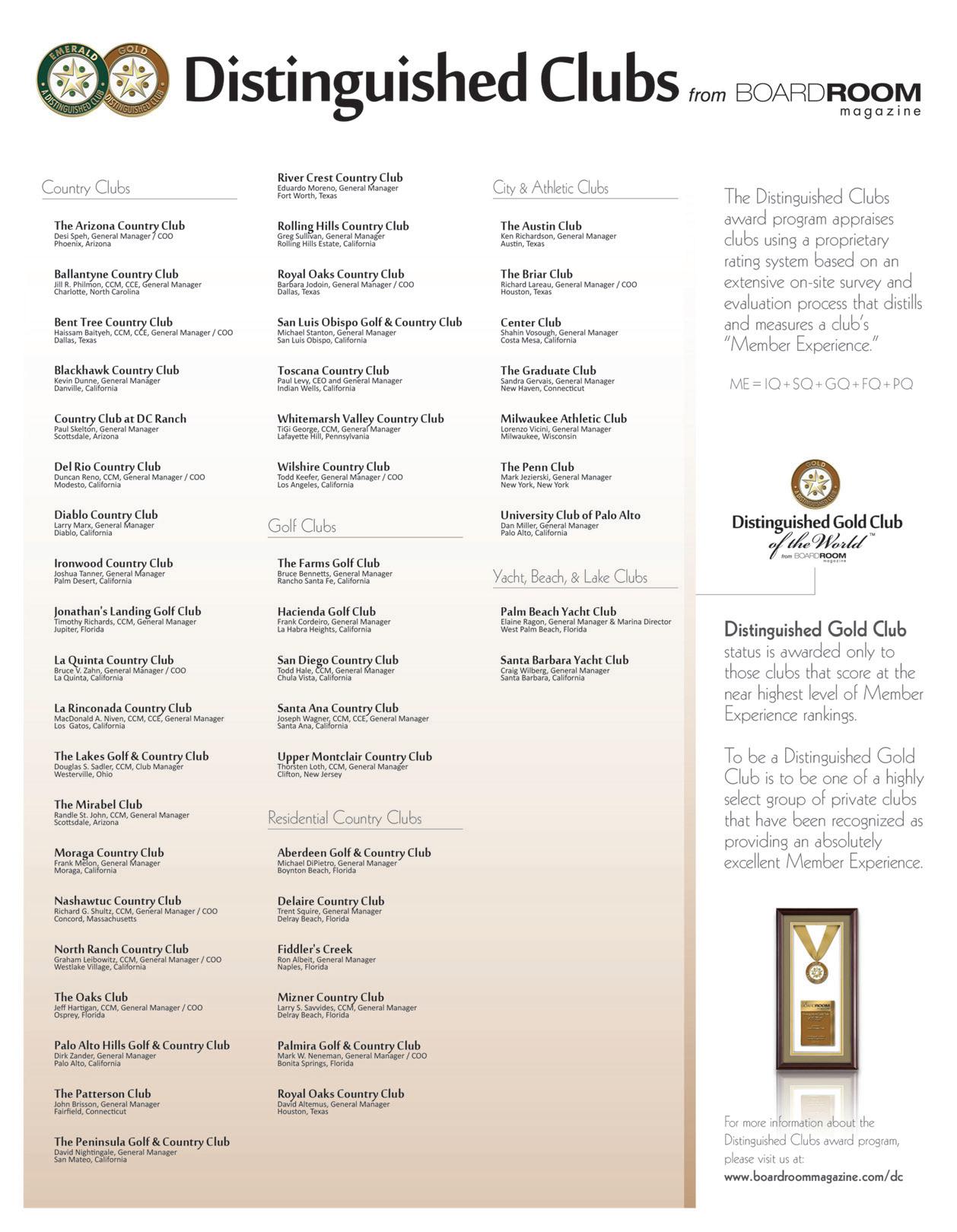
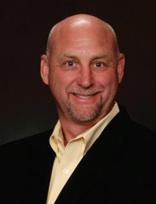
BOB BODMAN
The board of directors of a client club recently formed a task group to set capital projects priorities that were identified in their strategic planning process.
As membership consultant, and also the one responsible for actually selling the memberships, I was asked the question: “Which capital investment would improve membership sales?”
There are five proposed projects – three on the current “golf course master plan”, a new one to add a fitness center and upgrade the existing pool facilities, and lastly, a plan to remodel the grill room and formal dining spaces.
Which of these would sell more memberships? Or, are there other projects that could sell more memberships? Tough questions.
First, some side notes about capital project expectations:
1. Unless a capital project is designed to specifically meet a clearly demonstrated and unfilled demand in the marketplace, it’s not likely that it will be a direct catalyst to membership growth.
2. Many capital projects can actually detract from membership sales if they: (a) are unpopular with a large percentage of members, (b) involve a substantial assessment that might add also raise the cost to new members, and (c) create a disruption in use, such as a complete golf course remodel or new clubhouse.
3. Large capital projects carry the hope and intent that, when completed, the improvements will be appreciated by the current members and will, therefore, be appreciated by future prospective members. This is not necessarily the case.
4. Certain capital projects, properly planned and executed, can provide significant enthusiasm for joining the club (i.e., sell memberships).
When prioritizing capital projects, we recommend following a logical path of consideration: Fundamentals: In terms of selling memberships, one of the most important fundamental relates to “first impressions.” Before a new
member prospect is concerned about the club’s future capital plan, they compare their initial experience with their expectations.
This is critical, and is especially critical for clubs emerging from the recent recession with a long list of deferred capital maintenance. In terms of growing membership, there is no greater priority than how the club operates and is presented on a day-to-day basis.
Current/existing plans. Next, we look to see if the club actually has an existing priority list (a capital improvement and replacement plan), one that has been published and communicated. If so, is it being executed?
Prospective members are not only concerned about large, future assessments that will impact their decision, but they also want to be sure the club has not been deferring necessary projects either. No one likes surprise assessments.
Enhanced operations. One way to increase membership sales involves taking the club’s service and quality levels to higher levels. Having a plan to catch up to pre-recession levels of operations and facilities is a given, whereas, it may be necessary to go beyond where the club was before the recession.
New capital projects. What is the capital plan designed to accomplish? Clubs are nearly always in conflict, trying to appease its current members while also trying to attract new members. What the club currently offers is the essence of what the club is — its DNA, its culture. Whereas, breaking away from the past to add new amenities and services is often necessary to attract new members going forward.
The answer to prioritizing new capital projects lies within the club’s vision for the future and whether or not that vision is relevant to the market for future members. BR
To learn more about this and other membership marketing related subjects, contact Bob Bodman, President of Club Resources (800) 267-6758 or via email: Bob@ClubResources.com
Since the economic recovery started, the private club industry has taken more notice of membership recruitment and retention.
The efforts in combating the lower matriculation numbers and higher attrition percentages have encouraged leadership in private clubs to better understand the need for a full time membership professional.
The demand to recruit good membership marketing and sales professionals has surfaced and therefore requires the leadership within private clubs to become more familiar with the elements involved in hiring a membership professional.
More membership professionals have been placed in private clubs of all tiers, status and rank. So are you fully aware of what your club should be doing to prepare for this much needed position within the privates club of today?
Here are a few guidelines to consider when going through the process of interviewing membership professional candidates for your team of experts.
First, understand that hiring the right membership professional can mean the difference between sinking and survival to your club. The marketing aspect pertains to the matriculation of new members or the enhanced participation of club events, and marketing is the initial step to creating more awareness, not to discounting the selling process.
Hiring the wrong membership professional can be worse for your club than hiring no membership professional! The key is determining your club’s needs in accomplishing the goal of matriculating more members and retaining the ones you have.
Many in leadership of our industry equate membership marketing to being membership sales. Marketing and sales are not one and the same, they go together to bring on success, but they are not the same.
Many sales professional résumés say, “sales and marketing,” but in reality they have done only sales and perhaps designed a brochure or two. It’s important for you to understand the difference between sales and marketing:
• Sales is everything you do to get the prospect to buy your service or product. Sales usually involve tactics and logistics, and involve the prospects in the actual decision-making process.
• Marketing is everything you do to find and position the prospects for a sale…to get them to that decision-making point. Marketing is more strategy than tactics.
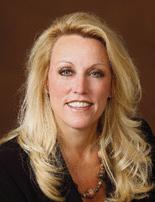
Hiring the right membership professional can mean the difference between sinking and survival to your club. The marketing aspect pertains to the matriculation of new members or the enhanced participation of club events, and marketing is the initial step to creating more awareness, not to discounting the selling process.
The following tips help determine whether a potential candidate is truly a “marketing” professional or primarily a sales professional.
In screening résumés for membership professionals, some things should send up a red flare if you see them:
SEE MEMBERSHIP MARKETING | 104

Paul L. Carter, a certified golf course superintendent (CGCS) at Bear Trace at Harrison Bay, Tenn., for the last 13 years, has received numerous awards for his work.
But the 2015 President’s Award for Environmental Stewardship he recently received from the Golf Course Superintendents Association of America (GCSAA) is the best of the bunch.
“This is a tremendous honor,” said the 45-year-old Carter, who was also recently recognized by the U.S. Golf Association as a Champion of the Game. “I consider myself fortunate to have been considered and even more blessed to receive the award.
The GCSAA President’s Award, established in 1991 recognizes “an exceptional environmental contribution to the game of golf; a contribution that further exemplifies the golf course superintendent’s image as a steward of the land.”
“Paul’s work is a shining example for all superintendents,” said GCSAA President Keith Ihms. “Through his impactful environmental stewardship, he demonstrates the full benefits of what golf courses can be for recreation and a healthy environment through professional management. We are pleased to honor him for his accomplishments.”
2012. The award-winning course is a Jack Nicklaus design that is one of nine courses on the Tennessee Golf Trail.
In addition, Bear Trace has been designated a groundwater guardian green site as a result of Carter’s management, which has eliminated pollution in groundwater runoff. He has managed on-course changes as well: moving to a more suitable bermudagrass turf and reducing chemical use by 75 percent with a variety of conservation programs.
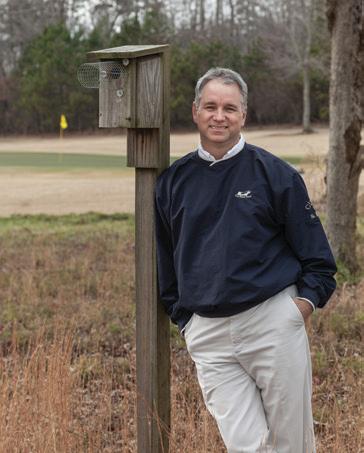
He also trimmed 50 acres of highly managed turf to save more than 7.4 million gallons of water annually.
And two years ago, he converted all his equipment from gas-powered to battery-powered, saving 9,000 gallons of fuel each year and giving his course more than 300 days a year of zero emissions.
Knowing all that Carter has accomplished, Bear Trace general manager Robin Boyer is thrilled that Carter is still around.
A 22-year member of GCSAA, Carter has been actively working to promote environmentally friendly golf from the start. A graduate of Auburn University, where he earned a bachelor’s degree in horticulture-landscape design, Carter previously won the GCSAA national public and overall Environmental Leadership in Golf Award in 2013 after four consecutive association regional awards for environmental leadership (2009-12).
He also brought Bear Trace to certification in 2008 as one of just seven golf courses in Tennessee in the Audubon Cooperative Sanctuary Program for Golf Courses. The course also is one of only six in the U.S. to earn certification with the Golf Environment Organization (GEO).
Bear Trace has also been recognized twice for the Governor’s Environmental Stewardship Award, in 2009 and
“I’m really surprised he hasn’t left,” Boyer said. “I would think he could go anywhere, if he wanted. Paul is such a great ambassador. I learned a long time ago the most important person you have on your staff is the golf course superintendent. It’s not me. People come out here for the course conditions.”
Bear Trace is tucked in the Northeast corner of the state, and it gets about 30,000 rounds annually, which is a testament to Carter’s on-course magic that he accomplishes with a small staff and a small budget.
“I tell people, not everybody can do everything we do, but do what you can,” said Carter. “Everybody can do something.”
For a full list of past winners, visit www.gcsaa.org/community/awards. BR
Craig Smith is director, communications and media relations, Golf Course Superintendents Association of America, Lawrence, KS. He can be reached at (800) 472-7878, ext. 4431
Recently while a attending a seminar, the superintendent of the Northern California golf course hosting the event, wanted to discuss the existing conditions at his course, as well as the procedures being recommended for the root systems of the greens.
The root system of the turf on his green hovered around a half-inch.
The club’s expert consultants had recommended an extensive disruptive aerifying as a solution. But they were making these suggestions based on their own personal experience, and not on condition and physical properties of the greens.
The superintendent had been aerifying at an aggressive rate for six months and causing heaving of turf on the greens.
The experts shrugged this off, saying that more aerifying was needed and that conditions would improve.
The superintendent is a commonsense person and began to questions whether or not this extensive aerifying program was causing damage to his greens.
After inspecting the greens’ turf and root systems I strongly recommended that a physical properties test be conducted and from that we would see what was needed, from an agronomical standpoint.
The physical properties analysis showed that the greens did not need disruptive aerification. In fact the opposite was true. The greens were too porous and in need of increased water and nutrients.
With this new information about the physical properties added to the knowledge of the chemical properties, we were able to start a new program of venting and top dressing.
After four months this has resulted in a root system that has increased to two and a half inches in depth.
These roots, which before the new program were sparse and tan colored, had now become dense and white in color.
The putting surfaces have increased in density by at least two fold and ball marks are now healing at an acceptable rate rather than staying open for extended periods of time.
Between Thanksgiving and Christmas of 2014 this course received 16-plus inches of rain after five years of drought.
Many of the courses in the area suffered turf loss because of the heavy rainfall. However this course took the rain without any negative effects.
The experts who had originally recommended the heavy disruptive aerifying program were impressed with the turnaround, recanted their original recommendations and asked that additional physical and chemical properties’ testing be done at the end of the year in order to evaluate if any changes needed to be made to the new program.
Mr. “M”, the superintendent, says that since the original physical properties testing was completed in November 2014, the present agricultural program has proven successful.
He informs me that with the healthy greens rounds have increased.
Players, management and consultants are happy and everyone is very confident that the course will be ready for the spring tournament regardless of weather.
When commonsense is used, instead of inflated egos, and in conjunction with basic science, it is really quite amazing what can be accomplished. BR
Dave Doherty is CEO and founder of the International Sports Turf Research Center, Inc. (ISTRC) and holds three patents regarding the testing of sand and soil-based greens. He can be reached at (913) 706-6635 or via email: daveistrc@hotmail.comwww.davedohertyistrc.com
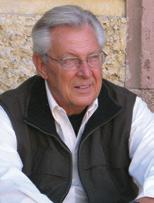
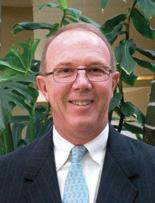
“Is Golf on the Rebound?” That’s a frequently asked question these days and the answer is surely “yes.”
However we must look a bit deeper so see how quickly that will happen and also what are the steps taken to recover as best we can.
In a matter of a few years the economy bottomed out with what some would call a recession the likes of which we hadn’t seen since the Great Depression in 1929.
The economic downturn affected a number of things, all of which impacted golf negatively. Housing values plummeted, unemployment reached new highs, and people lost their discretionary income that allowed them to participate in sports as they concentrated on paying their bills rather than enjoying life.
We saw more golf courses closing in the US than there were new ones opening. That decline

has not stopped but it has surely lessened. The period we are in now tends to be a right sizing for the golf industry and perhaps the previous overbuilding required such an adjustment.
It is doubtful that we will ever see a growth spurt in golf like we saw during the 50s and the 80s and early 90s. But we will see golf grow again and most likely it will not be as real estate driven as it has been in recent decades.
deally it will be driven on need in any geographical area.
Golf needs heroes and champions to attract the next generation. Tiger Woods was great for the game as was Arnie and Jack and let’s hope we see the next great set of players come along on both the men and women’s sides of the sports.
Golf facilities need to develop entry-level programs to encourage the next generation to enter the game. Times change and so do leisure time activities. The concept of build it and they will come most likely will not apply to golf.
Therefore let’s hope we in the sport can encourage others to embrace the sport as we have for decades. We need to make golf user friendly and that may mean foot golf and other non-traditional forms of the sport. Top golf driving ranges are flourishing with the younger crowd as waiting lists continue to grow at many of the private country clubs across the US.
Only a few courses should be designed and managed to the caliber of holding a US Open. For the most part we need courses people can play in four hours and that a family can enjoy playing together.
It is doubtful that will happen with three-inch roughs and 12-foot Stimpmeter readings on the greens.
There will still be real estate driven golf facilities as more people move to the Sunbelt and Baby Boomers retire. Developers need to have a long-range strategy for operation of
golf facilities once the real estate is sold out. Golf courses will need to be subsidized able beyond the subsidization of operational expenses as a marketing tool for selling real estate. Whatever they are doing at The Villages, in Florida, seems to be working!
If you are doing business the way you were doing business 10 years ago you are likely out of business in the golf world. Leaders need to think of new strategies to balance the books at their golf courses. We have seen formal dining go away in most cases and informal dining and easing of dress codes.
Outside revenue has been sought and the concept of Monday outings has even spread to other weekdays. Successful clubs are doing whatever it takes to bring in revenue.
Once you cut the fat out of the budget eventually you will start cutting into the bone. So it’s sad to see so many golf courses stop taking care of infrastructure. Golf courses and clubhouses need maintenance and upkeep.
At some point things are reduced to the point of no return. Roof repair is different that roof replacement. The same is true for equipment on the golf course.
Equipment, irrigation systems and even bunkers have a life expectancy. Make your long range plan to include upgrade and replacement of these items in a timely fashion. Failure to do so will result in larger costs down the line.
As the economy improves and golf recovers there will be great competition for players.
With fewer players and fewer golf courses successful operators will need to upgrade their bunkers, provide good turf and have a fun facility to play.
Most cities are seeing clubs invest in their infrastructure again and spending will yield new and more players.
Golf facilities need to develop entry-level programs to encourage the next generation to enter the game. Times change and so do leisure time activities. The concept of build it and they will come most likely will not apply to golf. Therefore let’s hope we in the sport can encourage others to embrace the sport as we have for decades. Top golf driving ranges are flourishing with the younger crowd as waiting lists continue to grow at many of the private country clubs across the US.
As I see it the recovery will be slow but sure. There will be a new normal for golf. Facilities that are willing to change will survive. Those that don’t may have to close. Now is the time to plan the future so your facility and the game can once again prosper! BR
Bruce R. Williams, CGCS is the principal of Bruce Williams Golf Consulting as well as Executive Golf Search, which special-
izes in headhunting for golf course superintendents and industry positions (www.EGSinc.net). Consulting includes working with golf facilities on agronomic plans, development of written standards, and fiscal management for golf course operations. Bruce may be contacted at Bruce@WilliamsGolfConsulting.com or (310) 991-9176.
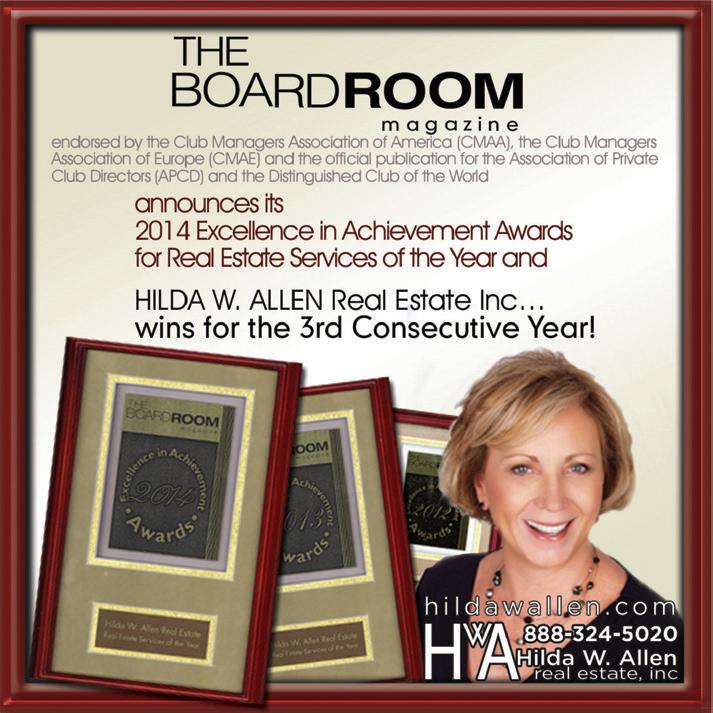

Yesterday was annual meeting day. Lots of members in attendance, because last year was a “biggie” and next year will be “bigger still.”
Annual meetings are always a hoot – our “once-a-year” opportunity for the board and management team to inform the membership and illuminate the issues, to explain a few of the “whys” and “why nots”, to commiserate and to celebrate, to count our blessings and to heal our wounds, to align expectations and to prime ourselves for the future; and to enjoy free food and booze once the yakking’s done.
A gathering of the tribe – and in a good year like the last, a time to cheer and shout and pound our chests.
The president opened with the traditional big welcome, raced through the ‘business side’ of the agenda; approval of Minutes, results of the election, thanking people who deserved to be thanked, then leaped into the meat of the meeting with his delivery of the “State of the Club” address.
He dissected the year’s “black swans”, reviewed the board’s response to the issues that they faced and highlighted the policies that emerged from the decisions they made. As ever, he was the great communicator. Clear. Confident. A commanding presence. A real leader. Resounding applause. Well deserved.
The president turned and introduced me, the general manager, as “He Who Is Responsible” for the administrative side of the club equation. My Mission? To highlight the stuff the troops did to translate “board vision” into action, to introduce the supervisors who led the teams who did the stuff that needed doing and to do all this “highlighting” and introducing with “The Buzz.” Moments before my intro, I was still pondering how best to deliver the highlights and the introductions with The Buzz when POOF, milliseconds before leaping on stage, it came to me in a flash. A brainstorm, a “theme” for my speechifying. Something from my annual review. The report card the President used to evaluate me. The Body Count
Why not shake up my “usual and routine” state of the administration presentation with an up-front-and-in-your-face evaluation of the president – assign him a grade, publically evaluate his performance as leader using the same criteria he and the review committee used to evaluate me during this year’s end-of-year general manager review? Unannounced. Un-scripted. In public…at the annual meeting. A shocker…I stepped to the podium and began.
“Last year was the year of chaos. Strange stuff happened – often. People were weird –often. The unanticipated was the norm – often. Everyone got into weird – members, staff, the plumbing, the refrigerators, the city, the state.
It seemed like weirdness was all around us, complicating operations and impacting the club experience day in and day out. And as anyone who’s encountered the unanticipated knows, when chaos reigns and the usual and the routine go out the window. Leadership’s needed. And the leader will be judged on how they lead the troops through the madness. Silence.
The audience is wondering – what gives???
“Everyone has a scorecard they use to judge “the cheese in charge” – in my case, the club president. Sometimes the scorecard people use to judge others and the scorecard they use to judge themselves, are in alignment – sometimes not. I don’t know what scorecard each of you uses to judge the leader in a club like ours, but here’s mine. The Body Count. Let’s see how this year’s leader scored.”
Silence. The audience is still wondering –what gives???
“First I evaluate the head. Brains. Is this year’s president a “clever piece of equipment?” Can he analyze financial statements and explain the numbers to the masses? 10 out of 10. Can he dig through beach lease mumbo jumbo and explain it to the masses? 10 out of 10. Is he able to consume and understand loan docs? 10 out of 10. Head count – 10 our of 10.”
The audience murmurs “yessss.”
“Second I evaluate the heart. Big love. Does this year’s president have the love for the club? 10 out of 10. Does this year’s president have
the love for the members? 10 out of 10. Does this year’s president have the love for the staff10 out of 10. Did this year’s president have his heart in the right place? 10 out of 10. Heart count– 10 out of 10.”
The audience—-Smiles “yesss.”
“Third I evaluate…the hands Making stuff happen. Did this year’s president get bankers to change the terms of the loan they offered? 10 out of 10. Did this year’s president get contractors to finish on time and under budge? 10 out of 10. Did this year’s president counsel the wayward and get them to go rightward? 10 out of 10.Hand count10 out of 10.”
The audience—-Claps “yesss.”
“Fourth I evaluate the stomach. Gut instinct for making the right decision. The stomach to do the right thing once the tough decision’s been made. Did this year’s president gauge how far the others would go during zoning negotiations? 10 out of 10. Did this year’s president have the gut instinct to handle recalcitrant and unreasonable members? 10 out of 10.
Did this year’s President have right intuition to select the right president for the coming year, the right chairmen for each of the committees, the right big project to pursue, the right presentation format for the big project forums? 10 out of 10.
Did this year’s president correctly gauge the mood of the members for funding the big project? 10 out of 10. Did he have the right gut instinct when it came to pushing the big project? 10 out of 10.
Did this year’s president have the stomach to tell the members that the controversial big project was going forward and each of them would be assessed to ensure its completion? 10 out of 10. Stomach count– 10 out of 10.
The audience nods “yesss.”
“Fifth I evaluate the feet. Was he the symbol of the good? Did this year’s president walk the talk and do what he said he’d do? 10 out of 10. Did this year’s president look right, speak right,
smile right, do right when meeting staff, members and guests? 10 out of 10. Could members and staff point to him with pride and say he’s our leader, our philosopher king, our big cheese? 10 out of 10. Feet count – 10 out of 10.
The audience stomps “yesss.”
“So this year’s president’s body count was a solid 100 out of 100. But there’s always room in the body count for “above and beyond”, for earning extra, and since this year’s Prez had that intangible something extra, that elusive “hard to define” that The Best seems to have but nobody can explain, he’s going to get an extra 23 points on the body count scale, hitting an all-time high of 123 out of 100.”
The audience murmurs, smiles, nods, claps, stomps and shouts “Yesssssssssss.”
“So ladies and gentlemen, boys and girls, children and old people, staff and committee members, this year’s president has “done good.” The highest body count ever, The Big Cheese has delivered. Let’s stand and salute our leader!!!”
And all stood. The members. The board. The staff. The aged and the infirm, and roared their approval.
My unrehearsed first-time-ever-inpublic report card was an absolutely “no risk proposition” for me or The Prez because this year’s president was special, the absolute best ever, in a long, long line of extraordinary club presidents.
It’s easy to go public with a leadership evaluation when the leader you’re evaluating is a bona fide superstar…Life’s good at the club when the president’s a winner. With an “off the charts” body count. Head. Heart. Hands. Stomach. Feet. Finding a president with the goods with a body count over 100…ain’t easy. But it happens. We got lucky. You may. Keep hoping. And enjoy the journey—- BR
Gregg Patterson is general manager of the Beach Club of Santa Monica and a regular contributor to BoardRoom magazine.
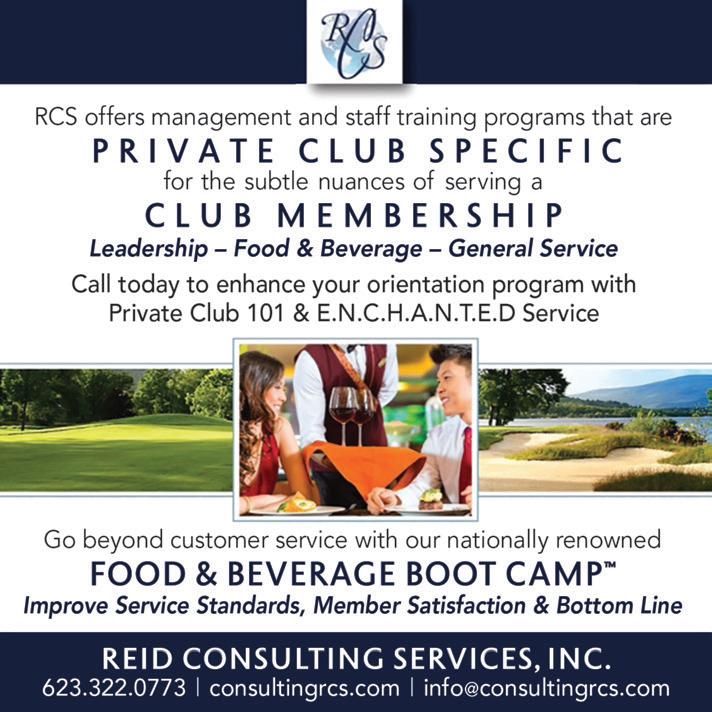
1. Short periods of employment. Less than a year at a company can mean nothing in today’s world of “dot-bombs,” but seeing several short periods can be cause for concern. Many candidates thrive in the fastpaced world of the start-up, and will accept positions with them again and again in spite of a setback with their previous employer.
2. Titles that don’t reflect growth. Was the candidate a vice president in one period and then marketing manager in the next? Many start-up companies use titles that don’t reflect the employee’s true responsibilities. Or perhaps they found after hiring that the person didn’t have the expertise needed for the job, and so demoted them to a lesser position. A candidate that has moved from company to company with the same job title may be jumping ship just to get more money.
3. Responsibilities that seem more administrative than managerial. Look for more things like target market analysis, result tracking, results reporting, branding, advertising and public relations experience.
Knowing exactly what you want to accomplish by hiring a membership professional is the first step in developing the right interview questions. Depending on the needs, culture and the fit for your club will determine in most cases the success of your hire being the right person.
If you know the specific roles and responsibilities of the position to reach your goals then you can ask the proper interview questions.
Here are a few questions you might ask for marketing positions:
• How do you prepare a marketing campaign? (The answer should contain specifics about how they deter-

mined the target market, what type of campaign they decided on and why.)
• How do you determine whether the campaign was successful or not? (How did they measure success? What was the cost to market to acquire valid leads? How much did sales increase as a result of the campaign?)
• Tell me about a marketing initiative that you brought in on time and on budget.
• What sort of experience do you have in public relations? (Public relations covers much more than press releases!)
• What associations do you belong to related to marketing?
Since the membership professional typically works closely with (or, in some cases, is accountable for) the sales, their leadership qualities as well as people skills will be important as well. Ask the following questions:
• What are three effective leadership qualities you think are important? How have you demonstrated these qualities in your past/current position?
• Describe a leadership situation that you would handle differently if you had it to do over again.
• What is the best quality you can possess as a sales professional, when working with prospects?
• What tactics are best when following up with a prospect?
Thekey in hiring the right membership professional for your club is knowing the right questions to ask to get the answers that will define the candidate’s understanding of the position, their performance expectations, and will at least define the candidate as having the ability to reach the goals and objectives club’s position. BR
Donna Coyne is CEO/placement specialist with Professional Club Placement Services. She can be reach via email: donna@pcps4u.com
You see, whenever I had a business meeting or just dinner with friends, I usually ended up at Marco’s restaurant. Why? I knew, from experience, my guests would be treated ‘special’, and my business clients would be impressed with the way Marco and his staff treated us. It would make me look even better.
could sense on Christmas morning… people seemed friendlier, happier; people were sharing.
“It wasn’t about me, it’s about others,” Marco would say. And it certainly was about others, because many charities benefited from Marco’s generosity and kindness, and not only during the Christmas season but everyday of the year. Marco wanted everyone to have that ‘happy feeling’ every day.
ized, when he visited California or when we traveled on holidays together, he always offered guidance, advice about the meaning of life…he was very caring, very giving.
You see, whenever I had a business meeting or just dinner with friends, I usually ended up at Marco’s restaurant. Why?
I knew, from experience, my guests would be treated ‘special’, and my business clients would be impressed with the way Marco and his staff treated us. It would make me look even better.
A New York Times reporter, writing about Marco during a visit to Calgary related some thoughts that ring true. The first time the reporter visited La Brezza in 2005, Calgary was in recession.
“Everyone in the restaurant looked a little glum. All of a sudden, this tall black man comes out of the kitchen with this huge smile and yells out, ‘Merry Christmas.’ It’s July. Everyone in the room instantly had a smile on their face. He talked to everyone, joking about everything,” the Times report said.
It’s just as Marco said, so often: “For me, every day is Merry Christmas. My father told me that you are born with nothing and you die with nothing and every day in
between is Christmas. When you die you’re not going to take anything with you. My gift to you is happiness.”
He made everyone in his restaurant feel special, just like it was Christmas morning – that was Marco’s trademark.
But the fact is, Marco, a Muslim from Somali, as he explained to me, loved the unique feeling everyone
Marco was never trained in the restaurant business. He didn’t cook, but he could find out what people wanted…what they wanted their experience to be at his restaurant. He said, “I don’t need to read a book to find out what people want.” He knew his customers were there for the culinary experience…the Marco experience , like what we in the private club industry call the member experience

What I didn’t realize until now, after his death, is that Marco’s actions and advice guided me to better understand the private club industry, private clubs and the member experience.
Our members want the same thing as Marco was able to offer his many patrons for 30 years…a special experience. So, what can we offer our members that the best, most famous restaurants do not?
We can give our members what they can’t just buy – it’s the DNA of a private club, and what makes private clubs so important in our members’ lives…a meaningful, memorable, fun, unusual and unexpected experience.
remain relevant in the future, it’s this ‘looking after…the member experience’ that we need to ensure happens for members.
Marco’s passing has had a great impact on both my wife Denise and me, as it has the thousands who showed up for his memorial service in Calgary, a tribute from everyone he made feel so special.
In Calgary, a city of 1.2 million, people paid tribute to my friend Marco, a simple man from Somali.
Today Calgary, Alberta with fewer than three percent Muslims has Naheed Nenshi as the first Muslim mayor in a major North American city, a mayor who easily won a second four-year in the most recent mayoral race and enjoys an 80 percent approval rating.
What I didn’t realize until now, after his death, is that Marco’s actions and advice guided me to better understand the private club industry, private clubs and the member experience. We can give our members what they can’t just buy – it’s the DNA of a private club, and what makes private clubs so important in our members’ lives…a meaningful, memorable, fun, unusual and unexpected experience. My friend Marco was able to do all that seemingly without effort or expense, but in order for our industry to remain relevant in the future, it’s this ‘looking after… the member experience’ that we need to ensure happens for members.
What Marco did in his restaurant didn’t cost him a cent. Yet the experience he offered was worth more than the meal…far more! He was one of a kind.
Recently I wrote about a private club board president in Florida, who, while the general manager was showing me all the club’s improvements, pulled me aside and said, ‘let’s go for a walk.’
We talked that day about how much he pays his GM, and why so much. This club president had worked for 40 years looking after his family and 1,000 employees in the firm.
Once retired, he wanted someone to look after him and his family for the last 20 or so years of his life. He wants to feel special, important; he wants to impress his friends and family and be happy – the meaning of ‘member experience’ at our private clubs.
My friend Marco was able to do all that seemingly without effort or expense, but in order for our industry to
I believe Marco, a black Somalian-Italian Muslim, who showed so much kindness, and not the extremist views you see in the news every day, changed the misconceptions and ignorance of many people, including me, during his shortened lifetime.
So thank you for taking the time to read something that means so much to me, and its relevance in my life and our industry, and letting me share my friend Marco with you…
At least that’s the way I see it! BR
John G. Fornaro, publisher
If you have comments on this article or suggestions for other topics, please contact John Fornaro at (949) 376-8889 or via email: johnf@apcd.com

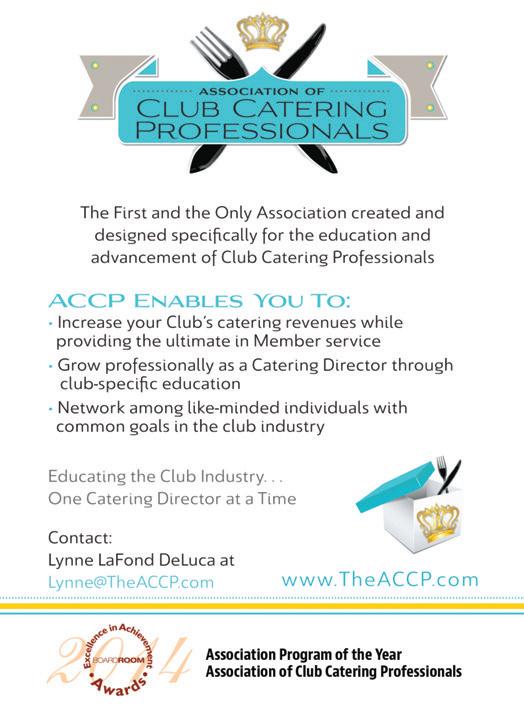
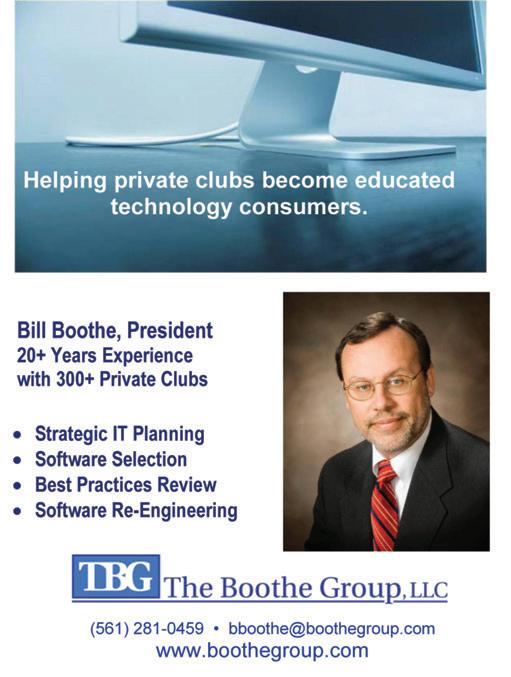


Sorry, not my section. Not my section!
How many times did I hear that in my early days of waiting on tables?
If I heard that as a guest, I’d be inclined to leave the restaurant. It’s the bane of good service. Watch staff from afar on occasion and you can see this happen often.
One club I worked in way back in the day was very seasonal so there was a very small core staff. Everyone loved one server in particular - she could do no wrong. I had worked with her for a while and I quietly observed the lack of teamwork she displayed. At brunch one day when I noticed another server in the front section happened to be swamped - he couldn’t even keep up with beverage service much less keep guests’ water glasses filled.
The tenured staff member, loved by all was in the next section smiling and kissing babies but she was not helping her associate out at all. She had the Not My Section (NMS) syndrome. When approached to help out, she always became very busy instantly. Funny, how that worked. Managers saw it and certainly the team noticed it, but most members were oblivious.
I knew a chef once, running a great restaurant in San Francisco back in the 1980s who related all sorts of stories about his adventures in that culinary world.
He once spoke of a labor situation that causes employees to really departmentalize their work. He operated a big kitchen with a complicated line of production. He related how, on very busy days, the grill cook and the fish cook worked side by side on the hot line, firing out the orders as they came through their stations.
Sometimes one guy would get more orders than he could handle so the “tournant” or rotating relief cook would come over to bail out whoever need the help. Sometimes the tournant would be occupied elsewhere, and when that happened and the grill guy usually got slammed at the same time, there was never any effort from his station neighbor, the fish guy to come over and help out.
Really, a sad state of affairs. The NMS syndrome is everywhere. In the kitchen, out in the golf shop bag room and more.
In clubs, we run into this a lot. Line staff members work their areas very well but are not necessarily working for the ‘whole’ operational goals. This is especially prevalent in hourly-pay-only clubs where it’s really the hourly wage they are there for, and there’s no tip pool percentage or other incentive to produce more or to be more productive.
Tenured staff gets used to the slower pace of club business and sometimes, when they get very busy, they need help. On the other hand, at times, that tenured employee may be covering their “section” but not paying attention to the big picture. Yes, I’ve witnessed staff, well liked by members, ignore their counterparts when the schmutz hits the fan.
This is a cautionary tale I tell for the benefit of managers and especially board members in clubs. Certainly we love our staffs at our clubs. They are like family. They’ve known our friends and family, watched our kids grow up, helped at our daughter’s wedding and our parent’s funeral. They are special.
But just be aware of the staff you endear. Be careful how much you listen to. Usually the staff members who feel free to yak with members about club issues or other staff or management are going down a dark path.
Be careful what you agree to; be careful to support any suggestions and, most importantly, be aware of their work ethic. It may seem to be good but your manager may feel differently.
Over-support of staff can be undermining the operation. Sure you may love them but have you ever worked with them? Seen them in the back of the house?
There are many, very well intended staff - especially our treasured tenured staff - who are awesome in all ways. But there are a few who can inflict damage and cause dissension in the ranks. Many of these can be identified with those lack-ofteamwork indicators that show the NMS attitude. Hospitality leadership is a journey…one with many rewards and a few potholes in the road. Have fun, be careful, enjoy the adventure and lead ON! BR
Christopher Boettcher is the GM/COO at Burlingame Country Club near San Francisco, CA. and can be reached at chris@boettcher.com
flicts of interests. Boards should remind themselves of these duties on a regular basis.
Laughlin encourages clubs to create a comprehensive plan of governance as part of a Board Policy Manual, which sets out guiding principles for governing the club. “Governance is the way a club exercises authority.”
A strategy is an approach to realizing the club’s vision or achieving its mission. Because a board is required by the state to carry out the governance duties of care, loyalty and obedience, it must have a governance model. While it is not required by law to have a strategy, good boards will address their duty of care by formulating a strategic plan and honoring it over time.
“Good boards document how they will carry out their duties to govern, chart a course for the club in a strategic plan and then ensure that decisions are made consistent with the plan,” Laughlin adds.
A 2014 survey of club managers conducted by Global Golf Advisors identified several important characteristics of effective boards:
• Almost 85 percent of boards meet at least 10 times per year
• Boards with BPMs reported shorter and fewer meetings than those without a BPM
• Three-year terms for board service are the norm at 90 percent of responding clubs
• 93 percent of clubs limit the number of consecutive terms for board service
• Term limits for presidents are two years in 80 percent of clubs
• 49 percent of respondents said they operate with a BPM.
The most alarming finding of the GGA governance survey was the belief among 73 percent of club managers that their directors bring a personal agenda to their board service.
The efficiency and effectiveness of board meetings is always a point of focus for good governance standards. Among the tactics reported for improving board performance are:
• Using a formal board orientation process (75 percent)
• Having an annual board retreat (48 percent)
• Conducting regular board training and education (37 percent)
• Reducing the number of committees (20 percent)
• Implementing a board (self) evaluation process (18 percent)
The importance of board efficiency and governing harmony is critical, according to Philip Newman, a private club practice partner at McGladrey, one of the leading accounting firms in club management. “Healthy debate should be encouraged and practiced, but discord in the boardroom does no one any good,” he says.
Newman advises club managers to help board members by routinely investing in governance training, orientation sessions, strategic planning and governance audits. “Remember a club cannot audit anything unless established standards exist,” he says. To that end, one of the benefits of a BPM is that it establishes the expected standards against which the board can evaluate its own performance.
Effective strategic planning at top performing clubs is based on a solid foundation of stable and trusted governance. You can’t have one without the other. BR
Henry DeLozier, a recipient of the BoardRoom magazine Lifetime
Achievement award for 2014, is a principal of Global Golf Advisors. You can contact him at hdelozier@globalgolfadvisors.com.

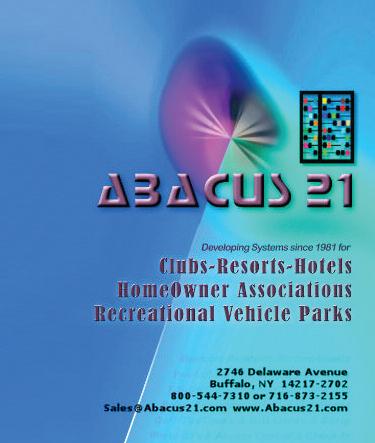






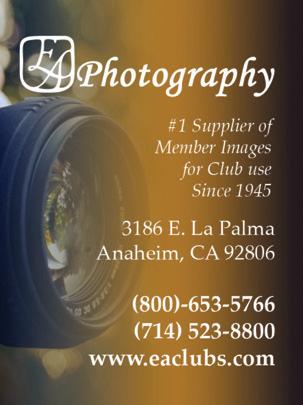











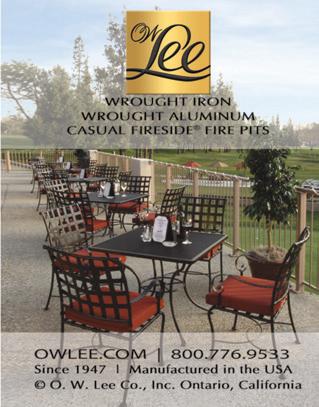
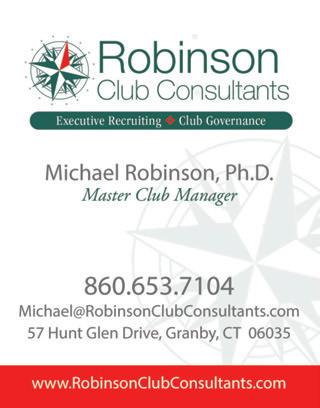
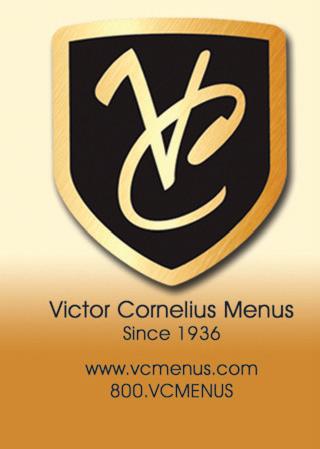











EG Communications
6750 N. Andrews Avenue
Fort Lauderdale, FL 33309
Tel: (954) 958-0338 Fax: (954) 928-2801
Website: www.eurographics.com
Email: martin@eurographics.com
Contact: Martin Marinov, president
Attorneys
Addison Law Firm
14901 Quorum Drive, Ste. 650 Dallas, TX 75254
Tel: (972) 960-8677 Fax: (972) 960-7719
Website: www.addisonlaw.com
Email: clublaw@addisonlaw.com
Contact: Randolph Addison, president
Club Advisory Services
Club Consultants LLC
5121 Castello Drive, Suite 1
Naples, FL 34103
Tel: (239) 643-7800 Fax: (239) 643-7803
Website: www.clubconsultants.com
Contact: Bill Wernersback, sr. mng. dir.
Club Neckties, Scarves, Emblems
Stratton-Crooke Enterprises Inc.
P. O. Box 215-H
Scarsdale, NY 10583
Tel: (800) 732-9719 Fax: (914) 725-5196
Website: www.strattoncrooke.com
Email: StrattonCrooke@aol.com
Contact: Nancy & Jim Crooke
Club Services
HFTP
11709 Boulder Lane, STE 110
Austin, TX 78726-1832
Tel: (512) 249-5333 Fax: (512) 249-1533
Website: www.hftp.org
Email: Laura.Huffman@hftp.org
Contact: Laura Huffman
Clubhouse Design
Chambers
100 Decker Drive, Suite 140
Irving, TX 75062
Tel: (972) 253-3583 Fax: (972) 259-9664
Website: cciclubdesign.com
Chambers
1800 Washington Blvd., Suite 111
Baltimore, MD 21230
Tel: (410) 727-4535 Fax: (410) 727-6982
Website: www.chambersusa.com
Email: jsnellinger@chambersusa.com
Contact: John R. Snellinger
Peacock + Lewis Architects
11770 US Hwy One, Ste. 402
North Palm Beach, FL 33408
Tel: (561) 626-9704 Fax: (561) 626-9719
Website: www.peacocklewis.com
Email: Brian@peacocklewis.com
Contact: Brian Idle
Clubhouse Architect
Judd Brown Designs
700 School Street
Pawtucket, RI (401) 721-0977
Contact: Peter Cafaro
H. Anne Blakely Sciarrone Architecture
P.O. Box 357
Decatur, GA 30031
(678) 632-2663
Contact: Anne Sciarrone
Clubhouse Furniture
Eustis Chair
P.O. Box 842
Ashburnham, MA 01430
Tel: (978) 827-3103 Fax: (978) 827-3040
Web site: www.eustischair.com
E-Mail: fred@eustischair.com
Contact: Fred Eustis
Gasser Chairs
4136 Logan Way
Youngstown, OH 44505
Tel: (330) 759-2234 Fax: (330) 759-9844
Web site: www.gasserchair.com
Email: ksmith@gasserchair.com
Contact: Kevin Smith
Global Allies
625 DuBois Street, #A
San Rafael, CA 94901
Tel: (877) 208-7185 Fax: (415) 453-6042
Web site: www.globalallies.com
Contact: David Cline
Construction
Parkway Construction
1000 Civic Circle
Lewisville, TX 75067
(972) 221-1979
Website: www.parkwayconstruction.com
Course Architects
George Golf Design, Inc.
609 Twin Ridge Lane
Richmond, VA 23235
Tel: (804) 272-4700 Fax: (804) 272-4771
Website: www.georgegolfdesign.com
Contact: Lester George, course architect
Consulting
Clubwise Consulting
3507 Dunlin Shore Court Norcross, GA 30092 (770) 248-1047
Contact: Jerry McCoy
Email: Cmaamcm@msn.com
Denehy Club Thinking Partners
501 Kings Highway East 06825 (203) 319 8228
Website: www.denehyctp.com
Contact: Dan Denehy
McMahon Group
670 Mason Ridge Center Drive , Suite 220
St. Louis, MO 63141
Tel: (800) 365-2498
Website: www.mcmahongroup.com
E-Mail: info@mcmahongroup.com
Course Maintenance
International Golf Maintenance, Inc. (IGM) 8390
Champions Gate Blvd #200
Champions Gate, FL 33896
Tel: (800) 413-5500 FAX: (407)589-7223
Website: www.igminc.net
Email: gregp@igminc.net
Contact: Greg A. Plotner CGCS, EVP
The Toro ® Company
8111 Lyndale Ave S Bloomington, MN 55343
Tel: (800) 803-8676 Fax: (952) 887-8693
Website: www.toro.com
Email: Turfequipment@toro.com
Executive Search Firms
GSI Executive Search, Inc.
Tampa Bay Office
P.O. Box 55877
St. Petersburg, FL 33732
Tel: (727) 525-6562 Cell: (727) 366-0487
Website: www.gsiexecutivesearch.com
Email: dick@gsiexecutivesearch.com
Contact: Dick Farrell, Principal
GSI Executive Search, Inc.
North Florida Office
649 Waukeenah Plantation Road
Monticello, FL 32344
Tel: (850) 997-6979 Cell: (850) 294-9333
Website: www.gsiexecutivesearch.com
Email: charlie@gsiexecutivesearch.com
Contact: Charlie Hoare, CCM, Principal
GSI Executive Search, Inc.
Midwest Office
231 S. Bemiston Ave. Suite 800
St.Louis, MO 63105
Tel: (314) 854-1321 Cell: (314) 452-8848
Website: www.gsiexecutivesearch.com
Email: scott@gsiexecutivesearch.com
Contact: Scott McNett, Principal Kopplin & Kuebler
Southwest Office
7349 Via Paseo Del Sur, Ste. 202 Scottsdale, AZ 85258
Tel: (480) 443-9102 Fax: (480) 443-9642
Website: www.kopplinandkuebler.com
Email: dick@kopplinandkuebler.com
Contact: Dick Kopplin, partner
Kopplin & Kuebler
East Coast Office
132 Tulip Tree Jupiter, FL 33458
Tel/Fax: (561) 747-5213
Cell: (407) 864-6798
Website: www.kopplinandkuebler.com
Email: kurt@kopplinandkuebler.com
Contact: Kurt Kubler, CCM, partner
Reserve Advisors, Inc.
205 E. Wisconsin Ave.
Milwaukee, WI 53202
Phone: (414) 272-2002 Fax: (414) 272-3663
Website: www.reserveadvisors.com
Contact: Nik Clark
Culinary Software Services 1900 Folsom Street #210 Boulder, CO 80302 (303) 447-3334
FOOD-TRAK®/System Concepts, Inc. 15900 N. 78th Street
Scottsdale, AZ 85260
Tel: (480) 951-8011 x 8026
Fax: 480-951-2807
Email: nancys@foodtrak.com
Website: www.foodtrak.com
Contact: Nancy Shina, director of marketing
Ferry, Hayes & Allen Designers, Inc.
1100 Spring Street, Suite 600
Atlanta, GA 30309
Tel: (404) 874-4411 Fax: (404) 874-1099
Website: www.fhadesigners.com
Email: jbarret@fhadesigners.com
Contact: Jeff Barrett, executive vice president
Image Design, Inc.
3330 Cumberland Blvd.
Atlanta, GA 30339
Tel: (770) 952-7171 Fax: (770) 933-9093
Website: www.imagedesign.com
Email: mfleming@imagedesign.com
C2 Limited Design Associates
95 Reef Road
Fairfield, Connecticut 06824
Tel: (203) 259-2555 Fax: (203) 259-2565
Website: www.c2limited.com
Email: studio@c2limited.com
Contact: Craig J. Smith
Internet Domain
.CLUB Domain
100 SE 3rd Avenue
Fort Lauderdale, FL 33394
Tel: (877) 833-0000
Website: www.nic.club
E-Mail: info@nic.club
Insurance
GAB Robins
3300 W. Lake Mary Blvd, Suite 350
Lake Mary, FL 32746
Tel: (800) 248-3376
Website: www.gabvalue.com
E-Mail: service@gabvalue.com
Kitchen & Banquet
Spring USA
127 Ambassador Drive #147
Naperville, IL 60540 (630) 527-8600
Website: www.springusa.com
Locker Room Suppliers
Sports Solutions, Inc.
2536 Manana Drive
Dallas, TX 75220
Tel: (800) 969-8008 Fax: (214) 351-2609
Website: www.sportssolutionsinc.com
Email: sales@sportssolutionsinc.com
Contact: Laurie Schmidt
Labeling
Planglow
899 Montreal Circle
Saint Paul, MN 55102
Tel: (800) 774-0536 #1
Website: www.Planglow-usa.com
E-Mail: jason@planglow-usa.com
Lockers
Salsbury Industries - Lockers.com
1010 East 62nd Street
Los Angeles, CA 90001
Tel: (800) LOCKERS Fax: (800) 562-5399
Website: www.Lockers.com
Email: Salsbury@Lockers.com
Outdoor Furniture
Bambrella
6464 East Rogers Circle
Boca Raton, FL 33487
Tel: (561) 288-8655
Website: www.Bambrella.com
E-Mail: info@Bambrella.com
Xhibtz Contract Furnishing
11071 Indian Lake Circle
Boynton Beach, FL 33437
Tel: (954) 614-1505
Fax: (888) 880-9124
Website: www.xhibtz.com
Email: xhibtz1@bellsouth.net
Purchasing Group
Essensa
555 West 57th St., 12th Floor
New York, NY 10019
Tel: (866) 430-5330
Website: www.Essensa.org
E-Mail: essensainfo@essensa.org
Research & Data
Club Benchmarking PO Box 2082
New Castle, NH 03854 (603) 553-8958
Signera
20140 Scholar Drive, Suite 314
Hagerstown, MD 21742
Tel: 877-998-7446 ext. 10
Fax: 301-850-3353
Website: www.signera.net
Contact: Michael Sparks
Software Developers
Culinary Software Services
1900 Folsom Street #210 Boulder, CO 80302 (303) 447-3334
BOARDROOM MAGAZINE ADVERTISING INDEX
Distinguished Emerald Club.
Spa
Luxury Spa Sales 6601 Lyons Road, Suite D8
Coconut Creek, FL 33073
Tel: (800) 220-8646
Website: www.LuxurySpaSales.com
E-Mail: Spa@LuxurySpaSales.com
Technology
FOOD-TRAK®/System Concepts, Inc.
15900 N. 78th Street
Scottsdale, AZ 85260
Tel: (480) 951-8011 x 8026
Fax: 480-951-2807
Email: nancys@foodtrak.com
Website: www.foodtrak.com
Contact: Nancy Shina, director of marketing
Northstar
161 Kimball Bridge Road #200 Alpharetta, GA 30009
Website: www.globalnorthstar.com
Polar
2046 Castor Avenue
Philadelphia, PA 19134
Tel: (800) 831-7823 Fax: (215) 535-6971
Website: www.the-polar.com
Email: bradk@the-polar.com
Contact: Brad Karasik
Walco Stainless/Utica Cutlery 820 Noyes St. Utica, NY 13503
Tel: (800) 879-2526 Fax: (315) 798-3757
Email: susan@uticacutlery.com
Website: www.uticacutlery.com
Contact: Susan Martin
High End Uniforms 5442 Gateway Plaza Drive Benicia, CA 94510 (707) 746-7011
Addison Law.
Barcode Automation, inc..
Big John Grills.
Boothe
Caddiemaster.
Chambers.
Clubessential.
Clubtec.
Clubwise.
Club Design Associates.
CMAA
CorTec/ChefTec.
Creative Golf Marketing.
Crown Verity.
DEI Kitchen.
Denehy.
Distinguished Emerald Club.
11
Duffy’s Tri-C Club Supply. .
Epic Brokers. .
Eustis Chair.
Event Equipment Sales.
Ferry, Hayes & Allen Designers.
FOOD-TRAK. .
55
13
73
2
28-29
71
77
31
91
46-47
91
81
73
93
GAB Robins.
Gasser Chair.
GCSAA. .
Grigg Bros..
GSI Executive Search
High End Uniforms.
Hilda Allen Real Estate.
Impact.
James G. Rogers.
Jonas.
KemperSports. .
Kinon.
Kopplin & Kuebler.
95
89
105
83
75
48-49
15
17
115
6
45
69
101
35
85
27
79
50-51
McMahon.
Northstar.
+ Lewis.
41 McGladrey.
BOARDROOM MAGAZINE COUNTRY CLUB INDEX
Beau Anders, president, The Landings Club, Savannah, GA
Ron Banaszak, COO/GM, St. Francis Yacht Club, San Francisco, CA
Chris Boettcher, GM/COO, Burlingame Country Club near San Francisco, CA.
Joseph J. Buska, president, Interlachen Country Club, Edina, MN
Bernie Carballo, president, The Club at Admirals Cove, Jupiter, FL
Chris Carpenter, director of golf, Nashawtuc Country Club of Concord, MA
Paul L. Carter, certified golf course superintendent (CGCS), Bear Trace, Harrison Bay, TN
Tony D’Errico, GM/COO, Westwood Country Club in St. Louis, MO
Eric Dietz, GM, Interlachen Country Club, Edina, MN
Jim Diepenbrock, chair, St. Francis Yacht Club, San Francisco, CA
104
Barrett Eiselman, CCM, is GM/COO of Silver Creek Valley Country Club
Stephania Feltz, member relations director, Sarasota Yacht Club, Sarasota, FL
Steven Freund, executive director, The Landings Club, Savannah, GA
John Herring, GM/COO, The Club at Admirals Cove, Jupiter, FL
MacDonald Niven, GM, La Rinconada Country Club, Los Gatos, CA
Dr. Bonnie Knutson, the Country Club of Lansing and the Michigan Athletic Club
Nancy Levenberg, member, Spring Lake Country Club, Spring Lake, Michigan
Gregg Patterson, GM, The Beach Club of Santa Monica, CA
Dave Schneider, GM, Wakonda Club, Des Moines, Iowa
Sean Svendsen, commodore St. Francis Yacht Club, San Francisco, CA

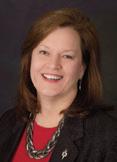
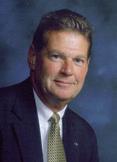
JILL PHILMON, CCM, CCE
GM/COO - BALLANTYNE COUNTRY CLUB
PCPS in my opinion is a must have if you are hiring a membership or marketing professional! We used them to place our current director and I was so impressed with the level of quality we were offered in candidates. We were equally impressed with how well they were able to match personalities to my current team, plus they even add in training to make sure they are fully prepared. We were extremely pleased with the outcome.
As a private club general manager with 30-years experience Professional Club Placement Services receives my highest recommendation. The dedicated industry professionals at PCPS seek first to understand your individual needs. Truly a customized approach, which results in candidates presented which meet the requirements you have established. The process is well devised and executed to exceptionally high standards.
PCPS understands the pain, stress, time, and money associated with posting ads, sorting through resumes, interviewing candidates and making decisions to fill an opening among your team, which is why our placement experts are fully committed to making this transition as smooth and professional as possible for you and your club

